Feed aggregator
Monday Musings: Here We Are

 We woke this morning to a snow squall, something that happened with ever-decreasing frequency during our years in Tennessee, as climate change made the warm South even warmer. Here in New York, during the winter months, snow is still the default when there’s precipitation, and I love that. I have missed snow and don’t mind paying the plow guy or dealing with snow on the walkways and driveway. The beauty of an early morning snowfall more than makes up for the inconveniences.
We woke this morning to a snow squall, something that happened with ever-decreasing frequency during our years in Tennessee, as climate change made the warm South even warmer. Here in New York, during the winter months, snow is still the default when there’s precipitation, and I love that. I have missed snow and don’t mind paying the plow guy or dealing with snow on the walkways and driveway. The beauty of an early morning snowfall more than makes up for the inconveniences.
We have bird feeders up now, and they’ve drawn in a variety of species, including several species of sparrow, goldfinches and cardinals, chickadees and nuthatches and woodpeckers. They have also drawn the attention of local hawks, who seem to view our feeders as an all-they-can-eat avian buffet. We have a Cooper’s Hawk who frequents the yard, a pair of Red-tails who come around quite often, and, as of yesterday, a gorgeous Red-shouldered Hawk. Our turkey flock continues to wander through the yard now and then, as does a beautiful red fox. A couple of weeks ago, while driving past the farm that borders our property on the western edge, I spotted a young Peregrine Falcon perched on a telephone pole, hungrily eyeing a flock of doves.
I haven’t written in this blog for a few weeks, and in a way what you’ve just read is why. I am working again, we have settled into a routine of sorts. The house still needs a good deal of work, and we’re getting around to that slowly, steadily. We are enjoying this setting immensely. We’re eating fun foods and finding new stuff to stream. We’re spending lots of time with my brother and his family, who live close by, and lots of time with my college roommate and musical partner and his wife, who also live maybe 20 minutes from here.
Life is comfortable and peaceful and, I will also admit, a tiny bit boring. Not to me, mind you, but I can definitely see where it could seem that way to those on the outside. We traveled a lot last year. This year we’re planning to (mostly) stay put and work on our new place. The past several years have been full and fraught, difficult beyond words at times, and at other times so frantic as to be exhausting. This year won’t be like that. Not if we can help it.
And so, yeah, I have struggled to post. I don’t want to bore. I don’t want to repeat material from old posts.
I continue to grieve for my older daughter. I’ll never stop. But I feel I have made that grief part of my life, part of who I am now, and honestly, I wouldn’t have it any other way. I don’t feel the same need to write about it that I felt last year. And I think many grew tired of such posts. Grief is part of me, but it does not — should not — define me.
I don’t really want to think about the slow-motion disaster unfolding in our nation’s capital. This administration’s attempts to subvert the Constitution and undo a century of progress on Civil Rights, environmental protection, social justice, and a host of other worthy goals is not something upon which I care to dwell. I am too weary to engage in online flame wars with troglodytes and nazis. At some point, I’ll grow angry enough to write a political screed or three, but not now.
And at some point, I am sure, I will have much to say about new writing projects. For now, though, I’m merely editing, and enjoying quiet, productive days in my new work space.
All of this feels healthy, and deeply appropriate for this current stage of my life. None of it makes for exciting reading (or writing). I will do my best to post as I can, to come up with things to say that make something worth reading out of our mundane-albeit-cozy existence. But to those who know us and care about us, please be assured that we are doing well. Better than we would have thought possible a little over a year ago. Some days are harder than others. But we are where we ought to be, physically and emotionally. It’s hard to ask for more.
Wishing all of you a wonderful week.
Spotlight on “Flux” by Jinwoo Chong
Flux is a New York Times Editor’s Choice, Best Book of 2023 by Esquire, Apple…
The post Spotlight on “Flux” by Jinwoo Chong appeared first on LitStack.
Monday Meows
Rocket launching Jeeves in 3.2.1.chomp…
This should be interesting.
I doubt it.
gznorkzzzzzzzzzz
When shall we three meet again? Or…wait, this is Macbeth, right?
Snippet – Caleb’s Tale
Prologue
From: A History of Northern Continent Education. Markus Adams (Certified Wizard).
There is no agreement, in the annuals of magical education, of just which magical school was the first to be founded. Academics argue constantly over whether or not Whitehall, Mountaintop, Golden (lost in the blighted lands) or even Heart’s Eye came first, setting an example that inspired the remaining first generation of schools. Even for the schools for which we have detailed and accurate historical records, such as Laughter or Stronghold, there are a great many questions that remain unanswered. It is difficult to trace the development of magical education, or to trace the thinking that led to communal schools. Far too many historical records have simply been lost or deliberately destroyed.
One thing that is clear, however, is that the development of magical schools led to clashes with wizards who followed the apprenticeship system. A wizard who had a number of apprentices, who in turn raised apprentices of their own, stood at the top of a hierarchy that was tilted in their favour, giving them power and prestige they were loathe to lose. The clear flaws of the system – senior wizards had considerable power over their juniors, some magicians never receive proper training at all – did not disabuse them of their determination to keep the system in place. Indeed, many junior apprentices preferred to keep it because eventually they would rise to become seniors themselves. The idea of a generalist magical education, which would give all comers the same basic knowledge, was understandably terrifying. It would not only limit the number of apprentices willing to devote their lives to a singular subject, but also ensure the apprentices knew their rights when they were accepted by a master. It should come as no surprise, therefore, that the masters and many of their apprentices waged war on the concept of universal magical education. Historical records are vague, but it appears that several schools were in fact destroyed over the first century of magical education and Whitehall itself came very close to being destroyed too.
The events that led to the compromise that ended the dispute remain unclear, but eventually a compromise was reached. The schools would give everyone the same basic grounding, yet also serve as a recruiting ground for masters in search of apprentices. Students who did well would be offered a chance of further education, focused on a particular subject. In many ways, the compromise appeared perfect. The new students would know, beyond a shadow of a doubt, which subject they intended to specialise in, ensuring they could reach out to the masters best suited to educate them.
However, the compromise was also deeply flawed. There were far more apprentices than there were masters. Many students could not get the focused education they wanted, let alone the qualifications they needed to practice themselves. There was also no way to study multiple subjects after they left school, let alone conduct the studies on their own timetable. Indeed, after several decades development, it became clear that the master-apprentice relationship/hierarchy remained unchanged. The discontent this sparked, by contrast, remained unfocused. No one with the power to do so was interested in rocking the boat, let alone founding an institute of further education.
It was not until Lady Emily arrived on the scene that dreams of a university started to take shape and form. Lady Emily not only had the wealth and prestige to found an institution, but also largely unquestioned possession of Heart’s Eye, a school that was occupied by a necromancer and eventually liberated by Emily herself. Gathering a handful of friends and supporters around her, ironically in the months between her departure from Whitehall and her apprenticeship with Void, she set out to found a university.
She did not find it an easy task. The necromancer had left surprises behind in the rubble, surprises that came very close to destroying the entire university. Many of her allies had ambitions of their own, from the former students of Heart’s Eye to believed the school belonged to them to others who had dreams of power without restraint, and it is greatly to her credit that by the time she left the university under the control of Administrator Irene, and Deputy Administrator Caleb, the institution rested on fairly solid ground, and stood ready to receive the first collection of prospective teachers and students.
Naturally, matters did not go as smoothly as many had hoped.
Chapter One
Caleb stood on the podium and looked down at the audience, trying not to groan.
He had always known it would be difficult to attract top talent to Heart’s Eye, to the university Emily and he had planned over the last few years. Long planning sessions – his heart twisted at the memory of what had followed those sessions – had led to concepts that looked great on paper, yet were frustratingly hard to turn into something real. The vast majority of younger students went to the older magical schools, while the older and freshly graduated magicians tended to look for a master, so they could specialise in their chosen subject. It was never easy to find a master at the best of times, and it grew harder as the prospective apprentice grew older. There was no escaping the simple fact that the first students attending the university wouldn’t be the cream of the crop. They would keep going to masters until the university proved itself.
Caleb knew, without false modesty, that he had always been a dilettante. He hadn’t been interested in a single subject so much as he had been interested in them all, reading around magical topics in greater depth than they were covered at either Stronghold or Whitehall, if they were covered at all. It had made him something of a dabbler, and he’d said as much to Emily, but he’d learnt a great deal through combining the different magical fields into one. There was no inherent reason why a student couldn’t study both alchemy and enchantment, or construction and a dozen other subjects. The divide between them owed more to masters demanding their apprentices specialise in their fields, rather than studying magic itself. It was a two-edged sword, Caleb had often thought, although few agreed with him. The apprentice who became a master might be an expert in their field, but they rarely knew more than the basics of any other field. It was no surprise, not to him, that the different guilds treated each other with barely-hidden disdain, even when they were supposed to be united against a common enemy. There were feuds that went back hundreds of years, originating so far back that no one truly knew what had started them. No wonder cooperation was impossible.
He kept his face as blank as possible as he surveyed the newcomers. A handful of older masters, whose ambitions had outstripped their talents; a cluster of apprentices, some taught the basics at school and others largely self-taught, or taken into their master’s household years before their time. It was technically frowned upon to take on an apprentice who hadn’t had at least four years of generalist education under his belt, but like so many other magical customs it lacked an enforcement mechanism. They were flanked by a handful of young magicians who had the spark, but lacked the money or connections to attend a proper school, and a cluster of apprentice craftsmen, printers and engineers, lacking in magic but deeply steeped in the New Learning. It wasn’t going to be easy to keep them from leaving, Caleb reflected, when they realised how dangerous it could be for a mundane in a school of magicians. Emily had laid down the law, and he intended to enforce it, but it was just a matter of time until someone challenged him. The hell of it was that the challenge might not even be deliberate. Too many magicians saw a mundane in their territory as someone who was being uppity, someone who needed to be taught a lesson. But that rule didn’t apply here.
His eyes lingered briefly on a redheaded young woman, her pretty face set in a scowl that made her look like an overgrown child, and winced inwardly. She was here because of politics … and she didn’t want to be. A handful of aristocratic youths stood near her, looking so absurdly self-confident and entitled that it was hard not to feel a flicker of the old resentment and hatred. They thought the world owed them everything, but if that were true they wouldn’t be attending Heart’s Eye. The new tutors standing at the rear, by contrast, looked worried. They knew they weren’t good enough to get tenure at any other magical institution. Heart’s Eye was their last chance to be something more than independent teachers, moving from city to city and student to student. He hoped they’d be reasonable. Too many magicians were decidedly unreasonable.
He tried to see the hall through their eyes, feeling his heart sink still further. The famed mirrors were gone, some shattered and others removed, and the plain stone walls had been left largely unadorned, save for a handful of portraits of research wizards. The chamber had been swept repeatedly, but there was still a hint of dust in the air. He wondered what the newcomers were thinking, as they waited for him to speak. The events of the last few months, the crisis that had come very close to destroying the university and so much more, felt hazy and dreamlike even to him – and he had lived through it. Others seemed to have forgotten it completely, as if the whole affair had been so far out of their context that they refused to acknowledge it had happened. It was hard to blame them.
Caleb was not good at public speaking. He disliked it profoundly. But he was the Deputy Administrator and it was his duty.
“Welcome to Heart’s Eye,” he said, simply. “This is not a school. This is not a master’s workshop. This is not an institution focused on any one topic, magical or mundane. This is a university. Our goal is to allow students to study multiple subjects at once, be they magic or science, in hopes of expanding the sum total of human knowledge and developing newer and better ways to do things. We are gathering experts in every subject and students who are willing to learn, in the hope of creating a melting pot of knowledge. You may find it strange, if you have spent your early lives or careers in one of the schools or served an apprenticeship under a master before taking apprentices of your own, but we hope you will find it interesting as well as educational.”
He paused. “You’ll notice that a great many of our arrangements are fluid. We have no intention of slavishly copying tradition, at least when there is no clear reason for a given tradition to exist, and our willingness to keep any traditions is entirely dependent on their value and practicality. If one tradition is worthless, we will discard it; if it serves a valuable purpose, we will keep it. You may find it hard to grow accustomed to such changes, and to understand the importance of adapting to the ever-changing world, but we believe that there is no way change can be prevented forever. We aim to surf the waves of change, rather than letting them destroy us.
“In this place, titles don’t matter. Wealth doesn’t matter. Magical power or training doesn’t matter. We will not give you favour because your father is the King of Blank or your mother is the Grand High Witch of Somewhere. We will not look down on you because your father is a mystery, or your mother was a scullery maid; we will certainly not look down on you because you barely have enough magic to boil water, or don’t have magic at all. You will have the opportunities to learn from the tutors, regardless of your origins, and the opportunities to make use of what you learn.
“That said, this is not a school. You will not be scolded for being late to class. You will not be caned for handing your homework in late, or not at all. You will not be expelled for failing your end-of-year exams. We offer you – all of you – equal opportunities. We do not promise equal outcomes. That would be silly. We offer you these opportunities, but what you make of them is up to you. If you study hard, read around your subjects and practice what you’re taught, you will do well. If you never attend class, and spend all your days drinking and carousing in Heart’s Ease, you will do poorly. You will not graduate. You will do nothing with your lives.
“And it will all be your fault.”
He paused again, letting the words hang in the air.
“There are few rules here, but they do exist. You may not bully or assault other students. You may not disrupt class or impede the education of other students. You may not use your birth or power or both to put someone else down. You may not continue old feuds here. If you have problems with other students, we expect you to handle them maturity; if you have issues with your tutors, we expect you to bring them to the university board. If you are caught breaking these rules, there will be consequences. You will not enjoy them.
“I don’t expect you to like or love your peers, or your tutors. But I do expect you to treat them with respect.”
His eyes surveyed the newcomers again. Some looked pleased, others looked sullen. The red-haired girl managed to look both bored and irked at the same time. The tutors were far more practiced at hiding their emotions. Caleb hoped that didn’t mean they’d be trouble. A single poisonous tutor could do more damage than a dozen entitled aristocratic brats. He wondered, idly, how many would stay, when they realised their qualifications wouldn’t guarantee them tenure. Emily had been very set against any sort of permanent tenure, for reasons Caleb knew the tutors would not approve. The harder it was to sack any offending tutor, the greater the chance one would offend.
“If you want to leave at any moment, the door is over there,” he finished, pointing to the rear door. “If not … I hope you enjoy your time here, and that it benefits both you and our newborn university. The student assistants waiting in the next room will show you to your dorms and bedchambers, if you have any issues they can’t handle ask a tutor. Dismissed.”
A ripple ran through the air as he stepped off the podium, the majority of the students heading towards the next room. Caleb hoped they wouldn’t cause too many problems with the student volunteers, as they struggled to get used to the dorms. Whitehall didn’t have dorms, he knew, and Mountaintop segregated its students by birth as well as sex. He wondered how long it would be until he heard the first complaint about the lack of private bedrooms, or demands to know why magicians had to share space with mundanes. Probably not very long, if he was any judge. He knew better than to believe mundanes were dirty and smelly brutes who couldn’t count past ten without taking off their pants – and uncouth enough to do it too – because his father was a mundane, but he’d heard magicians say just that and worse too.
Of course they do, his mother had said, years ago. They’re not smart. They’re not talented. The only thing that sets them apart from the mundanes is magic – and they don’t even have much of that. They put the mundanes down because they know, deep inside, that the only thing that separates them from the mundanes is magic – and without magic, they’d be no better than those they hate.
The red-haired girl stalked past him with nary a nod, her face set in a pinched line as she left the room. A handful of young men followed, no doubt intending to try to chat her up. Caleb suspected it wouldn’t go very well, not for them. The girl was a member of a high-ranking family and her would-be suitors were trying too hard, the very finery of their clothes suggesting they weren’t that high-born at all. And the very fact they were in the university was proof they didn’t have their pick of masters …
“You’re Caleb, Son of Sienna,” a student said. He shoved out a hand. “I’m Parson, of House Garland.”
Caleb hid his annoyance with an effort. His extended family hadn’t been too pleased about his mother’s choice of husbands, although they’d been reluctant to take the final step of actually disowning her if she refused to give up her partner and return home. Lucky for them they hadn’t, Caleb reflected. His parents had five children who were handsome, talented, and very strong in magic. His brother had died bravely, facing a necromancer, but the rest of his siblings were powerful assets. House Waterfall had to be glad they hadn’t disowned their wayward child. Her decision had worked out very well for her family.
“Pleased to meet you,” Caleb said. Parson was a little too handsome, a little too overdressed for his role. His handshake was very firm, disturbingly so. Caleb’s father had once noted that the more someone played up his honesty and openness, the more alarmed you should be … Caleb wished, not for the first time, that he’d listened more to his father as a child. “Welcome to Heart’s Eye.”
Parson smiled. “Is it true that you and Lady Emily are secretly married? And that you were given this post as a wedding gift?”
Caleb felt a hot flash of anger. He’d been dreaming of a university – or at least something along those lines – well before he’d known Emily as anything other than a name, let alone a friend and a lover. Their break-up had hurt, and he was honest enough to admit it had been partly his fault, but they’d managed to remain friends and stay in touch, eventually working together to lay the groundwork for a university. The idea that he was nothing more than Emily’s lover was not only insulting, but wrong. It was just frustrating to have people think of him as nothing more than a bit character in her life.
“No,” he said, flatly. “Lady Emily and myself, and a handful of others, devised the university and worked to put it into practice. I have this post because it is my responsibility to make the university work.”
Another student joined them, wearing the livery of a formally-acknowledged bastard. “Why didn’t Mistress Irene greet us?”
“Administrator Irene is currently dealing with a more important problem,” Caleb said. “The university is very new, as you know, and a great many issues were simply not recognised as problems until they came into the light. We are learning through doing here, and …”
Parson frowned. “We are high-ranking students,” he interrupted. “Should we not be welcomed by …”
Caleb met his eyes. It was hard to keep the irritation out of his voice. “There are no ranks and titles here. I told you that. If you are mortally insulted because Mistress Irene did not leave a problem to fester so she could greet you, you may leave at any moment. If not, I suggest you concentrate on your studies. We have a lot of work to do.”
He waited, wondering what Parson would say. Parson bowed instead and headed for the door, surrounded by a handful of other wealthy or well-connected brats. Caleb was sure he was going to be trouble. Some aristos got knocked down hard and learnt from the experience, growing into better people; others, he reflected coldly, didn’t get knocked down until they were too set in their ways to change. He made a mental note to look into Parson’s history. With that sort of attitude, it was very likely he’d never been to Whitehall. Or Stronghold.
“I thank you for your offer of employment,” an older man said. He bowed rather than holding out a hand. “Master Ballymore, at your service.”
Caleb bowed back, studying Ballymore thoughtfully. He was a short slender man, with a ratty face and a weedy little moustache that looked somehow wrong, as if it shouldn’t be there at all. He wore the outfit of a travelling tutor, but there was something about his attitude that suggested he was always one missed payment away from total disaster, a sense of quiet desperation that poisoned the air around him. Caleb tried not to show his concern. The contrast between Ballymore and the confident tutors he’d known at Whitehall could not be greater. If he hadn’t been able to find a permanent post …
It doesn’t prove anything, Caleb reminded himself. There were more candidates than there were posts. If someone could only find work by travelling from place to place, teaching a handful of students the basics and then moving on when their students went to school, it didn’t mean they were bad tutors. There hadn’t been any reason to worry about them, when references were checked. For all I know, this guy needs some stability to flourish.
“You are welcome,” he said, finally. “I hope you will do well here.”
“I will,” Ballymore promised. “My students always do well in their exams.”
Caleb nodded, curtly, as Ballymore hurried away. Exams weren’t everything, but they were a good indicator of a student’s capabilities. It had taken weeks of arguing to get Heart’s Eye accredited to offer the standard exams, let alone their more advanced counterparts, and the White Council wasn’t entirely happy with the arrangement. A failure now, even a relatively minor one, could cost the university the right to offer exams, which would cripple its future development and make it impossible to recruit the best students and teachers. And that would be disastrous.
He spoke briefly to the other tutors, trying to avoid the sense they were scraping the bottom of the barrel. It wasn’t easy. A couple appeared competent, and willing to believe in the university’s stated goals, but others were far less suitable. One was clearly reluctant to take orders from a young man who had been a student himself a couple of years ago. Another looked ready to leave at the slightest provocation. But they were all he had. They would have to do.
Give us five years and we’ll be solidly established, he told himself. And then we’ll be well on the way.
Sure, his thoughts countered, expressing doubts he dared not admit openly. Not yet. And if these tutors aren’t up to the task, they’ll take the rest of us down with them.
Looking Back at RTS – and Myth: The Fallen Lords
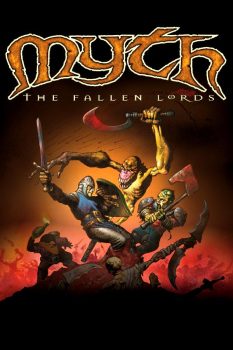 So….one of the rabbit holes I periodically jump down is Total War: Warhammer II. That’s easily my favorite in the Total War series (I played a boatload of TW: I as well. You can use units from I, in II, in some campaigns, which increases the utility of the first game. I appreciate that.
So….one of the rabbit holes I periodically jump down is Total War: Warhammer II. That’s easily my favorite in the Total War series (I played a boatload of TW: I as well. You can use units from I, in II, in some campaigns, which increases the utility of the first game. I appreciate that.
I struggle with the first 15-or-so turns, and frequently abandon a new game, pick another faction, and try again. I like playing different factions, so that’s fine. Also, I often plateau around 70-75 turns, and start a new game as well.
I reinstalled TW: I and II last month and have been playing again. It’s been fun. After a half-dozen false starts, I’m having one of my most successful games leading a chivalry-based, Middle Ages-type faction (WH is a fantasy world, with elves, orcs, beastmen, etc). And I realized I was applying the principles that George Washington advised America about in his famous Farewell Address. Being a Constitutional Convention of 1787 wonk, I’m reasonably familiar with Washington, who presided over the Convention.
However, as I type this right now, it is obvious that such a post is definitely not gonna be ready for tomorrow morning (which would be when this one went live – Monday the 3rd.
And let met tell you, there are multiple elements of Washington’s Address that apply today. Including about people in the country undermining it by pitting one group against another. And that applies to quite a few groups/people…
So instead, we’re talking about a few Real Time Strategy (RTS) games I’ve played over the years. The basic definition of RTS is games that don’t move forward incrementally in turns, but move along in ‘real time.’
The old Warcraft: Orcs and Humans was the first one I really got into, way back in the mid-nineties, which was the birth era of RTS. I never played World of Warcraft, but I ate up the first two Warcraft games (Starcraft followed, and was also immensely popular, but I never tried that one).
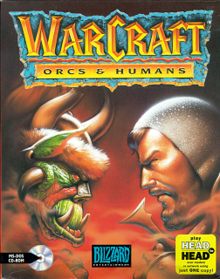 I think I played Command and Conquer for a very short time, but I don’t really remember that. It was kind of a high point of that style of RTS.
I think I played Command and Conquer for a very short time, but I don’t really remember that. It was kind of a high point of that style of RTS.
Age of Empires came along a few years later, and I played the heck out of that, as well as Age of Empires II. Both got rehabs and updates, and AoE II is totally playable. A buddy of mine is still addicted to the new version. AoE II is a classic which is still growing.
A few years ago, my son and I played a LOT of Star Wars: Empire at War, which came out in 2006. It swapped out resource gathering with a point-of-control system. It is a ton of fun.
For a Tolkien fan, Battle for Middle Earth I was fantastic. I didn’t play II, which I’ve heard was even better. It is possible to find an updated version of II that runs on modern Windows, but I haven’t managed to make that happen. Might really dial in on it sometime, and try. I was REALLY good for Tolkien fans.
There was a decent-enough D&D knock-off version, Dragonshard, in 2005. It mixed in a bit more RPG elements. I played it some, but Battle for Middle Earth was definitely superior.
Sid Meier is possibly the greatest game-creator of all time, with Civilization one of the most influential and popular games ever. His first game after leaving MicroProse was Sid Meier’s Gettysburg!, and it is a terrific Civil War game. You need to be totally immersed in it, but it’s a great Civil War game. Sid Meier’s Antietam! was similar.
And Railroad Tycoon was the standard railroad sim for a long time. 2018’s Railway Empire was a blast, and I have played that a fair amount.
I think it’s definitely cool that RTS is not limited to combat games (there are RTS World War games as well – I’ve only dabbled in those). Tropico, and Sim City, are two examples of RTS-type city-building games. I played a LOT of the first Tropico – that’s a fun game.
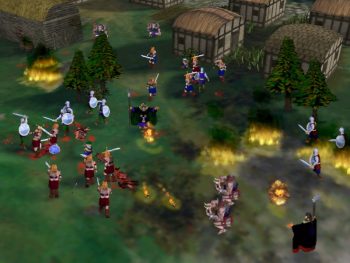 The only game that rivals TW:WH II for me, came out WAAAY back in 1997. Man, how can that be almost 30 years ago? I feel really old. But Bungie’s Myth: The Fallen Lords, was a terrific achievement. Story and game-play: just the EXPERIENCE.
The only game that rivals TW:WH II for me, came out WAAAY back in 1997. Man, how can that be almost 30 years ago? I feel really old. But Bungie’s Myth: The Fallen Lords, was a terrific achievement. Story and game-play: just the EXPERIENCE.
The land has fallen under almost total control of the forces of light (The Fallen Lords), led by Balor. The Light is led by powerful sorcerers, and you control an elite army unit called The Legion. You need to overcome The Fallen Lords. The developers cited Mel Gibson’s Braveheart, and Glen Cook’s fantastic The Black Company (you surely read my interview with him, here), as inspirations.
It is actually an RTT (Real Time Tactical) game. No resource gathering, no settlement growing. You don’t develop skill trees and build up unit strength. You start each scenario with your force fully ready to go.
It was essentially a unit-based combat game (NOT turn-based). But playing it still felt like a combat-based RTS, back then. Terrain and weather impacted things, which was neat at the time. You controlled units (usually in groups) to win battles. And no game I ever played had friendly fire as such a part of it. Those dwarven Molotov cocktails could take out your own forces.
Project Magma has converted the game to operate on current Windows systems. If I could focus in on it, I would probably go through the multiple steps and play this again. But TW: WH I, and II, are already installed, ready to play, and twenty years newer. Still, Myth Lords is one I’m tempted to try.
There was a sequel, and a prequel. But that original game is a masterpiece.

Bob Byrne’s ‘A (Black) Gat in the Hand’ made its Black Gate debut in 2018 and has returned every summer since.
His ‘The Public Life of Sherlock Holmes’ column ran every Monday morning at Black Gate from March, 2014 through March, 2017. And he irregularly posts on Rex Stout’s gargantuan detective in ‘Nero Wolfe’s Brownstone.’ He is a member of the Praed Street Irregulars, founded www.SolarPons.com (the only website dedicated to the ‘Sherlock Holmes of Praed Street’).
He organized Black Gate’s award-nominated ‘Discovering Robert E. Howard’ series, as well as the award-winning ‘Hither Came Conan’ series. Which is now part of THE Definitive guide to Conan. He also organized 2023’s ‘Talking Tolkien.’
He has contributed stories to The MX Book of New Sherlock Holmes Stories — Parts III, IV, V, VI, XXI, and XXXIII.
He has written introductions for Steeger Books, and appeared in several magazines, including Black Mask, Sherlock Holmes Mystery Magazine, The Strand Magazine, and Sherlock Magazine.
Book review: The Devil By Name by Keith Rosson (Fever House #2)

ABOUT THE AUTHOR: Keith Rosson is the author of the novels The Mercy of the Tide and Smoke City, and his short fiction has appeared in Cream City Review, PANK, December, The Nervous Breakdown, and more. He's been twice nominated for a Pushcart Prize and a finalist for the Birdwhistle Prize for Short Fiction. He’s also an illustrator and graphic designer, with clients that include Green Day, Against Me, the Goo Goo Dolls, and others. A fierce advocate of public libraries and non-ironic adulation of the cassette tape, he can be found at keithrosson.com.
Publisher: Random House (September 10, 2024) Length: 400 pages Formats: audiobook, ebook, paperback
The Devil by Name picks up five years after Fever House with all the chaos, gore, and gripping drama you’d expect—and then some. The world is still reeling from “The Message,” a weaponized sound that turned much of humanity into bloodthirsty monsters called the fevered. With Terradyne Industries running the show and humanity clinging to survival, the stakes have never been higher.
The book is a wild ride; it takes elements of horror, noir, and spy thriller vibes and turns them into a splatterfest that somehow still manages to be emotionally grounded. John Bonner, riddled with guilt and desperate for redemption, Katherine Moriarty, coping with devastating loss, and Naomi Laurent, a teenager with a mysterious, world-altering gift, are all struggling. Newcomer Dean Haggerty, a warm, resourceful scavenger, is an unexpected bright spot, bringing a glimmer of hope to a grim story.
Yes, the gore is intense, and the body horror will stick with you long after you’ve turned the last page (looking at you, “tortured fevered in the chair”). But here’s the thing - Rosson knows how to find a balance between the carnage and emotional depth, and his take on grief, redemption, and survival feels raw and real. The character arcs are top-notch, with even minor players leaving a mark. Katherine’s transformation, in particular, is spectacular.
The pacing is relentless, and while some plot conveniences (a possible cure-all across the ocean, for example) might raise an eyebrow, the story’s intensity and emotional pull make it easy to forgive. Rosson ties up loose ends from Fever House while introducing fresh twists, taking the story in surprising directions.
The final chapters are pure nightmare fuel, and the emotional punches hit hard. If you’re into stories that mix terror, heart, and a touch of hope, The Devil by Name delivers big time. It’s the kind of book that leaves you a little haunted but entirely satisfied.
Snake Eyes by Mark Henwick
Urban Fantasy
This is book 8 in the Amber Farrell / Bite Back series. To start at the beginning read the novella Raw Deal or Book 1, Sleight of Hand.

The first four of five books in the series were very much about discovery. Amber Farrell who is vampire, werewolf and witch was learning who she was. All the while battling the bad guys and each supernatural community where she was considered an abomination.
The more recent books have been about joining her separate parts, I guess “becoming” is a good word. And the last couple of books, Queen of Diamonds and Snake Eyes (essentially one book broken into two parts) seem to me to be her arriving at who she is.
This series is honestly one of the best. If you look at the books I read, you’ll notice 90% plus are written by women. Mark Henwick is one of a handful of male authors I read and reread. I’ve probably read most of the books in this series a dozen times. So if you love Urban Fantasy, do yourself a favour. Read Amber Farrell.
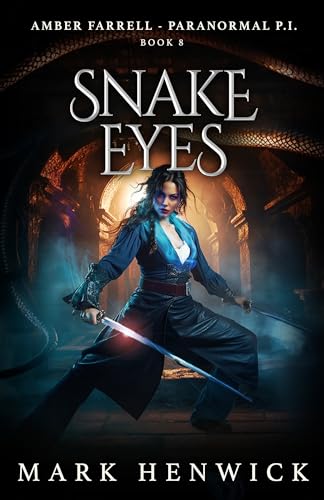
Audiobook Review: Tartufo by Kira Jane Buxton
I received a review copy from the publisher. This does not affect the contents of my review and all opinions are my own.
Mogsy’s Rating (Overall): 3.5 of 5 stars
Genre: Contemporary, Humor
Series: Stand Alone
Publisher: Hachette Audio (January 28, 2025)
Length: 11 hrs and 31 mins
AuthorInformation: Website | Twitter
Narrator: Caroline Hewitt
After thoroughly enjoying Kira Jane Buxton’s Hollow Kingdom series, I was looking forward to checking out Tartufo even though her newest novel falls outside my usual genres. I was mainly curious to see how her quirky sense of humor would transfer to a different kind of story, and while Tartufo does indeed take a more grounded approach, it still carries the author’s signature charm. Still, despite its playfulness and whimsy, the novel didn’t quite capture me in the same way as her previous work.
Set in the small, fictional Italian village of Lazzarini Boscarino, Tartufo tells the tale of a group of residents who will do anything to keep their dying town on the map. With most of the younger generation having departed for greener pastures in the big cities, the remaining aging population is left to hold what’s left of their beloved home together. But the crisis deepens as it is revealed that the previous mayor had died without leaving any available funds for rebuilding and revitalizing. Now his daughter Delizia returns home to handle his affairs only to find herself elected as the new mayor—after nearly losing the race to a donkey—with the unenviable task of turning things around, all the while struggling with her own personal ambitions and disappointments.
Then one day, a local truffle hunter named Giovanni heads out into the forest with his dogs, doing what he loves most, when he suddenly stumbles upon an enormous truffle—quite possibly the largest specimen the world has ever seen. Realizing its potential, Giovanni brings it to the rest of the village, hoping it’s exactly what they need to bring attention back to Lazzarini Boscarino. However, what begins as a stroke of extraordinary luck soon spirals out of control as the attention the town receives also includes that of the negative variety, motivated by enmity and greed. Instead of bringing the community together, the discovery of the truffle threatens do the exactly opposite, forcing everyone to question what future they want for their town.
If you’re looking for some casual reading or a book to sit back and relax with, Tartufo is the perfect choice—relatively low stakes, brimming with charm and wit. For me, it felt a lot like watching a lighthearted musical. The human characters are oddballs, with some portrayals leaning into satire and caricature, filling the cast with over-the-top personalities that wouldn’t feel too out of place in a stage comedy. The novel is also a treat for the senses. Descriptive writing is dialed up to the max, painting a gorgeously evocative picture of the setting. The Italian countryside is described so vividly you can practically smell the delicious scent of food and wine in the restaurants and feel the warmth under the Mediterranean sun. The village of Lazzarini Boscarino is itself as much a character as its eccentric inhabitants, written with the same amount of care and detail.
Buxton has also chosen to tell this story in an omniscient point of view, a brilliant decision which allowed her to do something that has become part of her signature style—writing from the perspective of animals. Inserted between character POVs are scenes told through the eyes of creatures like Giovanni’s truffle-hunting dog, a cat named Al Pacino (despite it being female), and even a passing honeybee. Not only is it reminiscent of the Hollow Kingdom series, which was told through the eyes of a very clever crow, it’s a quirk of the writing which adds an unexpected layer of depth to the story.
Despite the whimsical nature of Tartufo, there’s a distinct lack of supernatural elements, though that alone didn’t take away from my enjoyment. More challenging was the way the narrative juggles so many different POVs, leaving some important characters underdeveloped. It’s also a little too silly in places, making it harder for me to fully immerse myself in the conflict, and there were moments where I wished for more emotional depth.
Nevertheless, Tartufo remains a delightful read, showcasing Kira Jane Buxton’s storytelling abilities. While the playful tone occasionally goes overboard with it and becomes tiresome, on the whole the book is entertaining and endearing. At its heart, it’s a story about togetherness and the dreams of a community, and though I didn’t connect with it as deeply as the author’s Hollow Kingdom, I still had a good time with its humor and themes.
![]()
![]()
The Fiction of Edgar Rice Burroughs, Part II: Tarzan and The Land That Time Forgot
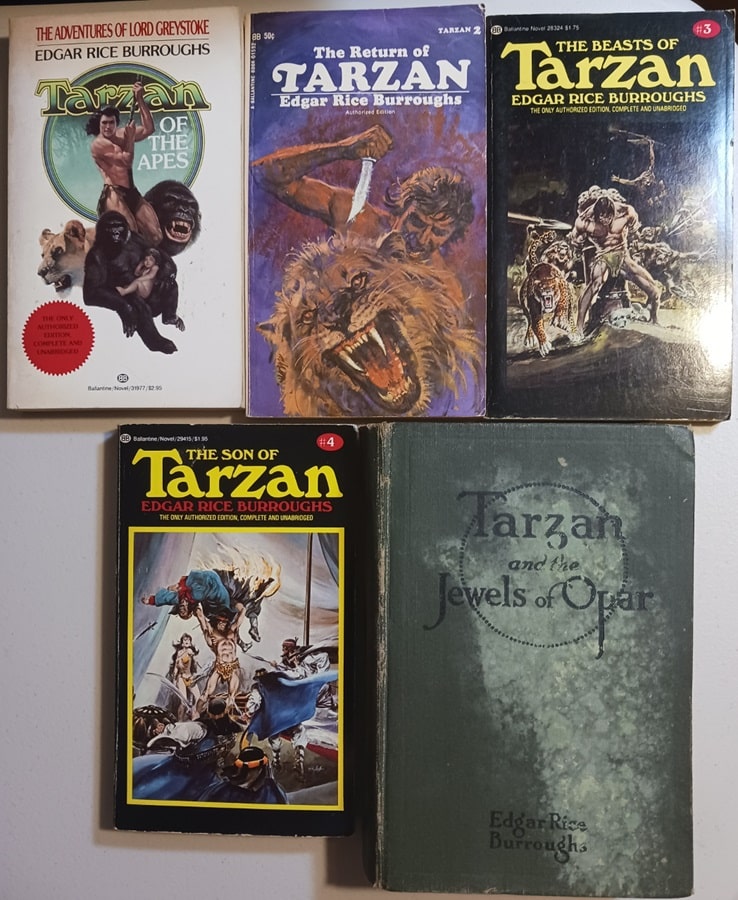 Tarzan novels #1 – #5 : Tarzan of the Apes, The Return of Tarzan, The Beasts of Tarzan, and The Son of Tarzan (Ballantine Books, December 1983, April 1969, April 1975, April 1975), and Tarzan and the Jewels of Opar (A.L. Burt, 1919). Covers by Charles Ren, Bob Abbett, Neal Adams, and Neal Adams.
Tarzan novels #1 – #5 : Tarzan of the Apes, The Return of Tarzan, The Beasts of Tarzan, and The Son of Tarzan (Ballantine Books, December 1983, April 1969, April 1975, April 1975), and Tarzan and the Jewels of Opar (A.L. Burt, 1919). Covers by Charles Ren, Bob Abbett, Neal Adams, and Neal Adams.
Any discussion of Sword & Planet fiction needs to start with Edgar Rice Burroughs and his book A Princess of Mars. I discussed that series extensively — and also his other S&P series, the Carson of Venus books, and his Moon Maid trilogy, which is partially S&P — in Part I of this series.
But, of course, ERB wrote many other books that have no connection to S&P fiction. They are still very good stories, though, entertaining and worth discussing. I thought I’d cover some in my next series of posts.
Most readers I know discovered ERB through the character of Tarzan. The first ERB I read was A Princess of Mars, but the second one was Tarzan Lord of the Jungle. The book was an old hardback, with no dust cover. The cover was generally brown with the title embossed on it. I found it among my sister’s books. She was the only other big reader in my family. I don’t know how she came upon it. I still remember some fifty+ years later the opening scene, with Tarzan dozing on the back of Tantor the elephant. And before long Tarzan finds a lost civilization of crusaders in deepest Africa. And there was swashbuckling.
[Click the images for Tarzan-sized versions.]
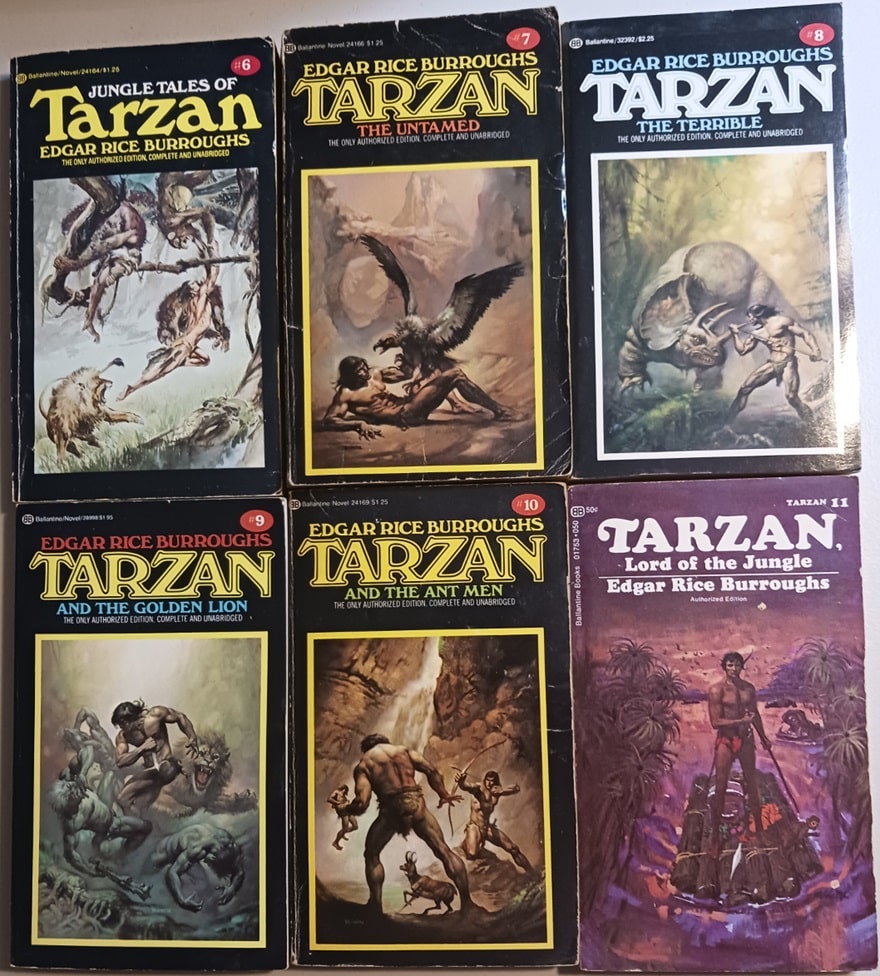 Tarzan #6 – #11: Jungle Tales of Tarzan, Tarzan the Untamed, Tarzan the Terrible, Tarzan and the Golden Lion, Tarzan and the Ant Men, and Tarzan, Lord of the Jungle (Ballantine Books, 1975-1976, and 1969). Covers by Neal Adams, Boris Vallejo, and Bob Abbett.
Tarzan #6 – #11: Jungle Tales of Tarzan, Tarzan the Untamed, Tarzan the Terrible, Tarzan and the Golden Lion, Tarzan and the Ant Men, and Tarzan, Lord of the Jungle (Ballantine Books, 1975-1976, and 1969). Covers by Neal Adams, Boris Vallejo, and Bob Abbett.
I’ve always liked best the Tarzan tales where he discovers a lost race. There were a lot of them in Africa, apparently. That copy of the book fell apart and I eventually replaced it with a paperback. When I started buying the Tarzan books I couldn’t afford to get them all at once, and I also picked up ones here and there from used bookstores or book sales. Most of the ones I found were from the Ballantine editions, many with great Boris Vallejo covers, which became my “mind’s eye” image of Tarzan.
Above I show the first 11 books in my collection. All but Jewels of Opar are from Ballantine, published between 1963 and 1973 it looks like. Covers are varied.
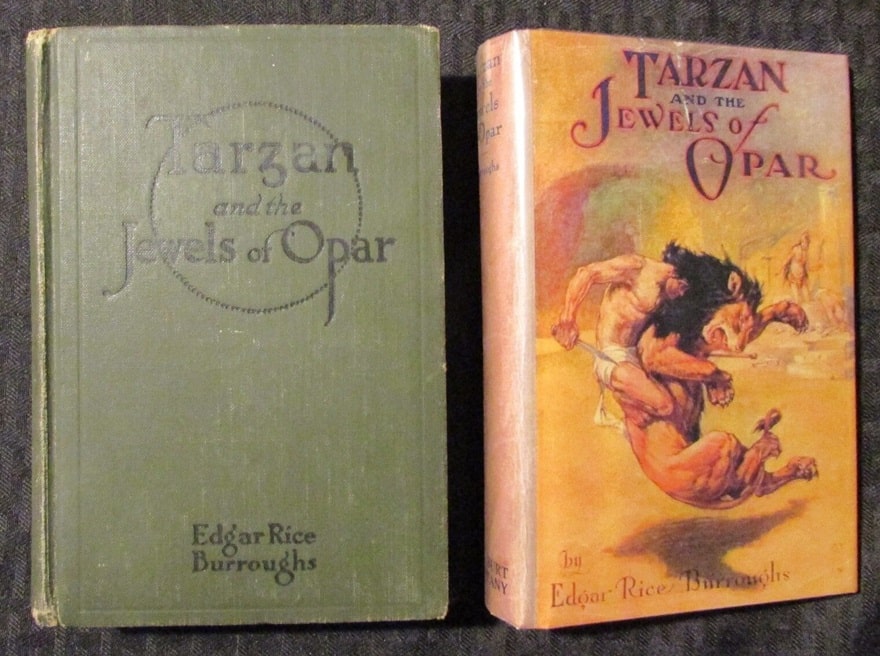 Tarzan and the Jewels of Opar (A.L. Burt Company, 1919). Cover by J. Allen St. John
Tarzan and the Jewels of Opar (A.L. Burt Company, 1919). Cover by J. Allen St. John
Here’s the list of cover artists.
Tarzan of the Apes; Charles Ren
The Return of Tarzan; Robert Abbett
Beasts of, Son of, Jungle Tales of; Neal Adams
Untamed, Terrible, Golden Lion, Ant Men; Boris Vallejo
Lord of the Jungle; Robert Abbett
My copy of Tarzan and the Jewels of Opar was published in 1919 by A. L. Burt Company. It lacks a dust cover, but above is a picture I took off the internet of what it apparently looked like. The beautiful cover is by J. Allen St. John (1872 – 1957), who was an incredible artist.
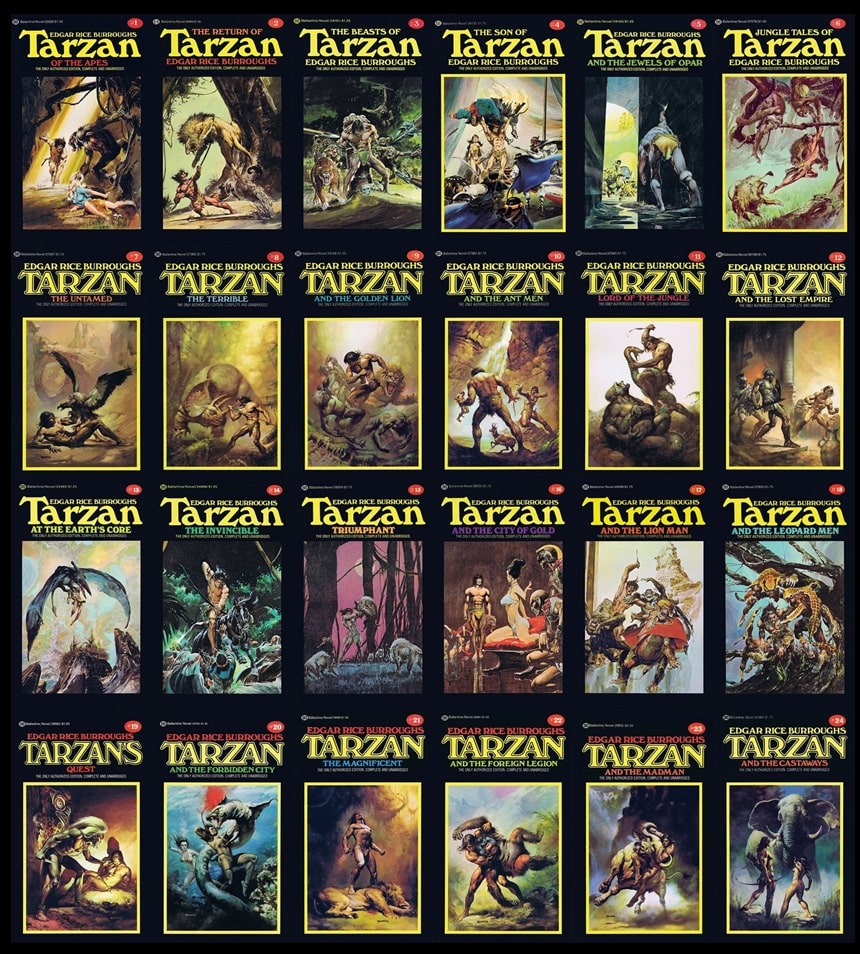 The 24 Tarzan novels and collections published in sequence in paperback by Ballantine Books, 1975 – 1977. Covers by Neal Adams and Boris Vallejo
The 24 Tarzan novels and collections published in sequence in paperback by Ballantine Books, 1975 – 1977. Covers by Neal Adams and Boris Vallejo
Burroughs wrote 26 books about Tarzan, but typically only 24 are counted as part of the main sequence. The two odd numbers out are The Tarzan Twins, which I have, and Tarzan and the Tarzan Twins with Jad-Bal-Ja The Golden Lion, which I’ve never seen. These are novellas written for young readers. They were published separately but were collected together at one point, although I can’t find a copy of that publication.
The copy of The Tarzan Twins that I have is from Wildside Press with a cover by Douglas Grant. It’s the only ERB book I don’t like and doesn’t even seem like ERB to me. ERB’s work was already accessible to young readers. Most people I know read them pretty young, so for him to “try” to write down to kids just didn’t work — at least to me.
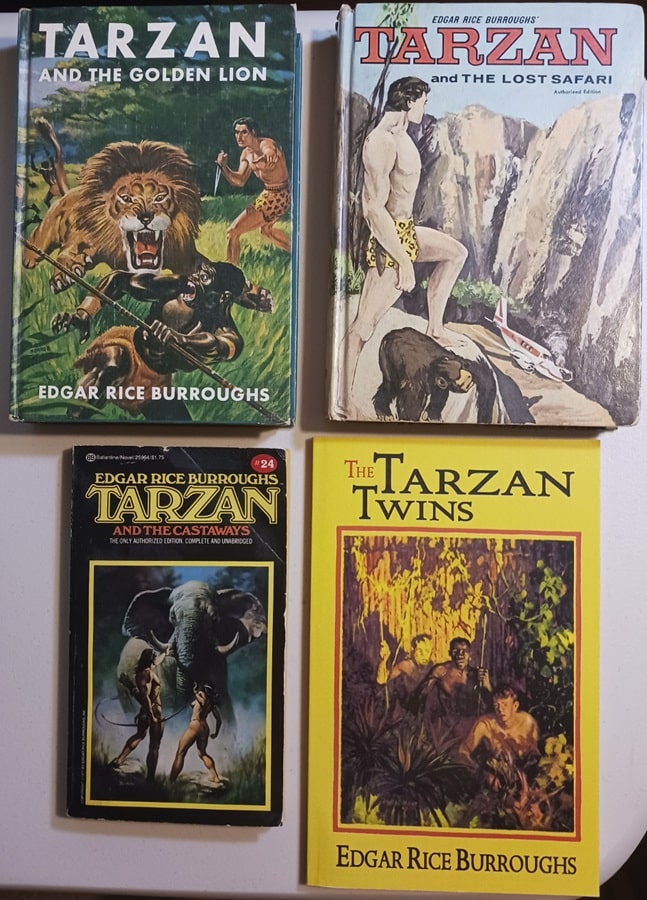 Tarzan and the Golden Lion (Grosset & Dunlap, 1949), Tarzan and the Lost Safari (Whitman Publishing, January 1, 1966, author unknown), Tarzan and the Castaways (Ballantine, September 1977), and The Tarzan Twins (Wildside Press, September 14, 2005). Covers by C. Edmund Monroe, Jr., Tony Sgroi, Boris Vallejo, and Douglas Grant.
Tarzan and the Golden Lion (Grosset & Dunlap, 1949), Tarzan and the Lost Safari (Whitman Publishing, January 1, 1966, author unknown), Tarzan and the Castaways (Ballantine, September 1977), and The Tarzan Twins (Wildside Press, September 14, 2005). Covers by C. Edmund Monroe, Jr., Tony Sgroi, Boris Vallejo, and Douglas Grant.
Overall, the Tarzan series is certainly not my favorite among ERB’s work anyway. They’re actually fairly low on my list of ERB favorites, although — don’t get me wrong — still very good. A ranking of my favorite series would be John Carter, Moon Maid, Carson of Venus, Land that Time Forgot, and Pellucidar, with Tarzan coming after that. Some of my favorite standalones would be The Outlaw of Torn, The Mad King, and I Am A Barbarian.
The Tarzan tales were almost certainly influenced by Rudyard Kipling’s jungle book tales of Mowgli, the wild boy of the forest — which in turn was influenced by some true reports from the mid-1800s of children in India being raised by wolves. ERB may have been directly aware of those same tales as well, and likely knew of the “Wild Boy of Aveyron,” who, around 1800, was found living in the wilds in France. The French feral child was named Victor by one of his “rescuers.” Unlike Tarzan, he never really learned to speak, although he apparently understood some language.
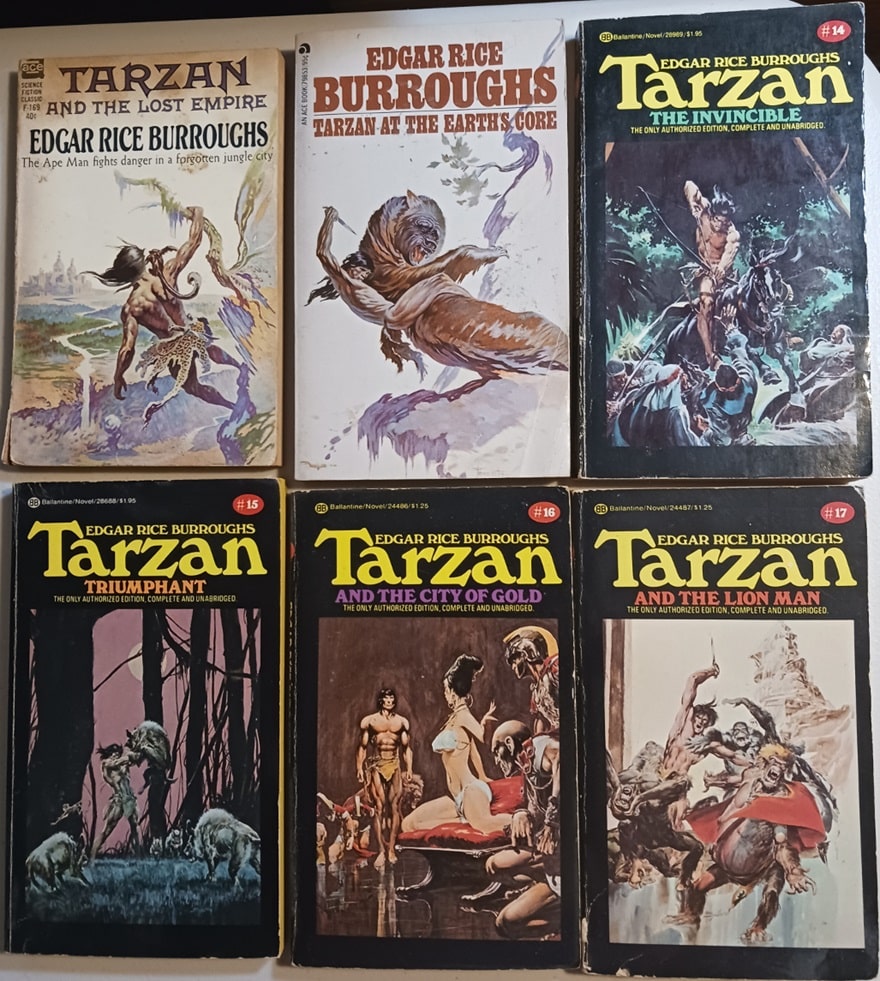 Tarzan #12 – #17: Tarzan and the Lost Empire and Tarzan at the Earth’s Core (Ace Books, November 1962 and March 1963), and Tarzan the Invincible, Tarzan Triumphant, Tarzan and the City of Gold, and Tarzan and the Lion Man (Ballantine Books, November 1975). Covers by Frank Frazetta and Neal Adams.
Tarzan #12 – #17: Tarzan and the Lost Empire and Tarzan at the Earth’s Core (Ace Books, November 1962 and March 1963), and Tarzan the Invincible, Tarzan Triumphant, Tarzan and the City of Gold, and Tarzan and the Lion Man (Ballantine Books, November 1975). Covers by Frank Frazetta and Neal Adams.
Above and below are the remaining Tarzan book pictures from my collection. The Ace copy of Lost Empire with the Frazetta cover that looks like it was inspired by Roy Krenkel Jr’s work is a real prize. I also have an Ace copy of Tarzan at the Earth’s Core, which also ties into ERB’s Pellucidar series, with a wonderful Frazetta cover.
The rest of my regular series are all Ballantine, with the following cover artists.
Invincible, Triumphant, City of Gold, Lion Man, Leopard Men; Neal Adams
Quest, Forbidden City, Magnificent, Foreign Legion, Madman, Castaways; Boris Vallejo
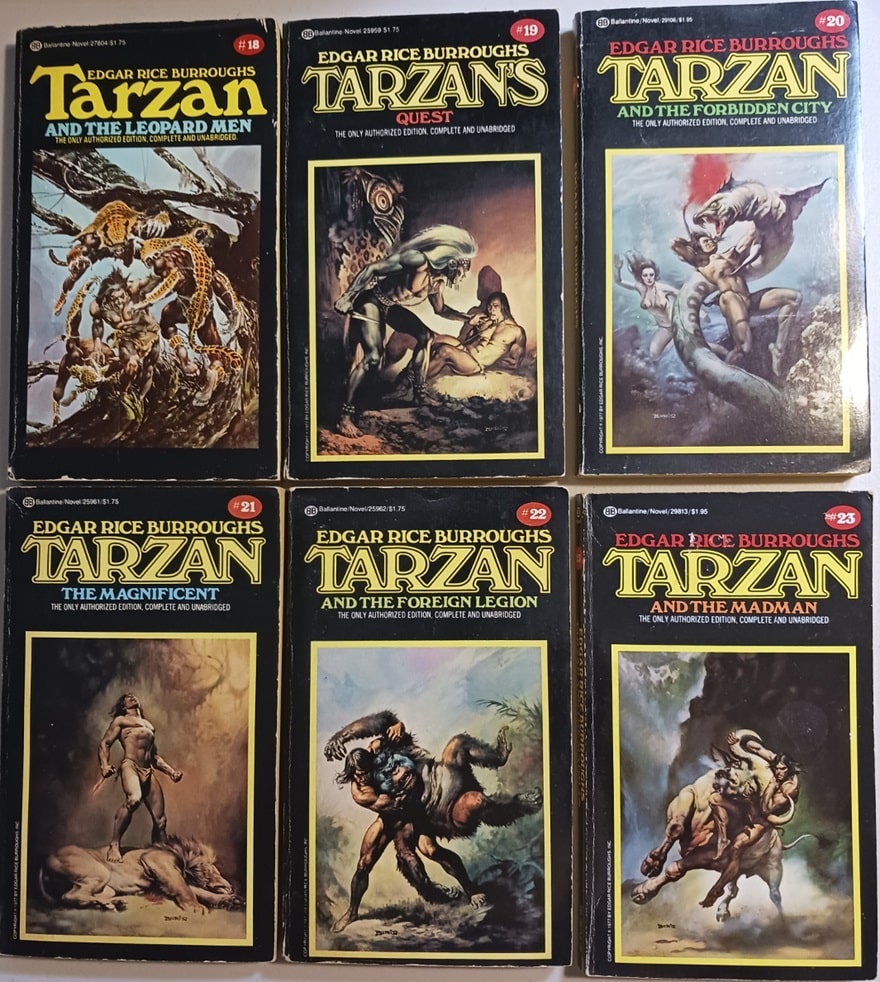 Tarzan #18 – #23: Tarzan and the Leopard Men ((Ballantine Books, November 1975, cover by Neal Adams), and Tarzan’s Quest, Tarzan and the Forbidden City, Tarzan the Magnificent, Tarzan and the Foreign Legion, and Tarzan and the Madman (Ballantine Books, September 1977, covers by Boris Vallejo).
Tarzan #18 – #23: Tarzan and the Leopard Men ((Ballantine Books, November 1975, cover by Neal Adams), and Tarzan’s Quest, Tarzan and the Forbidden City, Tarzan the Magnificent, Tarzan and the Foreign Legion, and Tarzan and the Madman (Ballantine Books, September 1977, covers by Boris Vallejo).
My second copy of Tarzan and the Golden Lion is from Grosset & Dunlap and clearly looks targeted toward younger readers with that cover (see above) — which is pretty cringeworthy for moderns. Not sure when it was published or who the cover artist might be.
Tarzan and the Lost Safari is adapted from the Tarzan movie of that same name. It was published by Whitman and doesn’t list an author, although I’ve seen Frank Castle’s name attached to it. I’ve seen this book for sale as by “Edgar Rice Burroughs.” It’s not. It’s closer to the movie Tarzan than to ERB’s creation. I didn’t find it very entertaining.
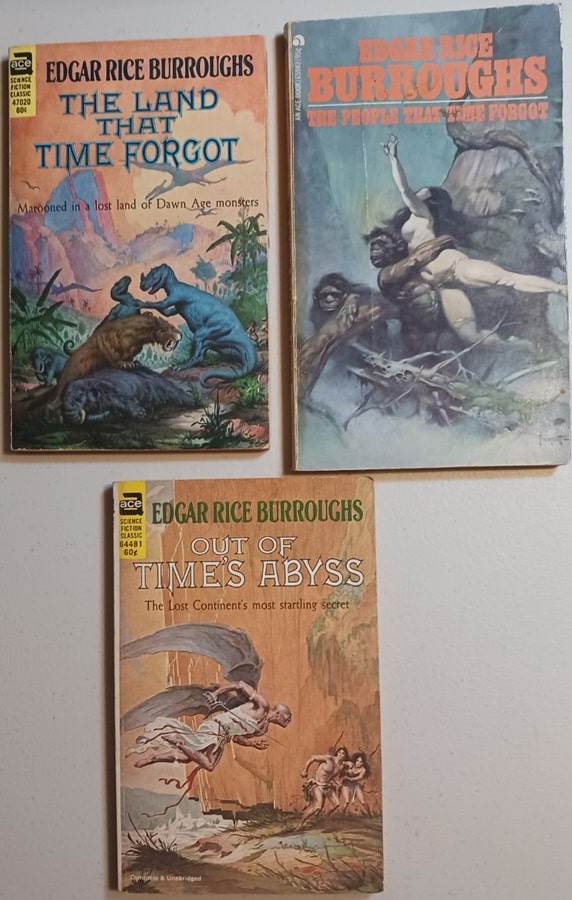 Three novels of The Lost Continent by Edgar Rice Burroughs: The Land That Time Forgot, The People That Time Forgot, and Out of Time’s Abyss (Ace Books, 1963, January 1973, and October 1963). Covers by Roy Krenkel, Jr, Frank Frazetta, and Roy Krenkel, Jr.
Three novels of The Lost Continent by Edgar Rice Burroughs: The Land That Time Forgot, The People That Time Forgot, and Out of Time’s Abyss (Ace Books, 1963, January 1973, and October 1963). Covers by Roy Krenkel, Jr, Frank Frazetta, and Roy Krenkel, Jr.
I personally don’t believe that ERB has been well served by the film and TV industries. I may be in the minority here but I find the early Tarzan movies to be virtually unwatchable. They seem to have very little to do with ERB’s characterization of Tarzan. The first Tarzan movie I actually liked was Greystoke: The Legend of Tarzan, starring Christopher Lambert. It still wasn’t the Tarzan I knew from the books but they made an effort to capture some of the character’s origins. I also liked most of the 2016 Legend of Tarzan, with Alexander Skarsgard, who I believe captured the essence of the character better than any previous Tarzan.
I generally liked the John Carter of Mars film, although they made changes that weren’t needed, but my favorite ERB adaptations are definitely a couple of B-movies starring Doug McClure. I’m talking about The People that Time Forgot, and The Land that Time Forgot. I’ve given these — especially the first one — frequent rewatches. Although the special effects are pretty awful by modern standards, the spirit of ERB’s stories shine through, the mystery and the exotic.
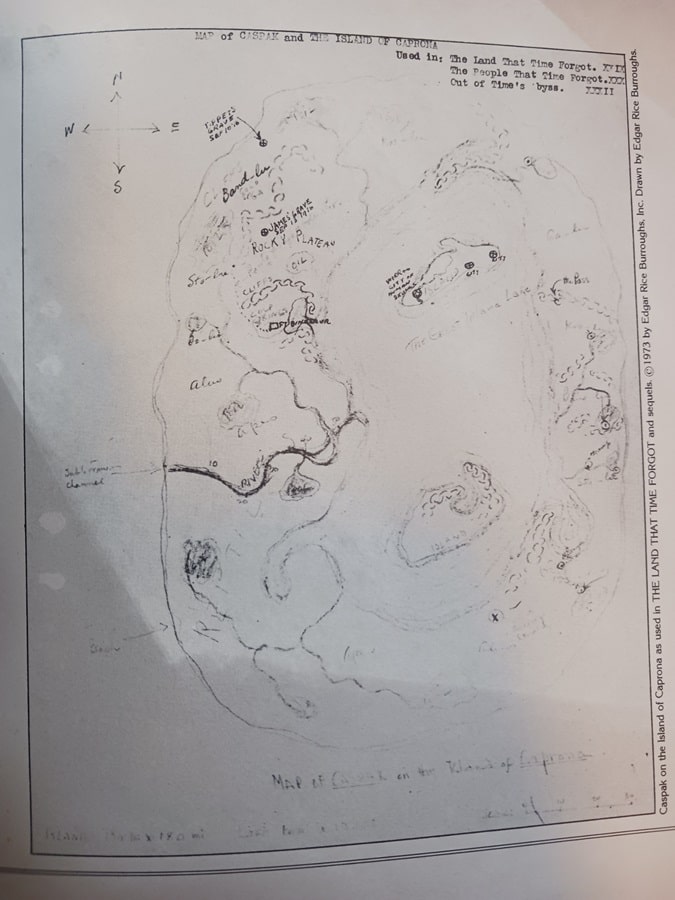 A map of Caprona, the Land that Time Forgot, from An Atlas of Fantasy by J. B. Post (Ballantine Books, 1979)
A map of Caprona, the Land that Time Forgot, from An Atlas of Fantasy by J. B. Post (Ballantine Books, 1979)
Of course, I loved the trilogy that spawned these movies — The Land that Time Forgot, The People that Time Forgot, and Out of Time’s Abyss. I thought Doug McClure did a good job with the character of Bowen Tyler, who becomes the first American to set foot on Caprona, a lost world near Antarctica where time seems to have stopped and dinosaurs still survive. There’s also a deep mystery about how things “evolve” on Caprona, though I won’t give it away.
Above are the three copies I have, all from Ace. Frazetta did the cover for The People while the other two are by Roy Krenkel, Jr. I’m also including a map of Caprona featured in An Atlas of Fantasy.
More on Burroughs next time.
Charles Gramlich administers The Swords & Planet League group on Facebook, where this post first appeared. His last article for Black Gate was The Fiction of Edgar Rice Burroughs, Part I: Sword and Planet.
The Intersection of Hobbies: Dungeons & Dragons, John Eric Holmes, and Tarzan
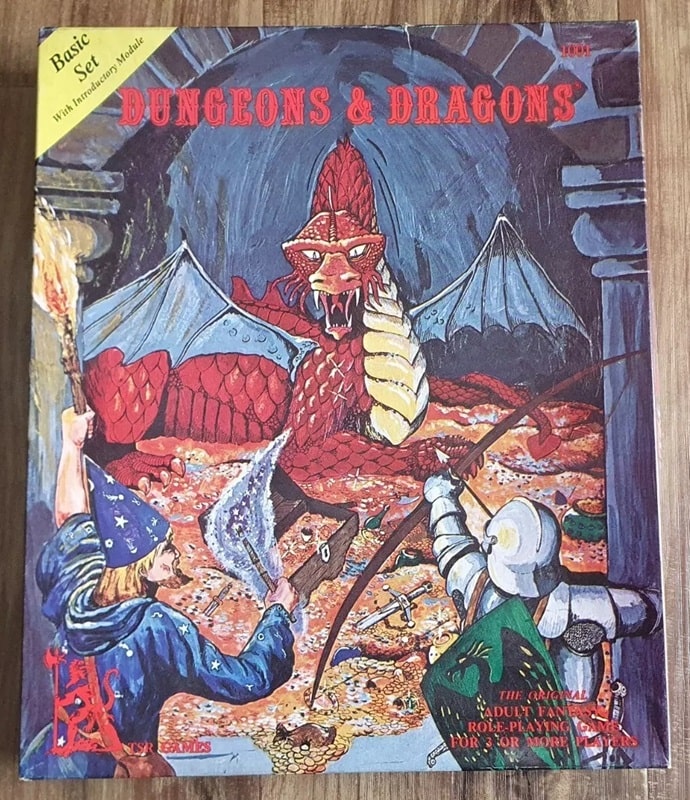 Dungeons & Dragons Basic Set by John Eric Holmes, based on Dungeons & Dragons by Gary Gygax and Dave Arneson (TSR Games, 1977). Cover by David Sutherland
Dungeons & Dragons Basic Set by John Eric Holmes, based on Dungeons & Dragons by Gary Gygax and Dave Arneson (TSR Games, 1977). Cover by David Sutherland
There are many intersections between my favorite hobby (which is also my line of work) and my favorite fiction. One of these intersections is represented by Dr. John Eric Holmes and the fiction of Edgar Rice Burroughs.
When I was a youth, the first Dungeons & Dragons set that I owned was edited by Dr. Holmes. That “basic” set served as the foundation to my understanding of all things D&D. Now, this was in 1981, when I was in the fifth grade. This was also the year in which I was devouring Tarzan novels, written by Edgar Rice Burroughs. My keen interest in Tarzan was fueled by the CBS Saturday morning cartoon, Tarzan, Lord of the Jungle.
[Click the images for Tarzan-sized versions.]
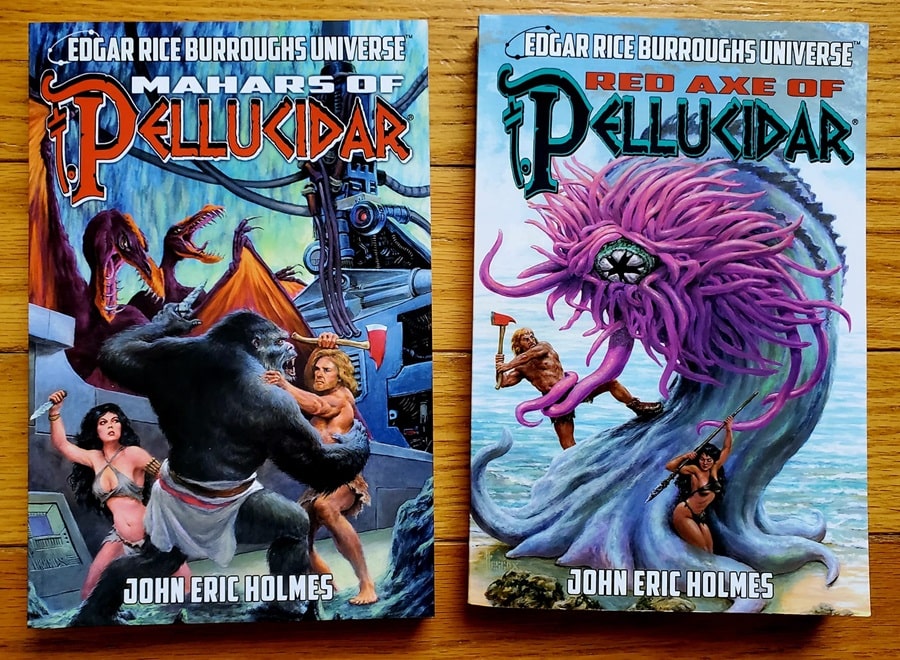 Pellucidar novels by John Eric Holmes: Mahars of Pellucidar and Red Axe of Pellucidar (Edgar Rice Burroughs, Inc., September 6, 2022). Covers by Richard Hescox
Pellucidar novels by John Eric Holmes: Mahars of Pellucidar and Red Axe of Pellucidar (Edgar Rice Burroughs, Inc., September 6, 2022). Covers by Richard Hescox
As I got older, I delved into other works by Burroughs, such as the Barsoom, Amtor, and Pellucidar stories. It wasn’t until recent years that I learned that Dr. Holmes had written two Pellucidar novels himself, the first of which was published in his lifetime, the other which was not: Mahars of Pellucidar and Red Axe of Pellucidar.
I am looking forward to reading these two books soon, probably spaced between my Zelazny readings. It’s nice to see that each of these books includes a foreword by Chris Holmes, one of Dr. Holmes’ children, whom I have had the pleasure to speak with several times at North Texas RPG Con.
 The complete Tarzan novels and collections by Edgar Rice Burroughs, published in paperback by Ballantine Books, 1975 – 1977. Covers by Neal Adams and Boris Vallejo
The complete Tarzan novels and collections by Edgar Rice Burroughs, published in paperback by Ballantine Books, 1975 – 1977. Covers by Neal Adams and Boris Vallejo
When I was young, my first exposure to Tarzan, created by Edgar Rice Burroughs, was the 1966 Tarzan TV series, starring Ron Ely. This was followed by the 1976–1980 animated series, Tarzan, Lord of the Jungle, which really captured my imagination.
I can still hear my brother Bob doing his “Bolmangani” voice from that cartoon. (The Bolmangani were evil gorilla-men that Tarzan often faced.) The show was excellent, and I particularly enjoyed the opening narration:
The jungle: Here I was born; and here my parents died when I was but an infant. I would have soon perished, too, had I not been found by a kindly she-ape named Kala, who adopted me as her own and taught me the ways of the wild. I learned quickly, and grew stronger each day, and now I share the friendship and trust of all jungle animals. The jungle is filled with beauty, and danger; and lost cities filled with good, and evil. This is my domain, and I protect those who come here; for I am Tarzan, Lord of the Jungle!
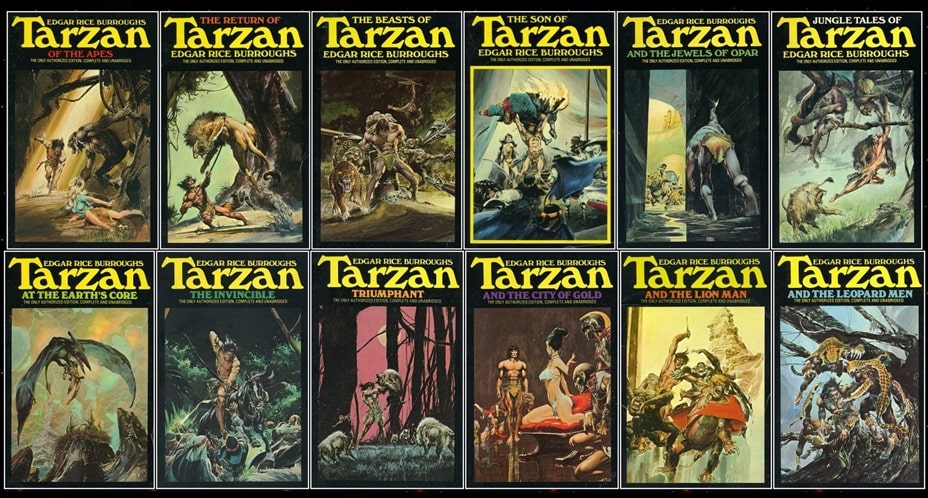 The twelve Neal Adams covers for the Ballantine Tarzan.
The twelve Neal Adams covers for the Ballantine Tarzan.
It was some time around 1981 that I began reading the actual ERB Tarzan books. I was completely enthralled within a few pages. The writing style of ERB was something like I’d never encountered before.
Pictured below is the cover art for the first Tarzan novel that I read, Tarzan of the Apes, published in 1977 by Ballantine Books. It was painted by Neal Adams, whose art was superb. In fact, I am of the opinion that Neal did the finest rendition of Batman to this day.
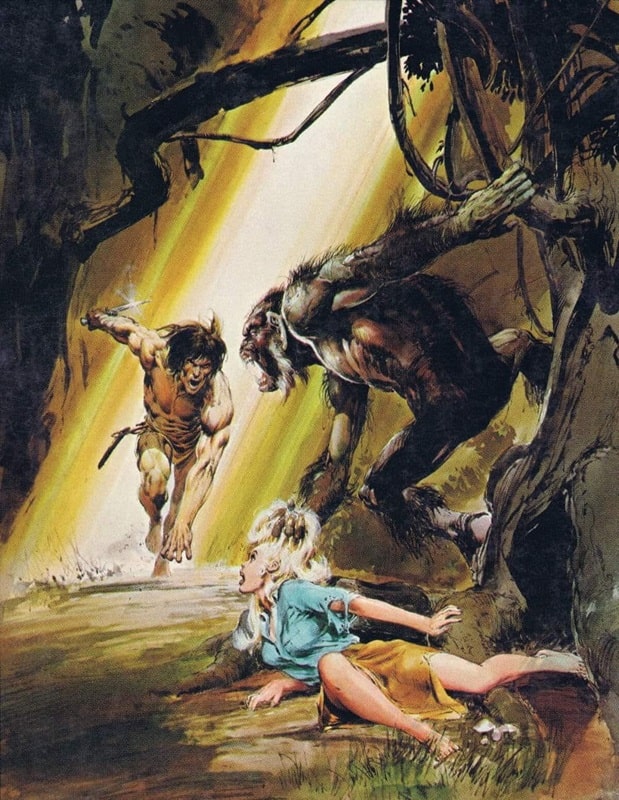 Cover art for Tarzan of the Apes by Neal Adams
Cover art for Tarzan of the Apes by Neal Adams
Anyway, the Neal Adams art is what drew me to purchase the first Tarzan book at my local Walden Books. It led me to a lifelong fascination with the incredibly imaginative works of Edgar Rice Burroughs.
In fact, I can open any ERB book to any random page, start reading, and find myself sucked into a world of wonder.
Jeffrey P. Talanian’s last article for Black Gate was Savage Sword of Conan is Back. He is the creator and publisher of the Hyperborea sword-and-sorcery and weird science-fantasy RPG from North Wind Adventures. He was the co-author, with E. Gary Gygax, of the Castle Zagyg releases, including several Yggsburgh city supplements, Castle Zagyg: The East Mark Gazetteer, and Castle Zagyg: The Upper Works. Read Gabe Gybing’s interview with Jeffrey here, and follow his latest projects on Facebook and at www.hyperborea.tv.
Is Sophie’s Choice a True Story? – Revisiting “Sophie’s Choice”
Is Sophie's Choice a true story? Styron based his novel on his memory of a real-life woman named Sophie, a survivor of Auschwitz he met in Brooklyn.
The post Is Sophie’s Choice a True Story? – Revisiting “Sophie’s Choice” appeared first on LitStack.
The Antidote
Fans of Barbara Kingsolver’s Demon Copperhead will want to grab this gorgeous magical-realist novel set on the Nebraska prairie during the height of the Dust Bowl climate disaster. Russell, a MacArthur grant winner, is best known for her collections of short stories, and this is only her second novel after the 2012 Pulitzer finalist Swamplandia! It is well worth the wait, offering a ferociously moving meditation on America’s refusal to come to terms with the violence and injustice of its own past. The story begins on “Black Sunday,” April 14, 1935, when tornadic dust storms destroyed farmland throughout the Great Plains, and a variety of point-of-view characters lead the reader to an intimate understanding of the Great Midwestern Drought that decimated the farmlands of the American prairie and worsened the Great Depression.
The premise sounds grim, but Russell draws on some of our most enchanting national myths to bring these characters to life. The alert reader will quickly realize that yes, this novel is set in the fictional town of Uz, Nebraska, in the depths of the Dust Bowl Depression, and yes, the inhabitants are menaced by dust tornados, and yes, the main characters are a scrappy orphan girl, a mysterious scarecrow, a stiff midwestern bachelor searching for love, and an exhausted prairie witch whose task it is to collect the toxic memories of her neighbors and store them away inside herself. But Russell’s evocations of L. Frank Baum’s American fairytale are subtle and never distract from the gritty, tender, fierce realism of this expansive story. The supernatural elements of the novel are infused with such a deep, compassionate humanity that the reader never has the sense that this is anything but a completely true story. Russell has created a masterpiece that will probably be on many 2025 award lists.
The post The Antidote appeared first on Historical Novel Society.
The Ballad of Mary Kearney
Ireland, 1765. When young Mary Kearney is sent to work at Goward Hall, she joins her brother and sister in service and lightens the load of her impoverished father, who has too many mouths to feed. She begins to wait on the very married Lady Mitchelstown, who is involved in a scandalous romance with Lord and Lady Goward’s son James. James eventually arranges for Mary to learn to read and write, and as they become much closer, the outrage of both the upper and lower classes descends upon them. They enter into a secret marriage, but in the eyes of the world, Mary is a mistress, and only a few at the time know that she is James’ wife. And nearby, an evil man waits, determined to ruin Mary for good.
Late 18th to early 19th-century Ireland comes alive in this book, as the characters speak to us from the past in dialect true to the time. There is a great deal of epistolary work, and it is woven in beautifully. Letters, articles, documents, and diary entries highlight the many voices, bringing each character to life with great effect. The novel begins with the dictated words of Mary’s father, who cannot read or write. The letters contain everything from love to gossip to threats, depending upon the writer. The class differences of the time are highlighted well, and the Catholic versus Protestant conflict is explored. The attempted uprising by the United Irishmen is well researched, and its consequences spill across the page. The captivating love story of James and Mary endures many hardships, including plotting and scheming from wicked people. Honest and intriguing, this gripping saga will transport and inspire you, and it just might break your heart. Highly recommended.
The post The Ballad of Mary Kearney appeared first on Historical Novel Society.
GRAVE EMPIRE by Richard Swan
Spies, Cowboys, Anarchists, O My: Polostan by Neal Stephenson
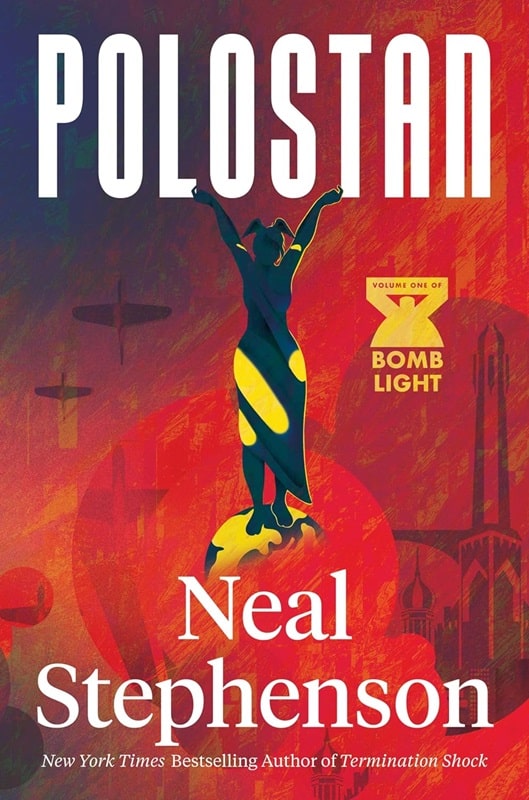
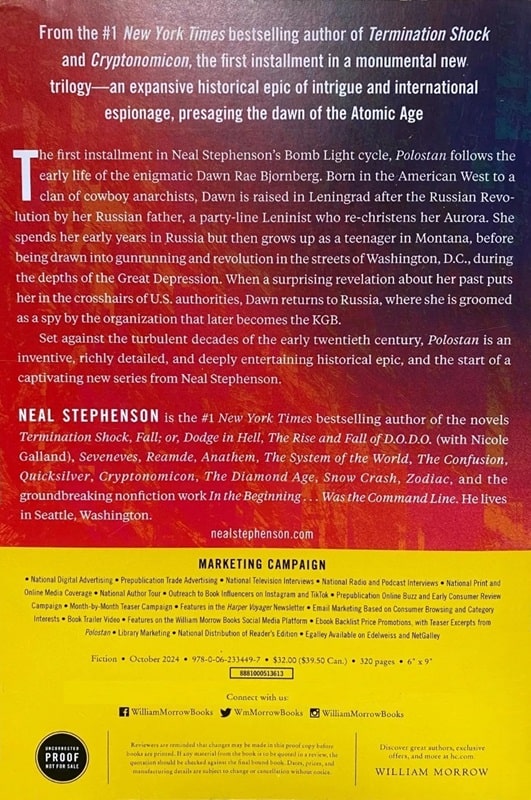
Polostan (William Morrow, October 15, 2024). Cover art uncredited
If, like me, you are a Neal Stephenson fan, you know he has a tendency to get deep into the descriptive weeds. I sometimes imagine his editor suggesting, “Neal, do we really need all this detail?” And then Neal grouchily responds, “If I didn’t think the story needed it, I wouldn’t have written it.”
Case in point from his latest novel, Polostan, a depiction of the 1933 Chicago World’s Fair Century of Progress exhibition where the protagonist, Dawn Rae Bjornberg, also known as Aurora Maximovna Artemyeva, works shilling for a shoe salesman:
She went to the fair early and stayed late, for the work was easy and there were plenty of diversions — that being the point of a fair. Her perambulations soon made her as conversant with the place as if it were an old city…As they were meant to, [the exhibits] drew visitors: 600 Norge salesmen on the B&O from Philly; 176 newsboys on the New York Central from Buffalo; 60 Episcopal bishops; 180 Civilian Conservation Corps workers en route to turpentine camps in the southeast; 100 Minnesota National Guard troops. Paramount Studios executives from Hollywood, Lions from St. Louis, Shriners from Fort Smith…
It goes on like this for quite a while. Do we really need to know that “Five hundred employees of the National Carbon Coated Paper Company of Sturgis, Michigan, arrived on the same train as 270 members of the Jewish Socialist Verband from New York City.” Probably not; it doesn’t further the plot, though it does provide a sort of Proustian vibe.
It’s also a metafictional joke Stephenson tells on himself. After Dawn/Aurora relates her life history to her Soviet inquisitor (which forms a kind of framework to a plethora of narratives, more about that in a second), he remarks, “You’ve been cooperative, if somewhat rambling. But that’s in the nature of your story — you really have been all over the place.”
“All over the place” is also how I’d describe this novel. But in a good way.
Born in 1916, a pivotal time in history when revolution was in the air, Dawn/Aurora’s childhood is split between Montana with her American radical mother and the Soviet Union with her Communist father (hence the American and Russian alter egos). Which makes her an ideal candidate for espionage against one of those countries. But which one is the question.
With an upbringing that includes acquiring equestrian skills, running guns and a fascination with Bonnie and Clyde as well as the Red Woman’s Death Battalion, the attention of then Major George Patton during an encampment of “Bonus Army” protesting World War I veterans in Washington, D.C., an abortion that makes her incapable of further pregnancy (and a matter-of-factly stated no-strings enticement to a prospective lover), and as a captive of con-artist evangelists as well as Soviet secret police OGPU led by the brutal Lavrentiy Beria. She is also witness to a deadly ballon ride by Soviet aeronauts named Elektron and Proton. We’ve already mentioned the Chicago World’s Fair.
But all of that is prologue and epilogue to Dawn’s chance meeting with “Dick,” a boy who impregnates her while on top of an early X-ray machine. Dick is probably Richard Feynman, who assisted in the development of the atomic bomb, but who here is a horny teenager happy to explain to Dawn current thinking in physics about possibly splitting the atom. Which makes her all the more a person of interest to Beria, who Stalin later appoints to head the Soviet atomic program. And which is why this is the first in a planned trilogy called Bomb Light.
Oh, and if you’re curious about what Polostan is supposed to mean, it is coined by British journalist Crisp-Upjohn, whom Aurora is tasked by the the OGPU to compromise, while playing against her during of an exhibition match with the Soviet women’s polo team.
So there is a lot here to unpack. But that Stephenson pulls off in a highly entertaining and brisk way. Because that is what Neal Stephenson does.
What there isn’t is a lot of is pages. While Stephenson is noted for producing doorstops, even for individual books in a series (The Baroque Cycle, for example, adds up to some 3,000 pages across three volumes), Polostan is a mere 303 pages. You might wonder why the author just didn’t produce one big book, other than that genre publishing suffers from a multi-volume series fixation. According to the author, the intent is to focus on a different character in each installment. “As far as the series format is concerned, we made a decision last year to bring it out one normal-sized book at a time, and to configure it in such a way that each volume will focus on one of the main characters. “
Also, Stephenson hasn’t finished writing it. So, there is that.
We wait with bated breath.
David Soyka is one of the founding bloggers at Black Gate. He’s written over 200 articles for us since 2008. His most recent was a review of Playground by Richard Powers.
The Book Devouring Horde Quiz
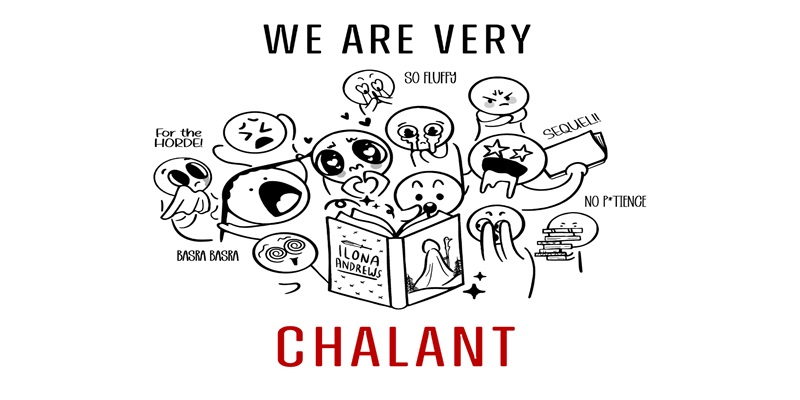
“I heard Realtors have to disclose if the house is haunted,” Leon said.
I looked at Mom in the driver’s seat. She gave me an amused smile. No help there.
“Apparently only four states require you to disclose paranormal activity,” Arabella reported. “Nine states require you to notify the buyer if a death occurred on the premises. And Texas does neither.”
“There were no deaths on the premises. Nobody died in the house, so it can’t possibly be haunted,” I told them.
“How do you know nobody died?” Leon asked.
“Because I checked the records,” Bern rumbled.
“That doesn’t mean anything,” Arabella said.
Clearly, there were two teams in this vehicle: Team Facts and Team Facts Be Damned.”
Andrews, Ilona. Ruby Fever, Hidden Legacy 6. Avon HarperCollins, 2022. Kindle edition, page 3
The Book Devouring Horde, the name for Ilona Andrews fans, stand united as a force to belove. Our fluffiness lies in the way we balance each other’s strengths and weaknesses, quirks and extremes. We remind each other of what is real and what is absolutely, gloriously NOT. And in the end, all that matters is that we all come together in appreciation for the same wonderful books.
But a quick stroll in any BDH comment section will quickly make you understand the reality of the Baylors conversation above. Following several requests and fan group polls, let’s find out which brand of chaos you bring to the Horde table!
Take the quiz below and embrace your destiny.*
*Disclaimer: not your actual destiny. As usual, the results are just for fun because I’m not the real Sorting Hat, I just look like it #wrinklelife. Please don’t take the quiz if this month has taken everything out of you and it could make you real-life upset. Hug(h)s!
Also, the quiz plugin doesn’t play nicely with the newsletter. If you’re getting this in your email, you can click here to come straight to the blog and take it.
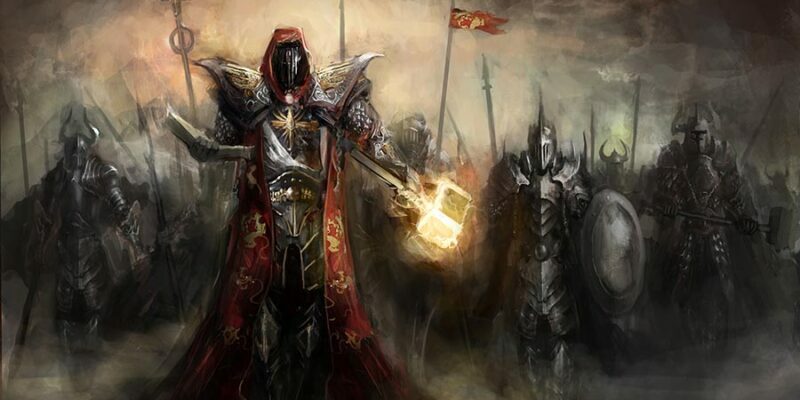
Which BDH team do you belong in?
Ah, the Book Devouring Horde. Whether you're sprinting off into the wilderness of speculation, hold firmly to the foundations of fact, vibrate with anticipation, or discuss everything into the ground- we are a force of nature. Where do you stand, when you stand with us?
1 / 9
Someone shipped Julie and Saiman. Your first instinct is:
 Metal Rose Metal Rose Metal ROOOOOSE!
That’s interesting. I want to hear them out.
Burn it! With FIRE! Burn it with BEAVERS!
Yu Fong? Sure. Ascanio? Maybe. Derek? Most likely, based on all the evidence. Saiman makes no sense. Explain yourself.
Metal Rose Metal Rose Metal ROOOOOSE!
That’s interesting. I want to hear them out.
Burn it! With FIRE! Burn it with BEAVERS!
Yu Fong? Sure. Ascanio? Maybe. Derek? Most likely, based on all the evidence. Saiman makes no sense. Explain yourself.
2 / 9
A BDH colleague posts a theory you don’t agree with:
 That’s interesting, I like the way you think. I would even agree with you, but then we’d both be wrong.
Your first mistake is that you haven’t taken this far enough! What you first need to understand is that every.single.shifter is a First...
Live and let conspire. I’ll watch how it plays out, and maybe even get a House Andrews answer out of it.
Ever considered doing the action known as “putting two and two together”?
That’s interesting, I like the way you think. I would even agree with you, but then we’d both be wrong.
Your first mistake is that you haven’t taken this far enough! What you first need to understand is that every.single.shifter is a First...
Live and let conspire. I’ll watch how it plays out, and maybe even get a House Andrews answer out of it.
Ever considered doing the action known as “putting two and two together”?
3 / 9
How do you react to the three words most dreaded by the Horde: w*it, p*tience, d*lay?
 Steady ON. You know there are kids around, right?
It’s not the best, but life happens. We are still beloved.
House Andrews have quit writing. It’s because of all the graphic novels. They'll never go back to real books.
We will murder the words. Patience is futile! Waiting is the mind killer! Delays are the enemy!
Steady ON. You know there are kids around, right?
It’s not the best, but life happens. We are still beloved.
House Andrews have quit writing. It’s because of all the graphic novels. They'll never go back to real books.
We will murder the words. Patience is futile! Waiting is the mind killer! Delays are the enemy!
4 / 9
A serial or snippet you want to reread has been archived on the blog. How do you react?
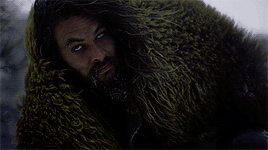 We wish to discuss! Vociferously!
That’s what the Snippet Dark Web is for. I meet with the underground BDH in absconded corners of the internet, and we make the relevant snippet/spoiler trade off.
The Void is darkness, the Void is peace, I am within it, wrapped in its cold embrace...
The authors had their reasons. Hopefully we'll see a final edit of it published.
We wish to discuss! Vociferously!
That’s what the Snippet Dark Web is for. I meet with the underground BDH in absconded corners of the internet, and we make the relevant snippet/spoiler trade off.
The Void is darkness, the Void is peace, I am within it, wrapped in its cold embrace...
The authors had their reasons. Hopefully we'll see a final edit of it published.
5 / 9
Ilona has posted an April Fools' joke about a new book. What do you do?
 I’ve already requested it from my local librarians and added it to Goodreads, where it has over a thousand reviews so…good luck on keeping this a prank lol
I immediately checked the date and figured out it’s a prank. But you know, they say in every joke there's a kernel of truth…
I go on an emotional rollercoaster before realizing the truth. And another one after realizing the truth.
No backsies. You said it, you write it, we read it. It is known.
I’ve already requested it from my local librarians and added it to Goodreads, where it has over a thousand reviews so…good luck on keeping this a prank lol
I immediately checked the date and figured out it’s a prank. But you know, they say in every joke there's a kernel of truth…
I go on an emotional rollercoaster before realizing the truth. And another one after realizing the truth.
No backsies. You said it, you write it, we read it. It is known.
6 / 9
House Andrews tell us that "The next Innkeeper book will be the end of the missing parents series arc". What does this mean to you?
 There will never be any more Innkeeper books. We won't find out about Maud! Orro will never cook again! PAPERCUT TO MY SOUL! I told you they sold the series to the muskrats!
End of the series arc doesn't mean the end of the series. They can have several adventures after that, it's a wide Galaxy out there.
Proposal: You write several Gertrude Hunt novellas. Then a Klaus novel. Followed by Helen's series. How Dina met Beast. An Arbitrators Saga, the Jack Camarine spin off, heavily featuring Gaston’s Baha-char business ventures. How Caldenia came to the Inn and other Dominion misadventures and then a Drifen trilogy. Do you wish to discuss?
I do want to know what happens and all the answers, but I don't want it to end. But I’ll preorder it as soon as it’s available!
There will never be any more Innkeeper books. We won't find out about Maud! Orro will never cook again! PAPERCUT TO MY SOUL! I told you they sold the series to the muskrats!
End of the series arc doesn't mean the end of the series. They can have several adventures after that, it's a wide Galaxy out there.
Proposal: You write several Gertrude Hunt novellas. Then a Klaus novel. Followed by Helen's series. How Dina met Beast. An Arbitrators Saga, the Jack Camarine spin off, heavily featuring Gaston’s Baha-char business ventures. How Caldenia came to the Inn and other Dominion misadventures and then a Drifen trilogy. Do you wish to discuss?
I do want to know what happens and all the answers, but I don't want it to end. But I’ll preorder it as soon as it’s available!
7 / 9
There's a new snippet on the blog. How do you react?
 I devour it immediately, thank you!
I’m keeping it for a rainy day.
What about the other series? Does this snippet mean there won't be any more from other series? Have you abandoned them?
Nooooo, I forgot it was a snippet! I got so lost in it and then it was over! Please, House Andrews, may we have some more?
I devour it immediately, thank you!
I’m keeping it for a rainy day.
What about the other series? Does this snippet mean there won't be any more from other series? Have you abandoned them?
Nooooo, I forgot it was a snippet! I got so lost in it and then it was over! Please, House Andrews, may we have some more?
8 / 9
It’s release day of a new Ilona Andrews book, what do you comment?
 I don't comment, I'm DEVOURING!
A long review on the blog. Spoilers might slip. I'm emotionally compromised.
Review on book review sites, questions on the blog release thread.
When is the next one coming out?
I don't comment, I'm DEVOURING!
A long review on the blog. Spoilers might slip. I'm emotionally compromised.
Review on book review sites, questions on the blog release thread.
When is the next one coming out?
9 / 9
House Andrews mention a new character in passing. What's your first thought?
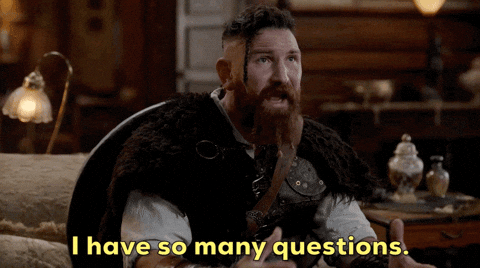 I update my characters chart but wait for more concrete information before making any assumptions.
Never heard the name before, so it's clearly Augustine’s long lost sibling. This means an Arabella trilogy is in the works, with this character as a love interest. And it sounds like an Innkeeper cross-over. I have to tell my friends!
Does this mean a new book? Hope the wait won’t be too long! But aren’t you working on Hugh 2?
If nothing else is put forth in the next 10 working days, I’ll be sure to drop a reminder on the blog. We must discuss!
LinkedIn
Facebook
Twitter
VKontakte
div#ays-quiz-container-8 * { box-sizing: border-box; } /* Styles for Internet Explorer start */ #ays-quiz-container-8 #ays_finish_quiz_8 { } /* Styles for Quiz container */ #ays-quiz-container-8{ min-height: 350px; width:400px; background-color:#fff; background-position:center center;border-radius:0px 0px 0px 0px;box-shadow: 0px 0px 15px 1px rgba(0,0,0,0.4);border: none;} /* Styles for Navigation bar */ #ays-quiz-questions-nav-wrap-8 { width: 100%;border-radius:0px 0px 0px 0px;box-shadow: 0px 0px 15px 1px rgba(0,0,0,0.4);border: none;} #ays-quiz-questions-nav-wrap-8 .ays-quiz-questions-nav-content .ays-quiz-questions-nav-item a.ays_questions_nav_question { color: #000; border-color: #000; background-color: #fff; } #ays-quiz-questions-nav-wrap-8 .ays-quiz-questions-nav-content .ays-quiz-questions-nav-item.ays-quiz-questions-nav-item-active a.ays_questions_nav_question { box-shadow: inset 0 0 5px #000, 0 0 5px #000; } #ays-quiz-questions-nav-wrap-8 .ays-quiz-questions-nav-content .ays-quiz-questions-nav-item.ays-quiz-questions-nav-item-answered a.ays_questions_nav_question { color: #fff; border-color: #fff; background-color: #000; } #ays-quiz-questions-nav-wrap-8 .ays-quiz-questions-nav-content .ays-quiz-questions-nav-item a.ays_questions_nav_question.ays_quiz_correct_answer { color: rgba(39, 174, 96, 1); border-color: rgba(39, 174, 96, 1); background-color: rgba(39, 174, 96, 0.4); } #ays-quiz-questions-nav-wrap-8 .ays-quiz-questions-nav-content .ays-quiz-questions-nav-item a.ays_questions_nav_question.ays_quiz_wrong_answer { color: rgba(243, 134, 129, 1); border-color: rgba(243, 134, 129, 1); background-color: rgba(243, 134, 129, 0.4); } /* Styles for questions */ #ays-quiz-container-8 #ays_finish_quiz_8 div.step { min-height: 350px; } /* Styles for text inside quiz container */ #ays-quiz-container-8.ays-quiz-container .ays-questions-container .ays-start-page *:not(input), #ays-quiz-container-8.ays-quiz-container .ays-questions-container .ays_question_hint, #ays-quiz-container-8.ays-quiz-container .ays-questions-container label[for^="ays-answer-"], #ays-quiz-container-8.ays-quiz-container .ays-questions-container p, #ays-quiz-container-8.ays-quiz-container .ays-questions-container .ays-fs-title, #ays-quiz-container-8.ays-quiz-container .ays-questions-container .ays-fs-subtitle, #ays-quiz-container-8.ays-quiz-container .ays-questions-container .logged_in_message, #ays-quiz-container-8.ays-quiz-container .ays-questions-container .ays-quiz-limitation-count-of-takers, #ays-quiz-container-8.ays-quiz-container .ays-questions-container .ays-quiz-limitation-count-of-takers *, #ays-quiz-container-8.ays-quiz-container .ays-questions-container .ays_score_message, #ays-quiz-container-8.ays-quiz-container .ays-questions-container .ays_message{ color: #000; outline: none; } /* Quiz title / transformation */ #ays-quiz-container-8 .ays-fs-title{ text-transform: uppercase; font-size: 21px; text-align: center; text-shadow: none; } #ays-quiz-container-8 .ays-quiz-password-message-box, #ays-quiz-container-8 .ays-quiz-question-note-message-box, #ays-quiz-container-8 .ays_quiz_question, #ays-quiz-container-8 .ays_quiz_question *:not([class^='enlighter']) { color: #000; } #ays-quiz-container-8 textarea, #ays-quiz-container-8 input::first-letter, #ays-quiz-container-8 select::first-letter, #ays-quiz-container-8 option::first-letter { color: initial !important; } #ays-quiz-container-8 p::first-letter:not(.ays_no_questions_message) { color: #000 !important; background-color: transparent !important; font-size: inherit !important; font-weight: inherit !important; float: none !important; line-height: inherit !important; margin: 0 !important; padding: 0 !important; } #ays-quiz-container-8 .select2-container, #ays-quiz-container-8 .ays-field * { font-size: 15px !important; } #ays-quiz-container-8 .ays-fs-subtitle p { text-align: center ; } #ays-quiz-container-8 .ays_quiz_question p { font-size: 16px; text-align: center; } #ays-quiz-container-8 .ays_quiz_question { text-align: center ; margin-bottom: 10px; } #ays-quiz-container-8 .ays_quiz_question pre { max-width: 100%; white-space: break-spaces; } div#ays-quiz-container-8 .ays-questions-container .ays-field, div#ays-quiz-container-8 .ays-questions-container .ays-field input~label[for^='ays-answer-'], div#ays-quiz-container-8 .ays-questions-container .ays-modern-dark-question *, div#ays-quiz-container-8 .ays-questions-container .ays_quiz_question, div#ays-quiz-container-8 .ays-questions-container .ays_quiz_question *{ word-break: break-word; } #ays-quiz-container-8 .ays-quiz-timer p { font-size: 16px; } #ays-quiz-container-8 section.ays_quiz_redirection_timer_container hr, #ays-quiz-container-8 section.ays_quiz_timer_container hr { margin: 0; } #ays-quiz-container-8 section.ays_quiz_timer_container.ays_quiz_timer_red_warning .ays-quiz-timer { color: red; } #ays-quiz-container-8 .ays_thank_you_fs p { text-align: center; } #ays-quiz-container-8 .information_form input[type='text'], #ays-quiz-container-8 .information_form input[type='url'], #ays-quiz-container-8 .information_form input[type='number'], #ays-quiz-container-8 .information_form input[type='email'], #ays-quiz-container-8 .information_form input[type='tel'], #ays-quiz-container-8 .information_form textarea, #ays-quiz-container-8 .information_form select, #ays-quiz-container-8 .information_form option { color: initial !important; outline: none; margin-left: 0; background-image: unset; } #ays-quiz-container-8 .information_form input[type='checkbox'] { margin: 0 10px; outline: initial; -webkit-appearance: auto; -moz-appearance: auto; position: initial; width: initial; height: initial; border: initial; background: initial; } #ays-quiz-container-8 .information_form input[type='checkbox']::after { content: none; } #ays-quiz-container-8 .wrong_answer_text{ color:#ff4d4d; } #ays-quiz-container-8 .right_answer_text{ color:#33cc33; } #ays-quiz-container-8 .right_answer_text p { font-size:16px; } #ays-quiz-container-8 .wrong_answer_text p { font-size:16px; } #ays-quiz-container-8 .ays_questtion_explanation p { font-size:16px; } #ays-quiz-container-8 .ays_cb_and_a, #ays-quiz-container-8 .ays_cb_and_a * { color: rgb(0,0,0); text-align: center; } #ays-quiz-container-8 iframe { /*min-height: 350px;*/ } #ays-quiz-container-8 label.ays_for_checkbox, #ays-quiz-container-8 span.ays_checkbox_for_span { color: initial !important; display: block; } /* Quiz textarea height */ #ays-quiz-container-8 textarea { height: 100px; min-height: 100px; } /* Quiz rate and passed users count */ #ays-quiz-container-8 .ays_quizn_ancnoxneri_qanak, #ays-quiz-container-8 .ays_quiz_rete_avg{ color:#fff; background-color:#000; } #ays-quiz-container-8 .ays-questions-container > .ays_quizn_ancnoxneri_qanak { padding: 5px 20px; } #ays-quiz-container-8 div.for_quiz_rate.ui.star.rating .icon { color: rgba(0,0,0,0.35); } #ays-quiz-container-8 .ays_quiz_rete_avg div.for_quiz_rate_avg.ui.star.rating .icon { color: rgba(255,255,255,0.5); } #ays-quiz-container-8 .ays_quiz_rete .ays-quiz-rate-link-box .ays-quiz-rate-link { color: #000; } /* Loaders */ #ays-quiz-container-8 div.lds-spinner, #ays-quiz-container-8 div.lds-spinner2 { color: #000; } #ays-quiz-container-8 div.lds-spinner div:after, #ays-quiz-container-8 div.lds-spinner2 div:after { background-color: #000; } #ays-quiz-container-8 .lds-circle, #ays-quiz-container-8 .lds-facebook div, #ays-quiz-container-8 .lds-ellipsis div{ background: #000; } #ays-quiz-container-8 .lds-ripple div{ border-color: #000; } #ays-quiz-container-8 .lds-dual-ring::after, #ays-quiz-container-8 .lds-hourglass::after{ border-color: #000 transparent #000 transparent; } /* Stars */ #ays-quiz-container-8 .ui.rating .icon, #ays-quiz-container-8 .ui.rating .icon:before { font-family: Rating !important; } /* Progress bars */ #ays-quiz-container-8 #ays_finish_quiz_8 .ays-progress { border-color: rgba(0,0,0,0.8); } #ays-quiz-container-8 #ays_finish_quiz_8 .ays-progress-bg { background-color: rgba(0,0,0,0.3); } #ays-quiz-container-8 .ays-progress-value { color: #000; text-align: center; } #ays-quiz-container-8 .ays-progress-bar { background-color: #27AE60; } #ays-quiz-container-8 .ays-question-counter .ays-live-bar-wrap { direction:ltr !important; } #ays-quiz-container-8 .ays-live-bar-fill{ color: #000; border-bottom: 2px solid rgba(0,0,0,0.8); text-shadow: 0px 0px 5px #fff; } #ays-quiz-container-8 .ays-live-bar-fill.ays-live-fourth, #ays-quiz-container-8 .ays-live-bar-fill.ays-live-third, #ays-quiz-container-8 .ays-live-bar-fill.ays-live-second { text-shadow: unset; } #ays-quiz-container-8 .ays-live-bar-percent{ display:none; } /* Music, Sound */ #ays-quiz-container-8 .ays_music_sound { color:rgb(0,0,0); } /* Dropdown questions scroll bar */ #ays-quiz-container-8 blockquote { border-left-color: #000 !important; } /* Quiz Password */ #ays-quiz-container-8 .ays-start-page > input[id^='ays_quiz_password_val_'], #ays-quiz-container-8 .ays-quiz-password-toggle-visibility-box { width: 100%; margin: 0 auto; } /* Question hint */ #ays-quiz-container-8 .ays_question_hint_container .ays_question_hint_text { background-color:#fff; box-shadow: 0 0 15px 3px rgba(0,0,0,0.6); max-width: 270px; } #ays-quiz-container-8 .ays_question_hint_container .ays_question_hint_text p { max-width: unset; } #ays-quiz-container-8 .ays_questions_hint_max_width_class { max-width: 80%; } /* Information form */ #ays-quiz-container-8 .ays-form-title{ color:rgb(0,0,0); } /* Quiz timer */ #ays-quiz-container-8 div.ays-quiz-redirection-timer, #ays-quiz-container-8 div.ays-quiz-timer{ color: #000; text-align: center; } #ays-quiz-container-8 div.ays-quiz-timer.ays-quiz-message-before-timer:before { font-weight: 500; } /* Quiz buttons */ #ays-quiz-container-8 input#ays-submit, #ays-quiz-container-8 #ays_finish_quiz_8 .action-button, div#ays-quiz-container-8 #ays_finish_quiz_8 .action-button.ays_restart_button { background-color: #27AE60; color:#333; font-size: 17px; padding: 10px 20px; border-radius: 3px; white-space: nowrap; letter-spacing: 0; box-shadow: unset; white-space: normal; word-break: break-word; } #ays-quiz-container-8 input#ays-submit, #ays-quiz-container-8 #ays_finish_quiz_8 input.action-button { } #ays-quiz-container-8 #ays_finish_quiz_8 a[class~=ajax_add_to_cart]{ background-color: #fff; color:#333; padding: 10px 5px; font-size: 14px; border-radius: 3px; white-space: nowrap; border: 1px solid #333; } #ays-quiz-container-8 #ays_finish_quiz_8 .action-button.ays_check_answer { padding: 5px 10px; font-size: 17px !important; } #ays-quiz-container-8 #ays_finish_quiz_8 .action-button.ays_download_certificate { white-space: nowrap; padding: 5px 10px; } #ays-quiz-container-8 #ays_finish_quiz_8 .action-button.ays_arrow { color:#333!important; white-space: nowrap; padding: 5px 10px; } #ays-quiz-container-8 input#ays-submit:hover, #ays-quiz-container-8 input#ays-submit:focus, #ays-quiz-container-8 #ays_finish_quiz_8 .action-button:hover, #ays-quiz-container-8 #ays_finish_quiz_8 .action-button:focus { box-shadow: 0 0 0 2px #333; background-color: #27AE60; } #ays-quiz-container-8 .ays_restart_button { color: #333; } #ays-quiz-container-8 .ays_restart_button_p { display: flex; justify-content: center; flex-wrap: wrap; } #ays-quiz-container-8 .ays_buttons_div { justify-content: center; } #ays-quiz-container-8 .step:first-of-type .ays_buttons_div { justify-content: center !important; } #ays-quiz-container-8 input[type='button'], #ays-quiz-container-8 input[type='submit'] { color: #333 !important; outline: none; } #ays-quiz-container-8 #ays_finish_quiz_8 i.ays_early_finish.action-button[disabled]:hover, #ays-quiz-container-8 #ays_finish_quiz_8 i.ays_early_finish.action-button[disabled]:focus, #ays-quiz-container-8 #ays_finish_quiz_8 i.ays_early_finish.action-button[disabled], #ays-quiz-container-8 #ays_finish_quiz_8 i.ays_arrow.action-button[disabled]:hover, #ays-quiz-container-8 #ays_finish_quiz_8 i.ays_arrow.action-button[disabled]:focus, #ays-quiz-container-8 #ays_finish_quiz_8 i.ays_arrow.action-button[disabled] { color: #aaa !important; } #ays-quiz-container-8 .ays_finish.action-button{ margin: 10px 5px; } #ays-quiz-container-8 .ays-share-btn.ays-share-btn-branded { color: #fff; } /* Question answers */ #ays-quiz-container-8 .ays-field { border-color: #444; border-style: solid; border-width: 1px; box-shadow: none;flex-direction: row-reverse; } #ays-quiz-container-8 .ays-quiz-answers .ays-field:hover{ opacity: 1; } #ays-quiz-container-8 #ays_finish_quiz_8 .ays-field label.ays_answer_caption[for^='ays-answer-'] { z-index: 1; position:initial;bottom:0;} #ays-quiz-container-8 #ays_finish_quiz_8 .ays-field input~label[for^='ays-answer-'] { padding: 5px; } #ays-quiz-container-8 #ays_finish_quiz_8 .ays-field { margin-bottom: 10px; } #ays-quiz-container-8 #ays_finish_quiz_8 .ays-field.ays_grid_view_item { width: calc(50% - 5px); } #ays-quiz-container-8 #ays_finish_quiz_8 .ays-field.ays_grid_view_item:nth-child(odd) { margin-right: 5px; } #ays-quiz-container-8 #ays_finish_quiz_8 .ays-field input:checked+label:before { border-color: #27AE60; background: #27AE60; background-clip: content-box; } #ays-quiz-container-8 .ays-quiz-answers div.ays-text-right-answer { color: #000; } /* Answer maximum length of a text field */ #ays-quiz-container-8 .ays_quiz_question_text_message{ color: #000; text-align: left; font-size: 12px; } div#ays-quiz-container-8 div.ays_quiz_question_text_error_message { color: #ff0000; } /* Questions answer image */ #ays-quiz-container-8 .ays-answer-image { width:15em; height:150px; object-fit: cover; } /* Questions answer right/wrong icons */ #ays-quiz-container-8 .ays-field input~label.answered.correct:after{ content: url('http://ilona-andrews.com/wp-content/plugins/quiz-maker/public/images/correct.png'); } #ays-quiz-container-8 .ays-field input~label.answered.wrong:after{ content: url('http://ilona-andrews.com/wp-content/plugins/quiz-maker/public/images/wrong.png'); } #ays-quiz-container-8 .ays-field label.answered:last-of-type:after{ height: auto; left: 10px;top: 10px;} /* Dropdown questions */ #ays-quiz-container-8 .select2-container--default .select2-search--dropdown .select2-search__field:focus, #ays-quiz-container-8 .select2-container--default .select2-search--dropdown .select2-search__field { outline: unset; padding: 0.75rem; } #ays-quiz-container-8 #ays_finish_quiz_8 .ays-field .select2-container--default .select2-selection--single { border-bottom: 2px solid #27AE60; background-color: #27AE60; } #ays-quiz-container-8 .ays-field .select2-container--default .select2-selection--single .select2-selection__rendered, #ays-quiz-container-8 .ays-field .select2-container--default .select2-selection--single .select2-selection__placeholder, #ays-quiz-container-8 .ays-field .select2-container--default .select2-selection--single .select2-selection__arrow { color: #d8519f; } #ays-quiz-container-8 .ays-field .select2-container--default .select2-selection--single .select2-selection__rendered, #ays-quiz-container-8 .select2-container--default .select2-results__option--highlighted[aria-selected] { background-color: #27AE60; } #ays-quiz-container-8 .ays-field .select2-container--default, #ays-quiz-container-8 .ays-field .select2-container--default .selection, #ays-quiz-container-8 .ays-field .select2-container--default .dropdown-wrapper, #ays-quiz-container-8 .ays-field .select2-container--default .select2-selection--single .select2-selection__rendered, #ays-quiz-container-8 .ays-field .select2-container--default .select2-selection--single .select2-selection__rendered .select2-selection__placeholder, #ays-quiz-container-8 .ays-field .select2-container--default .select2-selection--single .select2-selection__arrow, #ays-quiz-container-8 .ays-field .select2-container--default .select2-selection--single .select2-selection__arrow b[role='presentation'] { font-size: 16px !important; } #ays-quiz-container-8 .select2-container--default .select2-results__option { padding: 6px; } /* Dropdown questions scroll bar */ #ays-quiz-container-8 .select2-results__options::-webkit-scrollbar { width: 7px; } #ays-quiz-container-8 .select2-results__options::-webkit-scrollbar-track { background-color: rgba(255,255,255,0.35); } #ays-quiz-container-8 .select2-results__options::-webkit-scrollbar-thumb { transition: .3s ease-in-out; background-color: rgba(255,255,255,0.55); } #ays-quiz-container-8 .select2-results__options::-webkit-scrollbar-thumb:hover { transition: .3s ease-in-out; background-color: rgba(255,255,255,0.85); } /* WooCommerce product */ #ays-quiz-container-8 .ays-woo-block { background-color: rgba(39,174,96,0.8); } #ays-quiz-container-8 .ays-woo-product-block h4.ays-woo-product-title > a { color: #000; } /* Audio / Video */ #ays-quiz-container-8 .mejs-container .mejs-time{ box-sizing: unset; } #ays-quiz-container-8 .mejs-container .mejs-time-rail { padding-top: 15px; } #ays-quiz-container-8 .mejs-container .mejs-mediaelement video { margin: 0; } /* Limitation */ #ays-quiz-container-8 .ays-quiz-limitation-count-of-takers { padding: 50px; } #ays-quiz-container-8 div.ays-quiz-results-toggle-block span.ays-show-res-toggle.ays-res-toggle-show, #ays-quiz-container-8 div.ays-quiz-results-toggle-block span.ays-show-res-toggle.ays-res-toggle-hide{ color: #000; } #ays-quiz-container-8 div.ays-quiz-results-toggle-block input:checked + label.ays_switch_toggle { border: 1px solid #000; } #ays-quiz-container-8 div.ays-quiz-results-toggle-block input:checked + label.ays_switch_toggle { border: 1px solid #000; } #ays-quiz-container-8 div.ays-quiz-results-toggle-block input:checked + label.ays_switch_toggle:after{ background: #000; } #ays-quiz-container-8.ays_quiz_elegant_dark div.ays-quiz-results-toggle-block input:checked + label.ays_switch_toggle:after, #ays-quiz-container-8.ays_quiz_rect_dark div.ays-quiz-results-toggle-block input:checked + label.ays_switch_toggle:after{ background: #000; } /* Hestia theme (Version: 3.0.16) | Start */ #ays-quiz-container-8 .mejs-container .mejs-inner .mejs-controls .mejs-button > button:hover, #ays-quiz-container-8 .mejs-container .mejs-inner .mejs-controls .mejs-button > button { box-shadow: unset; background-color: transparent; } #ays-quiz-container-8 .mejs-container .mejs-inner .mejs-controls .mejs-button > button { margin: 10px 6px; } /* Hestia theme (Version: 3.0.16) | End */ /* Go theme (Version: 1.4.3) | Start */ #ays-quiz-container-8 label[for^='ays-answer']:before, #ays-quiz-container-8 label[for^='ays-answer']:before { -webkit-mask-image: unset; mask-image: unset; } #ays-quiz-container-8.ays_quiz_classic_light .ays-field input:checked+label.answered:before, #ays-quiz-container-8.ays_quiz_classic_dark .ays-field input:checked+label.answered:before { background-color: #27AE60 !important; } #ays-quiz-container-8.ays_quiz_classic_light .ays-field input:checked+label.answered.correct:before, #ays-quiz-container-8.ays_quiz_classic_dark .ays-field input:checked+label.answered.correct:before { background-color: #27ae60 !important; } #ays-quiz-container-8.ays_quiz_classic_light .ays-field input:checked+label.answered.wrong:before, #ays-quiz-container-8.ays_quiz_classic_dark .ays-field input:checked+label.answered.wrong:before { background-color: #cc3700 !important; } /* Go theme (Version: 1.4.3) | End */ #ays-quiz-container-8 .ays_quiz_results fieldset.ays_fieldset .ays_quiz_question .wp-video { width: 100% !important; max-width: 100%; } /* Classic Dark / Classic Light */ /* Dropdown questions right/wrong styles */ #ays-quiz-container-8.ays_quiz_classic_dark .correct_div, #ays-quiz-container-8.ays_quiz_classic_light .correct_div{ border-color: green !important; opacity: 1 !important; background-color: rgba(39,174,96,0.4) !important; } #ays-quiz-container-8.ays_quiz_classic_dark .correct_div .selected-field, #ays-quiz-container-8.ays_quiz_classic_light .correct_div .selected-field { padding: 0px 10px 0px 10px; color: green !important; } #ays-quiz-container-8.ays_quiz_classic_dark .wrong_div, #ays-quiz-container-8.ays_quiz_classic_light .wrong_div{ border-color: red !important; opacity: 1 !important; background-color: rgba(243,134,129,0.4) !important; } #ays-quiz-container-8.ays_quiz_classic_dark .ays-field.checked_answer_div.wrong_div input:checked~label, #ays-quiz-container-8.ays_quiz_classic_light .ays-field.checked_answer_div.wrong_div input:checked~label { background-color: rgba(243,134,129,0.4) !important; } #ays-quiz-container-8 .ays_question_result .ays-field .ays_quiz_hide_correct_answer:after{ content: '' !important; } #ays-quiz-container-8 .ays-quiz-close-full-screen { fill: #000; } #ays-quiz-container-8 .ays-quiz-open-full-screen { fill: #000; } @media screen and (max-width: 768px){ #ays-quiz-container-8{ max-width: 100%; } div#ays-quiz-container-8.ays_quiz_modern_light .step, div#ays-quiz-container-8.ays_quiz_modern_dark .step { padding-right: 0px !important; padding-top: 0px !important; } div#ays-quiz-container-8.ays_quiz_modern_light div.step[data-question-id], div#ays-quiz-container-8.ays_quiz_modern_dark div.step[data-question-id] { background-size: cover !important; background-position: center center !important; } div#ays-quiz-container-8.ays_quiz_modern_light .ays-abs-fs:not(.ays-start-page):not(.ays-end-page), div#ays-quiz-container-8.ays_quiz_modern_dark .ays-abs-fs:not(.ays-start-page):not(.ays-end-page) { width: 100%; } #ays-quiz-container-8 .ays_quiz_question p { font-size: 16px; } #ays-quiz-container-8 .select2-container, #ays-quiz-container-8 .ays-field * { font-size: 15px !important; } div#ays-quiz-container-8 input#ays-submit, div#ays-quiz-container-8 #ays_finish_quiz_8 .action-button, div#ays-quiz-container-8 #ays_finish_quiz_8 .action-button.ays_restart_button { font-size: 17px; } div#ays-quiz-container-8 div.ays-questions-container div.ays-woo-block { width: 100%; } /* Quiz title / mobile font size */ div#ays-quiz-container-8 .ays-fs-title { font-size: 21px; } } /* Custom css styles */ /* RTL direction styles */
#ays-quiz-container-8 p {
margin: 0.625em;
}
#ays-quiz-container-8 .ays-field.checked_answer_div input:checked~label {
background-color: rgba(39,174,96,0.6);
}
#ays-quiz-container-8.ays_quiz_classic_light .enable_correction .ays-field.checked_answer_div input:checked+label,
#ays-quiz-container-8.ays_quiz_classic_dark .enable_correction .ays-field.checked_answer_div input:checked+label {
background-color: transparent;
}
#ays-quiz-container-8.ays-quiz-container.ays_quiz_classic_light .ays-questions-container .ays-field:hover label[for^='ays-answer-'],
#ays-quiz-container-8 .ays-field:hover{
background: rgba(39,174,96,0.8);
color: #fff;
transition: all .3s;
}
#ays-quiz-container-8 #ays_finish_quiz_8 .action-button:hover,
#ays-quiz-container-8 #ays_finish_quiz_8 .action-button:focus {
box-shadow: 0 0 0 2px rgba(255, 255, 255, 0.5), 0 0 0 3px #333;
background: #27AE60;
}
if(typeof aysQuizOptions === 'undefined'){
var aysQuizOptions = [];
}
aysQuizOptions['8'] = 'eyJxdWl6X3ZlcnNpb24iOiI4LjcuNCIsImNvcmVfdmVyc2lvbiI6IjYuNy4xIiwicGhwX3ZlcnNpb24iOiI4LjIuMjciLCJjb2xvciI6IiMyN0FFNjAiLCJiZ19jb2xvciI6IiNmZmYiLCJ0ZXh0X2NvbG9yIjoiIzAwMCIsImhlaWdodCI6MzUwLCJ3aWR0aCI6NDAwLCJlbmFibGVfbG9nZ2VkX3VzZXJzIjoib2ZmIiwiaW5mb3JtYXRpb25fZm9ybSI6ImRpc2FibGUiLCJmb3JtX25hbWUiOiJvZmYiLCJmb3JtX2VtYWlsIjoib2ZmIiwiZm9ybV9waG9uZSI6Im9mZiIsImltYWdlX3dpZHRoIjoiIiwiaW1hZ2VfaGVpZ2h0IjoiIiwiZW5hYmxlX2NvcnJlY3Rpb24iOiJvZmYiLCJlbmFibGVfcHJvZ3Jlc3NfYmFyIjoib2ZmIiwiZW5hYmxlX3F1ZXN0aW9uc19yZXN1bHQiOiJvZmYiLCJyYW5kb21pemVfcXVlc3Rpb25zIjoib24iLCJyYW5kb21pemVfYW5zd2VycyI6Im9mZiIsImVuYWJsZV9xdWVzdGlvbnNfY291bnRlciI6Im9uIiwiZW5hYmxlX3Jlc3RyaWN0aW9uX3Bhc3MiOiJvZmYiLCJlbmFibGVfcmVzdHJpY3Rpb25fcGFzc191c2VycyI6Im9mZiIsInJlc3RyaWN0aW9uX3Bhc3NfbWVzc2FnZSI6IiIsInJlc3RyaWN0aW9uX3Bhc3NfdXNlcnNfbWVzc2FnZSI6IiIsInVzZXJfcm9sZSI6W10sImF5c191c2Vyc19zZWFyY2giOltdLCJjdXN0b21fY3NzIjoiIiwibGltaXRfdXNlcnMiOiJvZmYiLCJsaW1pdGF0aW9uX21lc3NhZ2UiOiIiLCJyZWRpcmVjdF91cmwiOiIiLCJyZWRpcmVjdGlvbl9kZWxheSI6MCwiYW5zd2Vyc192aWV3IjoibGlzdCIsImVuYWJsZV9ydGxfZGlyZWN0aW9uIjoib2ZmIiwiZW5hYmxlX2xvZ2dlZF91c2Vyc19tZXNzYWdlIjoiIiwicXVlc3Rpb25zX2NvdW50IjoiIiwiZW5hYmxlX3F1ZXN0aW9uX2JhbmsiOiJvZmYiLCJlbmFibGVfbGl2ZV9wcm9ncmVzc19iYXIiOiJvZmYiLCJlbmFibGVfcGVyY2VudF92aWV3Ijoib2ZmIiwiZW5hYmxlX2F2ZXJhZ2Vfc3RhdGlzdGljYWwiOiJvZmYiLCJlbmFibGVfbmV4dF9idXR0b24iOiJvZmYiLCJlbmFibGVfcHJldmlvdXNfYnV0dG9uIjoib2ZmIiwiZW5hYmxlX2Fycm93cyI6Im9mZiIsInRpbWVyX3RleHQiOiIiLCJxdWl6X3RoZW1lIjoiY2xhc3NpY19saWdodCIsImVuYWJsZV9zb2NpYWxfYnV0dG9ucyI6Im9uIiwiZmluYWxfcmVzdWx0X3RleHQiOiIiLCJlbmFibGVfcGFzc19jb3VudCI6Im9uIiwiaGlkZV9zY29yZSI6Im9uIiwicmF0ZV9mb3JtX3RpdGxlIjoiIiwiYm94X3NoYWRvd19jb2xvciI6IiMwMDAiLCJxdWl6X2JvcmRlcl9yYWRpdXMiOiIwIiwicXVpel9iZ19pbWFnZSI6IiIsInF1aXpfYm9yZGVyX3dpZHRoIjoiMSIsInF1aXpfYm9yZGVyX3N0eWxlIjoic29saWQiLCJxdWl6X2JvcmRlcl9jb2xvciI6IiMwMDAiLCJxdWl6X2xvYWRlciI6ImRlZmF1bHQiLCJxdWVzdF9hbmltYXRpb24iOiJzaGFrZSIsImVuYWJsZV9iZ19tdXNpYyI6Im9mZiIsInF1aXpfYmdfbXVzaWMiOiIiLCJhbnN3ZXJzX2ZvbnRfc2l6ZSI6MTUsInNob3dfY3JlYXRlX2RhdGUiOiJvZmYiLCJzaG93X2F1dGhvciI6Im9mZiIsImVuYWJsZV9lYXJseV9maW5pc2giOiJvZmYiLCJhbnN3ZXJzX3J3X3RleHRzIjoiZGlzYWJsZSIsImRpc2FibGVfc3RvcmVfZGF0YSI6Im9mZiIsImVuYWJsZV9iYWNrZ3JvdW5kX2dyYWRpZW50Ijoib2ZmIiwiYmFja2dyb3VuZF9ncmFkaWVudF9jb2xvcl8xIjoiIzAwMCIsImJhY2tncm91bmRfZ3JhZGllbnRfY29sb3JfMiI6IiNmZmYiLCJxdWl6X2dyYWRpZW50X2RpcmVjdGlvbiI6InZlcnRpY2FsIiwicmVkaXJlY3RfYWZ0ZXJfc3VibWl0Ijoib2ZmIiwic3VibWl0X3JlZGlyZWN0X3VybCI6IiIsInN1Ym1pdF9yZWRpcmVjdF9kZWxheSI6IjAiLCJwcm9ncmVzc19iYXJfc3R5bGUiOiJmaXJzdCIsImVuYWJsZV9leGl0X2J1dHRvbiI6Im9mZiIsImV4aXRfcmVkaXJlY3RfdXJsIjoiIiwiaW1hZ2Vfc2l6aW5nIjoiY292ZXIiLCJxdWl6X2JnX2ltYWdlX3Bvc2l0aW9uIjoiY2VudGVyIGNlbnRlciIsImN1c3RvbV9jbGFzcyI6IiIsImVuYWJsZV9zb2NpYWxfbGlua3MiOiJvZmYiLCJzb2NpYWxfbGlua3MiOnsibGlua2VkaW5fbGluayI6IiIsImZhY2Vib29rX2xpbmsiOiIiLCJ0d2l0dGVyX2xpbmsiOiIiLCJ2a29udGFrdGVfbGluayI6IiIsImluc3RhZ3JhbV9saW5rIjoiIiwieW91dHViZV9saW5rIjoiIn0sInNob3dfcXVpel90aXRsZSI6Im9uIiwic2hvd19xdWl6X2Rlc2MiOiJvbiIsInNob3dfbG9naW5fZm9ybSI6Im9mZiIsIm1vYmlsZV9tYXhfd2lkdGgiOiIiLCJsaW1pdF91c2Vyc19ieSI6ImlwIiwiZXhwbGFuYXRpb25fdGltZSI6IjQiLCJlbmFibGVfY2xlYXJfYW5zd2VyIjoib2ZmIiwic2hvd19jYXRlZ29yeSI6Im9mZiIsInNob3dfcXVlc3Rpb25fY2F0ZWdvcnkiOiJvZmYiLCJhbnN3ZXJzX3BhZGRpbmciOiI1IiwiYW5zd2Vyc19ib3JkZXIiOiJvbiIsImFuc3dlcnNfYm9yZGVyX3dpZHRoIjoiMSIsImFuc3dlcnNfYm9yZGVyX3N0eWxlIjoic29saWQiLCJhbnN3ZXJzX2JvcmRlcl9jb2xvciI6IiM0NDQiLCJhbnNfaW1nX2hlaWdodCI6IjE1MCIsImFuc19pbWdfY2FwdGlvbl9zdHlsZSI6Im91dHNpZGUiLCJhbnNfaW1nX2NhcHRpb25fcG9zaXRpb24iOiJib3R0b20iLCJhbnN3ZXJzX2JveF9zaGFkb3ciOiJvZmYiLCJhbnN3ZXJzX2JveF9zaGFkb3dfY29sb3IiOiIjMDAwIiwic2hvd19hbnN3ZXJzX2NhcHRpb24iOiJvbiIsImFuc3dlcnNfbWFyZ2luIjoxMCwiYW5zX3JpZ2h0X3dyb25nX2ljb24iOiJkZWZhdWx0IiwiZGlzcGxheV9zY29yZSI6ImJ5X3BvaW50cyIsImVuYWJsZV9yd19hc253ZXJzX3NvdW5kcyI6Im9mZiIsInF1aXpfYmdfaW1nX2luX2ZpbmlzaF9wYWdlIjoib2ZmIiwiZmluaXNoX2FmdGVyX3dyb25nX2Fuc3dlciI6Im9mZiIsImFmdGVyX3RpbWVyX3RleHQiOiIiLCJlbmFibGVfZW50ZXJfa2V5Ijoib24iLCJzaG93X3JhdGVfYWZ0ZXJfcmF0ZSI6Im9uIiwiYnV0dG9uc190ZXh0X2NvbG9yIjoiIzMzMyIsImJ1dHRvbnNfcG9zaXRpb24iOiJjZW50ZXIiLCJidXR0b25zX3NpemUiOiJtZWRpdW0iLCJidXR0b25zX2ZvbnRfc2l6ZSI6IjE3IiwiYnV0dG9uc193aWR0aCI6IiIsImJ1dHRvbnNfbGVmdF9yaWdodF9wYWRkaW5nIjoiMjAiLCJidXR0b25zX3RvcF9ib3R0b21fcGFkZGluZyI6IjEwIiwiYnV0dG9uc19ib3JkZXJfcmFkaXVzIjoiMyIsImVuYWJsZV9hdWRpb19hdXRvcGxheSI6Im9mZiIsImVuYWJsZV9sZWF2ZV9wYWdlIjoib24iLCJzaG93X29ubHlfd3JvbmdfYW5zd2VyIjoib2ZmIiwicGFzc19zY29yZSI6MCwicGFzc19zY29yZV9tZXNzYWdlIjoiPGg0IHN0eWxlPVwidGV4dC1hbGlnbjogY2VudGVyO1wiPkNvbmdyYXR1bGF0aW9ucyE8XC9oND5cclxuPHAgc3R5bGU9XCJ0ZXh0LWFsaWduOiBjZW50ZXI7XCI+WW91IHBhc3NlZCB0aGUgcXVpeiE8XC9wPiIsImZhaWxfc2NvcmVfbWVzc2FnZSI6IjxoNCBzdHlsZT1cInRleHQtYWxpZ246IGNlbnRlcjtcIj5Pb3BzITxcL2g0PlxyXG48cCBzdHlsZT1cInRleHQtYWxpZ246IGNlbnRlcjtcIj5Zb3UgaGF2ZSBub3QgcGFzc2VkIHRoZSBxdWl6IVxyXG5UcnkgYWdhaW4hPFwvcD4iLCJhbnN3ZXJzX29iamVjdF9maXQiOiJjb3ZlciIsInF1aXpfbWF4X3Bhc3NfY291bnQiOjEsInF1ZXN0aW9uX2ZvbnRfc2l6ZSI6MTYsInF1aXpfd2lkdGhfYnlfcGVyY2VudGFnZV9weCI6InBpeGVscyIsInF1ZXN0aW9uc19oaW50X2ljb25fb3JfdGV4dCI6ImRlZmF1bHQiLCJxdWVzdGlvbnNfaGludF92YWx1ZSI6IiIsImVuYWJsZV9lYXJseV9maW5zaF9jb21maXJtX2JveCI6Im9uIiwiaGlkZV9jb3JyZWN0X2Fuc3dlcnMiOiJvZmYiLCJxdWl6X2xvYWRlcl90ZXh0X3ZhbHVlIjoiIiwic2hvd19pbmZvcm1hdGlvbl9mb3JtIjoib24iLCJzaG93X3F1ZXN0aW9uc19leHBsYW5hdGlvbiI6ImRpc2FibGUiLCJlbmFibGVfcXVlc3Rpb25zX29yZGVyaW5nX2J5X2NhdCI6Im9mZiIsImVuYWJsZV9zZW5kX21haWxfdG9fdXNlcl9ieV9wYXNzX3Njb3JlIjoib2ZmIiwiZW5hYmxlX3NlbmRfbWFpbF90b19hZG1pbl9ieV9wYXNzX3Njb3JlIjoib2ZmIiwic2hvd19xdWVzdGlvbnNfbnVtYmVyaW5nIjoibm9uZSIsInNob3dfYW5zd2Vyc19udW1iZXJpbmciOiJub25lIiwicXVpel9sb2FkZXJfY3VzdG9tX2dpZiI6IiIsImRpc2FibGVfaG92ZXJfZWZmZWN0Ijoib2ZmIiwicXVpel9sb2FkZXJfY3VzdG9tX2dpZl93aWR0aCI6MTAwLCJxdWl6X3RpdGxlX3RyYW5zZm9ybWF0aW9uIjoidXBwZXJjYXNlIiwicXVpel9pbWFnZV93aWR0aF9ieV9wZXJjZW50YWdlX3B4IjoicGl4ZWxzIiwicXVpel9pbWFnZV9oZWlnaHQiOiIiLCJxdWl6X2JnX2ltZ19vbl9zdGFydF9wYWdlIjoib2ZmIiwicXVpel9ib3hfc2hhZG93X3hfb2Zmc2V0IjowLCJxdWl6X2JveF9zaGFkb3dfeV9vZmZzZXQiOjAsInF1aXpfYm94X3NoYWRvd196X29mZnNldCI6MTUsInF1aXpfcXVlc3Rpb25fdGV4dF9hbGlnbm1lbnQiOiJjZW50ZXIiLCJxdWl6X2Fycm93X3R5cGUiOiJkZWZhdWx0IiwicXVpel9zaG93X3dyb25nX2Fuc3dlcnNfZmlyc3QiOiJvZmYiLCJxdWl6X2Rpc3BsYXlfYWxsX3F1ZXN0aW9ucyI6Im9mZiIsInF1aXpfdGltZXJfcmVkX3dhcm5pbmciOiJvZmYiLCJxdWl6X3NjaGVkdWxlX3RpbWV6b25lIjoiVVRDLTYiLCJxdWVzdGlvbnNfaGludF9idXR0b25fdmFsdWUiOiIiLCJxdWl6X3RhY2tlcnNfbWVzc2FnZSI6IlRoaXMgcXVpeiBpcyBleHBpcmVkISIsInF1aXpfZW5hYmxlX2xpbmtlZGluX3NoYXJlX2J1dHRvbiI6Im9uIiwicXVpel9lbmFibGVfZmFjZWJvb2tfc2hhcmVfYnV0dG9uIjoib24iLCJxdWl6X2VuYWJsZV90d2l0dGVyX3NoYXJlX2J1dHRvbiI6Im9uIiwicXVpel9lbmFibGVfdmtvbnRha3RlX3NoYXJlX2J1dHRvbiI6Im9uIiwicXVpel9tYWtlX3Jlc3BvbnNlc19hbm9ueW1vdXMiOiJvZmYiLCJxdWl6X21ha2VfYWxsX3Jldmlld19saW5rIjoib2ZmIiwicXVpel9tZXNzYWdlX2JlZm9yZV90aW1lciI6IiIsInF1aXpfcGFzc3dvcmRfbWVzc2FnZSI6IiIsImVuYWJsZV9zZWVfcmVzdWx0X2NvbmZpcm1fYm94Ijoib2ZmIiwiZGlzcGxheV9maWVsZHNfbGFiZWxzIjoib2ZmIiwicXVpel9lbmFibGVfcGFzc3dvcmRfdmlzaWJpbGl0eSI6Im9mZiIsInF1ZXN0aW9uX21vYmlsZV9mb250X3NpemUiOjE2LCJhbnN3ZXJzX21vYmlsZV9mb250X3NpemUiOjE1LCJzb2NpYWxfYnV0dG9uc19oZWFkaW5nIjoiIiwic29jaWFsX2xpbmtzX2hlYWRpbmciOiIiLCJxdWl6X2VuYWJsZV9xdWVzdGlvbl9jYXRlZ29yeV9kZXNjcmlwdGlvbiI6Im9mZiIsInF1aXpfbWVzc2FnZV9iZWZvcmVfcmVkaXJlY3RfdGltZXIiOiIiLCJidXR0b25zX21vYmlsZV9mb250X3NpemUiOjE3LCJxdWl6X2Fuc3dlcl9ib3hfc2hhZG93X3hfb2Zmc2V0IjowLCJxdWl6X2Fuc3dlcl9ib3hfc2hhZG93X3lfb2Zmc2V0IjowLCJxdWl6X2Fuc3dlcl9ib3hfc2hhZG93X3pfb2Zmc2V0IjoxMCwicXVpel9lbmFibGVfdGl0bGVfdGV4dF9zaGFkb3ciOiJvZmYiLCJxdWl6X3RpdGxlX3RleHRfc2hhZG93X2NvbG9yIjoiIzMzMyIsInJpZ2h0X2Fuc3dlcnNfZm9udF9zaXplIjoxNiwid3JvbmdfYW5zd2Vyc19mb250X3NpemUiOjE2LCJxdWVzdF9leHBsYW5hdGlvbl9mb250X3NpemUiOjE2LCJxdWl6X3dhaXRpbmdfdGltZSI6Im9mZiIsInF1aXpfdGl0bGVfdGV4dF9zaGFkb3dfeF9vZmZzZXQiOjIsInF1aXpfdGl0bGVfdGV4dF9zaGFkb3dfeV9vZmZzZXQiOjIsInF1aXpfdGl0bGVfdGV4dF9zaGFkb3dfel9vZmZzZXQiOjIsInF1aXpfc2hvd19vbmx5X3dyb25nX2Fuc3dlcnMiOiJvZmYiLCJxdWl6X3RpdGxlX2ZvbnRfc2l6ZSI6MjEsInF1aXpfdGl0bGVfbW9iaWxlX2ZvbnRfc2l6ZSI6MjEsInF1aXpfcGFzc3dvcmRfd2lkdGgiOiIiLCJxdWl6X3Jldmlld19wbGFjZWhvbGRlcl90ZXh0IjoiIiwicXVpel9tYWtlX3Jldmlld19yZXF1aXJlZCI6Im9mZiIsInF1aXpfZW5hYmxlX3Jlc3VsdHNfdG9nZ2xlIjoib2ZmIiwicXVlc3Rpb25fY291bnRfcGVyX3BhZ2UiOm51bGwsInF1ZXN0aW9uX2NvdW50X3Blcl9wYWdlX251bWJlciI6IiIsIm1haWxfbWVzc2FnZSI6IiIsImVuYWJsZV9jZXJ0aWZpY2F0ZSI6Im9mZiIsImVuYWJsZV9jZXJ0aWZpY2F0ZV93aXRob3V0X3NlbmQiOiJvZmYiLCJjZXJ0aWZpY2F0ZV9wYXNzIjoiMCIsImZvcm1fdGl0bGUiOiIiLCJjZXJ0aWZpY2F0ZV90aXRsZSI6IjxzcGFuIHN0eWxlPVwiZm9udC1zaXplOiA1MHB4OyBmb250LXdlaWdodDogYm9sZDtcIj5DZXJ0aWZpY2F0ZSBvZiBDb21wbGV0aW9uPFwvc3Bhbj4iLCJjZXJ0aWZpY2F0ZV9ib2R5IjoiPHNwYW4gc3R5bGU9XCJmb250LXNpemU6IDI1cHg7XCI+PGk+VGhpcyBpcyB0byBjZXJ0aWZ5IHRoYXQ8XC9pPjxcL3NwYW4+XHJcblxyXG48c3BhbiBzdHlsZT1cImZvbnQtc2l6ZTogMzBweDtcIj48Yj4lJXVzZXJfbmFtZSUlPFwvYj48XC9zcGFuPlxyXG5cclxuPHNwYW4gc3R5bGU9XCJmb250LXNpemU6IDI1cHg7XCI+PGk+aGFzIGNvbXBsZXRlZCB0aGUgcXVpejxcL2k+PFwvc3Bhbj5cclxuXHJcbjxzcGFuIHN0eWxlPVwiZm9udC1zaXplOiAzMHB4O1wiPlwiJSVxdWl6X25hbWUlJVwiPFwvc3Bhbj5cclxuXHJcbjxzcGFuIHN0eWxlPVwiZm9udC1zaXplOiAyMHB4O1wiPndpdGggYSBzY29yZSBvZiA8Yj4lJXNjb3JlJSU8XC9iPjxcL3NwYW4+XHJcblxyXG48c3BhbiBzdHlsZT1cImZvbnQtc2l6ZTogMjVweDtcIj48aT5kYXRlZDxcL2k+PFwvc3Bhbj5cclxuPHNwYW4gc3R5bGU9XCJmb250LXNpemU6IDMwcHg7XCI+JSVjdXJyZW50X2RhdGUlJTxcL3NwYW4+IiwibWFpbGNoaW1wX2xpc3QiOiIiLCJlbmFibGVfbWFpbGNoaW1wIjoib2ZmIiwiZW5hYmxlX2RvdWJsZV9vcHRfaW4iOiJvZmYiLCJhY3RpdmVfZGF0ZV9jaGVjayI6Im9mZiIsImFjdGl2ZUludGVydmFsIjoiMjAyNS0wMS0zMSAxMTowODowNyIsImRlYWN0aXZlSW50ZXJ2YWwiOiIyMDI1LTAxLTMxIDExOjA4OjA3IiwiYWN0aXZlX2RhdGVfbWVzc2FnZSI6IlRoZSBxdWl6IGhhcyBleHBpcmVkISIsImFjdGl2ZV9kYXRlX3ByZV9zdGFydF9tZXNzYWdlIjoiVGhlIHF1aXogd2lsbCBiZSBhdmFpbGFibGUgc29vbiEiLCJjaGVja2JveF9zY29yZV9ieSI6Im9uIiwiY2FsY3VsYXRlX3Njb3JlIjoiYnlfcG9pbnRzIiwic2VuZF9yZXN1bHRzX3VzZXIiOiJvZmYiLCJzZW5kX2ludGVydmFsX21zZyI6Im9mZiIsInF1ZXN0aW9uX2JhbmtfdHlwZSI6ImdlbmVyYWwiLCJxdWVzdGlvbnNfYmFua19jYXRfY291bnQiOnsiMSI6IiJ9LCJlbmFibGVfdGFja2Vyc19jb3VudCI6Im9mZiIsInRhY2tlcnNfY291bnQiOiIiLCJzZW5kX3Jlc3VsdHNfYWRtaW4iOiJvbiIsInNlbmRfaW50ZXJ2YWxfbXNnX3RvX2FkbWluIjoib2ZmIiwic2hvd19pbnRlcnZhbF9tZXNzYWdlIjoib24iLCJhbGxvd19jb2xsZWN0aW5nX2xvZ2dlZF9pbl91c2Vyc19kYXRhIjoib2ZmIiwicXVpel9wYXNzX3Njb3JlIjoiMCIsInNlbmRfY2VydGlmaWNhdGVfdG9fYWRtaW4iOiJvZmYiLCJjZXJ0aWZpY2F0ZV9pbWFnZSI6IiIsImNlcnRpZmljYXRlX2ZyYW1lIjoiZGVmYXVsdCIsImNlcnRpZmljYXRlX29yaWVudGF0aW9uIjoibCIsIm1ha2VfcXVlc3Rpb25zX3JlcXVpcmVkIjoib2ZmIiwiZW5hYmxlX3Bhc3N3b3JkIjoib2ZmIiwicGFzc3dvcmRfcXVpeiI6IiIsIm1haWxfbWVzc2FnZV9hZG1pbiI6IiIsInNlbmRfbWFpbF90b19zaXRlX2FkbWluIjoib24iLCJnZW5lcmF0ZV9wYXNzd29yZCI6ImdlbmVyYWwiLCJnZW5lcmF0ZWRfcGFzc3dvcmRzIjp7ImNyZWF0ZWRfcGFzc3dvcmRzIjpbXSwiYWN0aXZlX3Bhc3N3b3JkcyI6W10sInVzZWRfcGFzc3dvcmRzIjpbXX0sImRpc3BsYXlfc2NvcmVfYnkiOiJieV9rZXl3b3JkcyIsInNob3dfc2NoZWR1bGVfdGltZXIiOiJvZmYiLCJzaG93X3RpbWVyX3R5cGUiOiJjb3VudGRvd24iLCJwcm9ncmVzc19saXZlX2Jhcl9zdHlsZSI6ImRlZmF1bHQiLCJlbmFibGVfZnVsbF9zY3JlZW5fbW9kZSI6Im9mZiIsImVuYWJsZV9uYXZpZ2F0aW9uX2JhciI6Im9mZiIsImhpZGVfbGltaXRfYXR0ZW1wdHNfbm90aWNlIjoib2ZmIiwidHVybl9vbl9leHRyYV9zZWN1cml0eV9jaGVjayI6Im9uIiwiZW5hYmxlX3RvcF9rZXl3b3JkcyI6Im9mZiIsImFzc2lnbl9rZXl3b3JkcyI6W3siYXNzaWduX3RvcF9rZXl3b3JkIjoiQSIsImFzc2lnbl90b3Bfa2V5d29yZF90ZXh0IjoiIn0seyJhc3NpZ25fdG9wX2tleXdvcmQiOiJCIiwiYXNzaWduX3RvcF9rZXl3b3JkX3RleHQiOiIifSx7ImFzc2lnbl90b3Bfa2V5d29yZCI6IkMiLCJhc3NpZ25fdG9wX2tleXdvcmRfdGV4dCI6IiJ9LHsiYXNzaWduX3RvcF9rZXl3b3JkIjoiRCIsImFzc2lnbl90b3Bfa2V5d29yZF90ZXh0IjoiIn1dLCJxdWl6X2VuYWJsZV9jb3Vwb24iOiJvZmYiLCJxdWl6X2NvdXBvbnNfYXJyYXkiOnsicXVpel9hY3RpdmVfY291cG9ucyI6W10sInF1aXpfaW5hY3RpdmVfY291cG9ucyI6W119LCJhcHBseV9wb2ludHNfdG9fa2V5d29yZHMiOiJvZmYiLCJsaW1pdF9hdHRlbXB0c19jb3VudF9ieV91c2VyX3JvbGUiOiIiLCJlbmFibGVfYXV0b3N0YXJ0Ijoib2ZmIiwicGF5cGFsX2Ftb3VudCI6bnVsbCwicGF5cGFsX2N1cnJlbmN5IjpudWxsLCJwYXlwYWxfbWVzc2FnZSI6IiIsImVuYWJsZV9zdHJpcGUiOiJvZmYiLCJzdHJpcGVfYW1vdW50IjoiIiwic3RyaXBlX2N1cnJlbmN5IjoiIiwic3RyaXBlX21lc3NhZ2UiOiJZb3UgbmVlZCB0byBwYXkgdG8gcGFzcyB0aGlzIHF1aXouIiwicGF5bWVudF90eXBlIjoicHJlcGF5IiwiZW5hYmxlX21vbml0b3IiOiJvZmYiLCJtb25pdG9yX2xpc3QiOiIiLCJhY3RpdmVfY2FtcF9saXN0IjoiIiwiZW5hYmxlX3NsYWNrIjoib2ZmIiwic2xhY2tfY29udmVyc2F0aW9uIjoiIiwiYWN0aXZlX2NhbXBfYXV0b21hdGlvbiI6IiIsImVuYWJsZV9hY3RpdmVfY2FtcCI6Im9mZiIsImVuYWJsZV96YXBpZXIiOiJvZmYiLCJlbmFibGVfZ29vZ2xlX3NoZWV0cyI6Im9mZiIsInNwcmVhZHNoZWV0X2lkIjoiIiwiZ29vZ2xlX3NoZWV0X2N1c3RvbV9maWVsZHMiOltdLCJxdWl6X2F0dHJpYnV0ZXMiOm51bGwsInF1aXpfYXR0cmlidXRlc19hY3RpdmVfb3JkZXIiOm51bGwsInF1aXpfYXR0cmlidXRlc19wYXNzaXZlX29yZGVyIjpbImF5c19mb3JtX25hbWUiLCJheXNfZm9ybV9lbWFpbCIsImF5c19mb3JtX3Bob25lIl0sInJlcXVpcmVkX2ZpZWxkcyI6bnVsbCwiZW5hYmxlX3RpbWVyIjoib2ZmIiwidGltZXIiOjEwMCwiZW5hYmxlX3F1aXpfcmF0ZSI6Im9mZiIsImVuYWJsZV9yYXRlX2F2ZyI6Im9mZiIsImVuYWJsZV9ib3hfc2hhZG93Ijoib24iLCJlbmFibGVfYm9yZGVyIjoib2ZmIiwicXVpel90aW1lcl9pbl90aXRsZSI6Im9mZiIsImVuYWJsZV9yYXRlX2NvbW1lbnRzIjoib2ZmIiwiZW5hYmxlX3Jlc3RhcnRfYnV0dG9uIjoib2ZmIiwiYXV0b2ZpbGxfdXNlcl9kYXRhIjoib2ZmIiwiZW5hYmxlX2NvcHlfcHJvdGVjdGlvbiI6Im9mZiIsImVuYWJsZV9wYXlwYWwiOiJvZmYiLCJheXNfZW5hYmxlX3Jlc3RyaWN0aW9uX3Bhc3MiOiJvZmYiLCJheXNfZW5hYmxlX3Jlc3RyaWN0aW9uX3Bhc3NfdXNlcnMiOiJvZmYiLCJyZXN1bHRfdGV4dCI6bnVsbCwiZW5hYmxlX3Jlc3VsdCI6Im9mZiIsImVuYWJsZV9tYWRfbWltaSI6Im9mZiIsIm1hZF9taW1pX2xpc3QiOiIiLCJlbmFibGVfY29udmVydEtpdCI6Im9mZiIsImNvbnZlcnRLaXRfZm9ybV9pZCI6IiIsImVuYWJsZV9nZXRSZXNwb25zZSI6Im9mZiIsImdldFJlc3BvbnNlX2xpc3QiOiIiLCJzdWJtaXRfcmVkaXJlY3RfYWZ0ZXIiOiIiLCJyd19hbnN3ZXJzX3NvdW5kcyI6ZmFsc2UsImlkIjoiOCIsInRpdGxlIjoiV2hpY2ggQkRIIHRlYW0gZG8geW91IGJlbG9uZyBpbj8iLCJkZXNjcmlwdGlvbiI6IkFoLCB0aGUgQm9vayBEZXZvdXJpbmcgSG9yZGUuIFdoZXRoZXIgeW91J3JlIHNwcmludGluZyBvZmYgaW50byB0aGUgd2lsZGVybmVzcyBvZiBzcGVjdWxhdGlvbiwgaG9sZCBmaXJtbHkgdG8gdGhlIGZvdW5kYXRpb25zIG9mIGZhY3QsIHZpYnJhdGUgd2l0aCBhbnRpY2lwYXRpb24sIG9yIGRpc2N1c3MgZXZlcnl0aGluZyBpbnRvIHRoZSBncm91bmQtIHdlIGFyZSBhIGZvcmNlIG9mIG5hdHVyZS4gV2hlcmUgZG8geW91IHN0YW5kLCB3aGVuIHlvdSBzdGFuZCB3aXRoIHVzPyIsInF1aXpfaW1hZ2UiOiJodHRwczpcL1wvaWxvbmEtYW5kcmV3cy5jb21cL3dwLWNvbnRlbnRcL3VwbG9hZHNcLzIwMThcLzAzXC9LbmlnaHRzLWluLWFybW9yLWUxNjAwNDQ5MzQxNDAwLmpwZyIsInF1aXpfY2F0ZWdvcnlfaWQiOiIxIiwicXVlc3Rpb25faWRzIjoiNjYsNjUsNjQsNjMsNjIsNjEsNjAsNTksNTgiLCJvcmRlcmluZyI6IjgiLCJwdWJsaXNoZWQiOiIxIiwiaW50ZXJ2YWxzIjoiW3tcImludGVydmFsX21pblwiOlwiMFwiLFwiaW50ZXJ2YWxfbWF4XCI6XCIyNVwiLFwiaW50ZXJ2YWxfdGV4dFwiOlwiVGVhbSBGYWN0cyBiZSBEYW1uZWQgY2FsbHMgeW91IGhvbWUhXFxyXFxuWW91IGFyZSBhIHJ1bW9yLXdyYW5nbGluZyBwaW9uZWVyLCBsaXZpbmcgYnkgdGhlIGZsaWNrZXJpbmcgZ2xvdyBvZiB0aGUgYmxvZyBmaXJlIHBpdHMsIHN3YXBwaW5nIHdpbGQgdGhlb3JpZXMgbGlrZSBvbGQgbGVnZW5kcywgc3Vydml2aW5nIG9uIHRoZSBzcGFyc2UgcmF0aW9ucyBvZiBzbmlwcGV0cyBhbmQgb2ZmLWhhbmQgYXV0aG9yIGNvbW1lbnRzLiBZb3UgbGVhcCBhY3Jvc3MgY2FueW9ucyBvZiBsb2dpYywgaHVudCBmb3IgY3J5cHRpYyBjbHVlcyBpbiB0aGUgYXNoZXMgb2YgZGVsZXRlZCBwb3N0cywgYW5kIHdyYXAgeW91cnNlbGYgaW4gdGhlIHRhdHRlcmVkIGNsb2FrIG9mIGhvcGUgYXMgeW91IHN0YXJlIGludG8gdGhlIGZsYW1lcywgd2FpdGluZyBmb3IgYSBzaWduLiBcXHJcXG5Zb3VyIG5hdHVyYWwgaGFiaXRhdDogRmFuZG9tIHNwYWNlcywgZnJhbnRpY2FsbHkgaW50ZXJwcmV0aW5nIHZhZ3VlIGVtb2ppcyBmcm9tIHRoZSBhdXRob3JzLlxcclxcbldpdGhvdXQgdGhlIHByb3VkIHBpb25lZXJzIG9mIFRlYW0gRmFjdHMgQmUgRGFtbmVkLCB3ZVxcdTIwMTlkIGhhdmUgZmFyIGxlc3MgZnVuLCBhbmQgbm8gY29tbWVudCBzZWN0aW9uIHdvdWxkIGV2ZXIgcmVhY2ggaXRzIHRydWUsIHVuaGluZ2VkIHBvdGVudGlhbC5cIixcImludGVydmFsX2ltYWdlXCI6XCJodHRwczpcXFwvXFxcL2lsb25hLWFuZHJld3MuY29tXFxcL3dwLWNvbnRlbnRcXFwvdXBsb2Fkc1xcXC8yMDIxXFxcLzA1XFxcL01vb25saWdodC1wYXRoLXdlcmV3b2xmLmpwZ1wiLFwiaW50ZXJ2YWxfcmVkaXJlY3RfdXJsXCI6XCJcIixcImludGVydmFsX3JlZGlyZWN0X2RlbGF5XCI6XCJcIixcImludGVydmFsX3dwcm9kdWN0XCI6XCJcIixcImludGVydmFsX2tleXdvcmRcIjpcIkJcIn0se1wiaW50ZXJ2YWxfbWluXCI6XCIyNlwiLFwiaW50ZXJ2YWxfbWF4XCI6XCI1MFwiLFwiaW50ZXJ2YWxfdGV4dFwiOlwiWW91IGFyZSBhIG1lbWJlciBvZiBUZWFtIEZhY3RzIGFyZSBLaW5nLlxcclxcbkFuIGFuY2hvciBpbiB0aGUgaHVycmljYW5lIG9mIGZhbmRvbSBjaGFvcywgdGhlIHdhdGNodG93ZXIgb2YgcmF0aW9uYWwgdGhvdWdodCwgeW91IHdlcmUgYmFzaWNhbGx5IENhdGFsaW5hIEJheWxvciBpbiBhbm90aGVyIGxpZmUuIFlvdSBkbyBub3QgdGhlb3JpemUgd2lsZGx5XFx1MjAxNHlvdSBjcm9zcy1yZWZlcmVuY2UuIFlvdSBkbyBub3QgYmxpbmRseSBzcGVjdWxhdGVcXHUyMDE0eW91IGZhY3QtY2hlY2ssIGFuZCB5b3Ugc3RhbmQgYXMgdGhlIHN0YWx3YXJ0IHJlbWluZGVyIHRoYXQgXFxcIk5vIHJlbGVhc2UgZGF0ZSB5ZXRcXFwiIG1lYW5zIGV4YWN0bHkgdGhhdFxcdTIwMTRub3QgYW4gYXBvY2FseXB0aWMgcHJvcGhlY3kuIFxcclxcbllvdXIgbmF0dXJhbCBoYWJpdGF0OiBNYWtpbmcgY2F1dGlvdXNseSBvcHRpbWlzdGljIGJsb2cgY29tbWVudHMsIHdoaWxlIGtlZXBpbmcgYSBmaXJtIGV5ZSBvbiB0aG9zZSB0aW1lbGluZXMhXFxyXFxuV2l0aG91dCB0aGUgY29vbCBoZWFkcyBvZiBUZWFtIEZhY3RzLCB3ZVxcdTIwMTlkIGJlIHJ1bm5pbmcgaW4gY2lyY2xlcywgdHJpcHBpbmcgb3ZlciB3aWxkIHRoZW9yaWVzLCBhbmQgcHJvYmFibHkgYmVsaWV2ZSBLbGF1cyB3YXMgYWN0dWFsbHkgYSBkcmFnb24uXCIsXCJpbnRlcnZhbF9pbWFnZVwiOlwiaHR0cHM6XFxcL1xcXC9pbG9uYS1hbmRyZXdzLmNvbVxcXC93cC1jb250ZW50XFxcL3VwbG9hZHNcXFwvMjAxOVxcXC8xMlxcXC9GcmlzdC1TY2hvbGFyLVRoZWsuanBnXCIsXCJpbnRlcnZhbF9yZWRpcmVjdF91cmxcIjpcIlwiLFwiaW50ZXJ2YWxfcmVkaXJlY3RfZGVsYXlcIjpcIlwiLFwiaW50ZXJ2YWxfd3Byb2R1Y3RcIjpcIlwiLFwiaW50ZXJ2YWxfa2V5d29yZFwiOlwiQVwifSx7XCJpbnRlcnZhbF9taW5cIjpcIjUxXCIsXCJpbnRlcnZhbF9tYXhcIjpcIjc1XCIsXCJpbnRlcnZhbF90ZXh0XCI6XCJZb3Ugc3RhbmQgd2l0aCBUZWFtIENoYWxhbnQuXFxyXFxuWW91IHByaWRlIHlvdXJzZWxmIG9uIHlvdXIgcCp0aWVuY2VcXHUyMDE0YW5kIHlldCwgaGVyZSB5b3UgYXJlLCB2aWJyYXRpbmcgd2l0aCBiYXJlbHkgY29udGFpbmVkIGFudGljaXBhdGlvbi4gWW91IGFyZSBoYXBweSB0byBnbyB3aXRoIHRoZSBmbG93LCBidXQgeW91IHdvdWxkIGxpa2UgdG8ga25vdyB3aGF0IHRpbWUgdGhlIGZsb3cgc3RhcnRzIGFuZCBob3cgbWFueSBwYWlycyBvZiBzb2NrcyB5b3UgbmVlZCB0byBwYWNrIGZvciBpdC4gXFxyXFxuWW91IHJlZnJlc2ggdGhlIGJsb2cganVzdCBvbmNlIChvciAxNSB0aW1lcykgYSBkYXksIGp1c3QgaW4gY2FzZSwgYW5kIHlvdSB3YW50IHRvIGJlIGZsdWZmeS4gWW91IHRyeSB0byBiZSBmbHVmZnkuIEJ1dFxcdTIwMjYgaGF2ZSB0aGUgYXV0aG9ycyBjb25zaWRlcmVkIG1heWJlIGp1c3Qgb25lIHRpbnkgbGl0dGxlIHVwZGF0ZT8gQSBtb3JzZWw/IEEgY3J1bWI/XFxyXFxuWW91ciBuYXR1cmFsIGhhYml0YXQ6IHRoZSBmZWF0dXJlZCByZWxlYXNlIHBhZ2UsIGNvdW50aW5nIGRvd24gdGhlIGRheXMgb24gdGhlIHRyYWNrZXIuXFxyXFxuV2l0aG91dCB0aGUgZW1vdGlvbmFsIGRlcHRoIG9mIFRlYW0gQ2hhbGFudCwgd2VcXHUyMDE5ZCBsb3NlIHRoZSBzaGVlciBwYXNzaW9uLCB0aGUgbG9uZ2luZywgdGhlIGRlc3BlcmF0ZSBqb3kgb2Ygd2FpdGluZyBmb3IgdGhlIG5leHQgYm9vayAod2hpbGUgcHJldGVuZGluZyB3ZVxcdTIwMTlyZSBmaW5lIHRocm91Z2ggZHJhbWF0aWMgc2lnaHMpLiBUaGV5IGFyZSBvdXIgYmVhdGluZyBoZWFydC5cIixcImludGVydmFsX2ltYWdlXCI6XCJodHRwczpcXFwvXFxcL2lsb25hLWFuZHJld3MuY29tXFxcL3dwLWNvbnRlbnRcXFwvdXBsb2Fkc1xcXC8yMDI0XFxcLzEyXFxcL0Vtb3Rpb25sYS1zdXBwb3J0LmpwZ1wiLFwiaW50ZXJ2YWxfcmVkaXJlY3RfdXJsXCI6XCJcIixcImludGVydmFsX3JlZGlyZWN0X2RlbGF5XCI6XCJcIixcImludGVydmFsX3dwcm9kdWN0XCI6XCJcIixcImludGVydmFsX2tleXdvcmRcIjpcIkNcIn0se1wiaW50ZXJ2YWxfbWluXCI6XCI3NlwiLFwiaW50ZXJ2YWxfbWF4XCI6XCIxMDBcIixcImludGVydmFsX3RleHRcIjpcIllvdSBiZWxvbmcgdG8gVGVhbSBEdXNoZWd1Yi5cXHJcXG5UaGUgRHVzaGVndWIgRGl2aXNpb24gREVWT1VSUyB0aGUgYm9va3MsIHRlYXJpbmcgdGhyb3VnaCBzdG9yaWVzIGxpa2UgaHVuZ3J5LCBwYWdlLXNocmVkZGluZyBiZWFzdHMuIFlvdSBndXlzIGRvIG5vdCBmZWFyIHNwb2lsZXJzXFx1MjAxNHRoZXkgb25seSBtYWtlIHlvdSBzdHJvbmdlciEgWW91ciBuYXR1cmFsIGhhYml0YXQ6IFRoZSBjb21tZW50cyBzZWN0aW9uLCB2aWJyYXRpbmcgd2l0aCBlbmVyZ3ksIGFybWVkIHdpdGggUHJvcG9zYWwgIzM3OiBOZXcgU3Bpbi1vZmZzIGFuZCBXaHkgVGhleSBBcmUgTmVjZXNzYXJ5LlxcclxcbldpdGhvdXQgdGhlIGluc2F0aWFibGUgaHVuZ2VyIG9mIFRlYW0gRHVzaGVndWJcXHUyMDE0Y3JlZWVlaywgaGlzc3NzcywgaGlzc3Nzc3MsIGtub2NrXFx1MjAxNHdlXFx1MjAxOWQgcHJvYmFibHkgYWNjZXB0IHRoaW5ncyBmYXIgdG9vIGVhc2lseSBhbmQgZGlzY3VzcyBhIGxvdCBsZXNzLiBXaGljaCB3b3VsZCBiZSB0cmFnaWMuXCIsXCJpbnRlcnZhbF9pbWFnZVwiOlwiaHR0cHM6XFxcL1xcXC9pbG9uYS1hbmRyZXdzLmNvbVxcXC93cC1jb250ZW50XFxcL3VwbG9hZHNcXFwvMjAyNFxcXC8wOVxcXC9EdXNoZWd1Yi1mZWF0dXJlZC5qcGdcIixcImludGVydmFsX3JlZGlyZWN0X3VybFwiOlwiXCIsXCJpbnRlcnZhbF9yZWRpcmVjdF9kZWxheVwiOlwiXCIsXCJpbnRlcnZhbF93cHJvZHVjdFwiOlwiXCIsXCJpbnRlcnZhbF9rZXl3b3JkXCI6XCJEXCJ9XSIsImF1dGhvcl9pZCI6IjQ0NzciLCJwb3N0X2lkIjpudWxsLCJjcmVhdGVfZGF0ZSI6IjIwMjUtMDEtMzEgMDk6MDM6MDYiLCJxdWl6X3VybCI6IiIsImlzX3VzZXJfbG9nZ2VkX2luIjpmYWxzZSwicXVpel9hbmltYXRpb25fdG9wIjoxMDAsInF1aXpfZW5hYmxlX2FuaW1hdGlvbl90b3AiOiJvbiIsInN0b3JlX2FsbF9ub3RfZmluaXNoZWRfcmVzdWx0cyI6ZmFsc2V9';
I update my characters chart but wait for more concrete information before making any assumptions.
Never heard the name before, so it's clearly Augustine’s long lost sibling. This means an Arabella trilogy is in the works, with this character as a love interest. And it sounds like an Innkeeper cross-over. I have to tell my friends!
Does this mean a new book? Hope the wait won’t be too long! But aren’t you working on Hugh 2?
If nothing else is put forth in the next 10 working days, I’ll be sure to drop a reminder on the blog. We must discuss!
LinkedIn
Facebook
Twitter
VKontakte
div#ays-quiz-container-8 * { box-sizing: border-box; } /* Styles for Internet Explorer start */ #ays-quiz-container-8 #ays_finish_quiz_8 { } /* Styles for Quiz container */ #ays-quiz-container-8{ min-height: 350px; width:400px; background-color:#fff; background-position:center center;border-radius:0px 0px 0px 0px;box-shadow: 0px 0px 15px 1px rgba(0,0,0,0.4);border: none;} /* Styles for Navigation bar */ #ays-quiz-questions-nav-wrap-8 { width: 100%;border-radius:0px 0px 0px 0px;box-shadow: 0px 0px 15px 1px rgba(0,0,0,0.4);border: none;} #ays-quiz-questions-nav-wrap-8 .ays-quiz-questions-nav-content .ays-quiz-questions-nav-item a.ays_questions_nav_question { color: #000; border-color: #000; background-color: #fff; } #ays-quiz-questions-nav-wrap-8 .ays-quiz-questions-nav-content .ays-quiz-questions-nav-item.ays-quiz-questions-nav-item-active a.ays_questions_nav_question { box-shadow: inset 0 0 5px #000, 0 0 5px #000; } #ays-quiz-questions-nav-wrap-8 .ays-quiz-questions-nav-content .ays-quiz-questions-nav-item.ays-quiz-questions-nav-item-answered a.ays_questions_nav_question { color: #fff; border-color: #fff; background-color: #000; } #ays-quiz-questions-nav-wrap-8 .ays-quiz-questions-nav-content .ays-quiz-questions-nav-item a.ays_questions_nav_question.ays_quiz_correct_answer { color: rgba(39, 174, 96, 1); border-color: rgba(39, 174, 96, 1); background-color: rgba(39, 174, 96, 0.4); } #ays-quiz-questions-nav-wrap-8 .ays-quiz-questions-nav-content .ays-quiz-questions-nav-item a.ays_questions_nav_question.ays_quiz_wrong_answer { color: rgba(243, 134, 129, 1); border-color: rgba(243, 134, 129, 1); background-color: rgba(243, 134, 129, 0.4); } /* Styles for questions */ #ays-quiz-container-8 #ays_finish_quiz_8 div.step { min-height: 350px; } /* Styles for text inside quiz container */ #ays-quiz-container-8.ays-quiz-container .ays-questions-container .ays-start-page *:not(input), #ays-quiz-container-8.ays-quiz-container .ays-questions-container .ays_question_hint, #ays-quiz-container-8.ays-quiz-container .ays-questions-container label[for^="ays-answer-"], #ays-quiz-container-8.ays-quiz-container .ays-questions-container p, #ays-quiz-container-8.ays-quiz-container .ays-questions-container .ays-fs-title, #ays-quiz-container-8.ays-quiz-container .ays-questions-container .ays-fs-subtitle, #ays-quiz-container-8.ays-quiz-container .ays-questions-container .logged_in_message, #ays-quiz-container-8.ays-quiz-container .ays-questions-container .ays-quiz-limitation-count-of-takers, #ays-quiz-container-8.ays-quiz-container .ays-questions-container .ays-quiz-limitation-count-of-takers *, #ays-quiz-container-8.ays-quiz-container .ays-questions-container .ays_score_message, #ays-quiz-container-8.ays-quiz-container .ays-questions-container .ays_message{ color: #000; outline: none; } /* Quiz title / transformation */ #ays-quiz-container-8 .ays-fs-title{ text-transform: uppercase; font-size: 21px; text-align: center; text-shadow: none; } #ays-quiz-container-8 .ays-quiz-password-message-box, #ays-quiz-container-8 .ays-quiz-question-note-message-box, #ays-quiz-container-8 .ays_quiz_question, #ays-quiz-container-8 .ays_quiz_question *:not([class^='enlighter']) { color: #000; } #ays-quiz-container-8 textarea, #ays-quiz-container-8 input::first-letter, #ays-quiz-container-8 select::first-letter, #ays-quiz-container-8 option::first-letter { color: initial !important; } #ays-quiz-container-8 p::first-letter:not(.ays_no_questions_message) { color: #000 !important; background-color: transparent !important; font-size: inherit !important; font-weight: inherit !important; float: none !important; line-height: inherit !important; margin: 0 !important; padding: 0 !important; } #ays-quiz-container-8 .select2-container, #ays-quiz-container-8 .ays-field * { font-size: 15px !important; } #ays-quiz-container-8 .ays-fs-subtitle p { text-align: center ; } #ays-quiz-container-8 .ays_quiz_question p { font-size: 16px; text-align: center; } #ays-quiz-container-8 .ays_quiz_question { text-align: center ; margin-bottom: 10px; } #ays-quiz-container-8 .ays_quiz_question pre { max-width: 100%; white-space: break-spaces; } div#ays-quiz-container-8 .ays-questions-container .ays-field, div#ays-quiz-container-8 .ays-questions-container .ays-field input~label[for^='ays-answer-'], div#ays-quiz-container-8 .ays-questions-container .ays-modern-dark-question *, div#ays-quiz-container-8 .ays-questions-container .ays_quiz_question, div#ays-quiz-container-8 .ays-questions-container .ays_quiz_question *{ word-break: break-word; } #ays-quiz-container-8 .ays-quiz-timer p { font-size: 16px; } #ays-quiz-container-8 section.ays_quiz_redirection_timer_container hr, #ays-quiz-container-8 section.ays_quiz_timer_container hr { margin: 0; } #ays-quiz-container-8 section.ays_quiz_timer_container.ays_quiz_timer_red_warning .ays-quiz-timer { color: red; } #ays-quiz-container-8 .ays_thank_you_fs p { text-align: center; } #ays-quiz-container-8 .information_form input[type='text'], #ays-quiz-container-8 .information_form input[type='url'], #ays-quiz-container-8 .information_form input[type='number'], #ays-quiz-container-8 .information_form input[type='email'], #ays-quiz-container-8 .information_form input[type='tel'], #ays-quiz-container-8 .information_form textarea, #ays-quiz-container-8 .information_form select, #ays-quiz-container-8 .information_form option { color: initial !important; outline: none; margin-left: 0; background-image: unset; } #ays-quiz-container-8 .information_form input[type='checkbox'] { margin: 0 10px; outline: initial; -webkit-appearance: auto; -moz-appearance: auto; position: initial; width: initial; height: initial; border: initial; background: initial; } #ays-quiz-container-8 .information_form input[type='checkbox']::after { content: none; } #ays-quiz-container-8 .wrong_answer_text{ color:#ff4d4d; } #ays-quiz-container-8 .right_answer_text{ color:#33cc33; } #ays-quiz-container-8 .right_answer_text p { font-size:16px; } #ays-quiz-container-8 .wrong_answer_text p { font-size:16px; } #ays-quiz-container-8 .ays_questtion_explanation p { font-size:16px; } #ays-quiz-container-8 .ays_cb_and_a, #ays-quiz-container-8 .ays_cb_and_a * { color: rgb(0,0,0); text-align: center; } #ays-quiz-container-8 iframe { /*min-height: 350px;*/ } #ays-quiz-container-8 label.ays_for_checkbox, #ays-quiz-container-8 span.ays_checkbox_for_span { color: initial !important; display: block; } /* Quiz textarea height */ #ays-quiz-container-8 textarea { height: 100px; min-height: 100px; } /* Quiz rate and passed users count */ #ays-quiz-container-8 .ays_quizn_ancnoxneri_qanak, #ays-quiz-container-8 .ays_quiz_rete_avg{ color:#fff; background-color:#000; } #ays-quiz-container-8 .ays-questions-container > .ays_quizn_ancnoxneri_qanak { padding: 5px 20px; } #ays-quiz-container-8 div.for_quiz_rate.ui.star.rating .icon { color: rgba(0,0,0,0.35); } #ays-quiz-container-8 .ays_quiz_rete_avg div.for_quiz_rate_avg.ui.star.rating .icon { color: rgba(255,255,255,0.5); } #ays-quiz-container-8 .ays_quiz_rete .ays-quiz-rate-link-box .ays-quiz-rate-link { color: #000; } /* Loaders */ #ays-quiz-container-8 div.lds-spinner, #ays-quiz-container-8 div.lds-spinner2 { color: #000; } #ays-quiz-container-8 div.lds-spinner div:after, #ays-quiz-container-8 div.lds-spinner2 div:after { background-color: #000; } #ays-quiz-container-8 .lds-circle, #ays-quiz-container-8 .lds-facebook div, #ays-quiz-container-8 .lds-ellipsis div{ background: #000; } #ays-quiz-container-8 .lds-ripple div{ border-color: #000; } #ays-quiz-container-8 .lds-dual-ring::after, #ays-quiz-container-8 .lds-hourglass::after{ border-color: #000 transparent #000 transparent; } /* Stars */ #ays-quiz-container-8 .ui.rating .icon, #ays-quiz-container-8 .ui.rating .icon:before { font-family: Rating !important; } /* Progress bars */ #ays-quiz-container-8 #ays_finish_quiz_8 .ays-progress { border-color: rgba(0,0,0,0.8); } #ays-quiz-container-8 #ays_finish_quiz_8 .ays-progress-bg { background-color: rgba(0,0,0,0.3); } #ays-quiz-container-8 .ays-progress-value { color: #000; text-align: center; } #ays-quiz-container-8 .ays-progress-bar { background-color: #27AE60; } #ays-quiz-container-8 .ays-question-counter .ays-live-bar-wrap { direction:ltr !important; } #ays-quiz-container-8 .ays-live-bar-fill{ color: #000; border-bottom: 2px solid rgba(0,0,0,0.8); text-shadow: 0px 0px 5px #fff; } #ays-quiz-container-8 .ays-live-bar-fill.ays-live-fourth, #ays-quiz-container-8 .ays-live-bar-fill.ays-live-third, #ays-quiz-container-8 .ays-live-bar-fill.ays-live-second { text-shadow: unset; } #ays-quiz-container-8 .ays-live-bar-percent{ display:none; } /* Music, Sound */ #ays-quiz-container-8 .ays_music_sound { color:rgb(0,0,0); } /* Dropdown questions scroll bar */ #ays-quiz-container-8 blockquote { border-left-color: #000 !important; } /* Quiz Password */ #ays-quiz-container-8 .ays-start-page > input[id^='ays_quiz_password_val_'], #ays-quiz-container-8 .ays-quiz-password-toggle-visibility-box { width: 100%; margin: 0 auto; } /* Question hint */ #ays-quiz-container-8 .ays_question_hint_container .ays_question_hint_text { background-color:#fff; box-shadow: 0 0 15px 3px rgba(0,0,0,0.6); max-width: 270px; } #ays-quiz-container-8 .ays_question_hint_container .ays_question_hint_text p { max-width: unset; } #ays-quiz-container-8 .ays_questions_hint_max_width_class { max-width: 80%; } /* Information form */ #ays-quiz-container-8 .ays-form-title{ color:rgb(0,0,0); } /* Quiz timer */ #ays-quiz-container-8 div.ays-quiz-redirection-timer, #ays-quiz-container-8 div.ays-quiz-timer{ color: #000; text-align: center; } #ays-quiz-container-8 div.ays-quiz-timer.ays-quiz-message-before-timer:before { font-weight: 500; } /* Quiz buttons */ #ays-quiz-container-8 input#ays-submit, #ays-quiz-container-8 #ays_finish_quiz_8 .action-button, div#ays-quiz-container-8 #ays_finish_quiz_8 .action-button.ays_restart_button { background-color: #27AE60; color:#333; font-size: 17px; padding: 10px 20px; border-radius: 3px; white-space: nowrap; letter-spacing: 0; box-shadow: unset; white-space: normal; word-break: break-word; } #ays-quiz-container-8 input#ays-submit, #ays-quiz-container-8 #ays_finish_quiz_8 input.action-button { } #ays-quiz-container-8 #ays_finish_quiz_8 a[class~=ajax_add_to_cart]{ background-color: #fff; color:#333; padding: 10px 5px; font-size: 14px; border-radius: 3px; white-space: nowrap; border: 1px solid #333; } #ays-quiz-container-8 #ays_finish_quiz_8 .action-button.ays_check_answer { padding: 5px 10px; font-size: 17px !important; } #ays-quiz-container-8 #ays_finish_quiz_8 .action-button.ays_download_certificate { white-space: nowrap; padding: 5px 10px; } #ays-quiz-container-8 #ays_finish_quiz_8 .action-button.ays_arrow { color:#333!important; white-space: nowrap; padding: 5px 10px; } #ays-quiz-container-8 input#ays-submit:hover, #ays-quiz-container-8 input#ays-submit:focus, #ays-quiz-container-8 #ays_finish_quiz_8 .action-button:hover, #ays-quiz-container-8 #ays_finish_quiz_8 .action-button:focus { box-shadow: 0 0 0 2px #333; background-color: #27AE60; } #ays-quiz-container-8 .ays_restart_button { color: #333; } #ays-quiz-container-8 .ays_restart_button_p { display: flex; justify-content: center; flex-wrap: wrap; } #ays-quiz-container-8 .ays_buttons_div { justify-content: center; } #ays-quiz-container-8 .step:first-of-type .ays_buttons_div { justify-content: center !important; } #ays-quiz-container-8 input[type='button'], #ays-quiz-container-8 input[type='submit'] { color: #333 !important; outline: none; } #ays-quiz-container-8 #ays_finish_quiz_8 i.ays_early_finish.action-button[disabled]:hover, #ays-quiz-container-8 #ays_finish_quiz_8 i.ays_early_finish.action-button[disabled]:focus, #ays-quiz-container-8 #ays_finish_quiz_8 i.ays_early_finish.action-button[disabled], #ays-quiz-container-8 #ays_finish_quiz_8 i.ays_arrow.action-button[disabled]:hover, #ays-quiz-container-8 #ays_finish_quiz_8 i.ays_arrow.action-button[disabled]:focus, #ays-quiz-container-8 #ays_finish_quiz_8 i.ays_arrow.action-button[disabled] { color: #aaa !important; } #ays-quiz-container-8 .ays_finish.action-button{ margin: 10px 5px; } #ays-quiz-container-8 .ays-share-btn.ays-share-btn-branded { color: #fff; } /* Question answers */ #ays-quiz-container-8 .ays-field { border-color: #444; border-style: solid; border-width: 1px; box-shadow: none;flex-direction: row-reverse; } #ays-quiz-container-8 .ays-quiz-answers .ays-field:hover{ opacity: 1; } #ays-quiz-container-8 #ays_finish_quiz_8 .ays-field label.ays_answer_caption[for^='ays-answer-'] { z-index: 1; position:initial;bottom:0;} #ays-quiz-container-8 #ays_finish_quiz_8 .ays-field input~label[for^='ays-answer-'] { padding: 5px; } #ays-quiz-container-8 #ays_finish_quiz_8 .ays-field { margin-bottom: 10px; } #ays-quiz-container-8 #ays_finish_quiz_8 .ays-field.ays_grid_view_item { width: calc(50% - 5px); } #ays-quiz-container-8 #ays_finish_quiz_8 .ays-field.ays_grid_view_item:nth-child(odd) { margin-right: 5px; } #ays-quiz-container-8 #ays_finish_quiz_8 .ays-field input:checked+label:before { border-color: #27AE60; background: #27AE60; background-clip: content-box; } #ays-quiz-container-8 .ays-quiz-answers div.ays-text-right-answer { color: #000; } /* Answer maximum length of a text field */ #ays-quiz-container-8 .ays_quiz_question_text_message{ color: #000; text-align: left; font-size: 12px; } div#ays-quiz-container-8 div.ays_quiz_question_text_error_message { color: #ff0000; } /* Questions answer image */ #ays-quiz-container-8 .ays-answer-image { width:15em; height:150px; object-fit: cover; } /* Questions answer right/wrong icons */ #ays-quiz-container-8 .ays-field input~label.answered.correct:after{ content: url('http://ilona-andrews.com/wp-content/plugins/quiz-maker/public/images/correct.png'); } #ays-quiz-container-8 .ays-field input~label.answered.wrong:after{ content: url('http://ilona-andrews.com/wp-content/plugins/quiz-maker/public/images/wrong.png'); } #ays-quiz-container-8 .ays-field label.answered:last-of-type:after{ height: auto; left: 10px;top: 10px;} /* Dropdown questions */ #ays-quiz-container-8 .select2-container--default .select2-search--dropdown .select2-search__field:focus, #ays-quiz-container-8 .select2-container--default .select2-search--dropdown .select2-search__field { outline: unset; padding: 0.75rem; } #ays-quiz-container-8 #ays_finish_quiz_8 .ays-field .select2-container--default .select2-selection--single { border-bottom: 2px solid #27AE60; background-color: #27AE60; } #ays-quiz-container-8 .ays-field .select2-container--default .select2-selection--single .select2-selection__rendered, #ays-quiz-container-8 .ays-field .select2-container--default .select2-selection--single .select2-selection__placeholder, #ays-quiz-container-8 .ays-field .select2-container--default .select2-selection--single .select2-selection__arrow { color: #d8519f; } #ays-quiz-container-8 .ays-field .select2-container--default .select2-selection--single .select2-selection__rendered, #ays-quiz-container-8 .select2-container--default .select2-results__option--highlighted[aria-selected] { background-color: #27AE60; } #ays-quiz-container-8 .ays-field .select2-container--default, #ays-quiz-container-8 .ays-field .select2-container--default .selection, #ays-quiz-container-8 .ays-field .select2-container--default .dropdown-wrapper, #ays-quiz-container-8 .ays-field .select2-container--default .select2-selection--single .select2-selection__rendered, #ays-quiz-container-8 .ays-field .select2-container--default .select2-selection--single .select2-selection__rendered .select2-selection__placeholder, #ays-quiz-container-8 .ays-field .select2-container--default .select2-selection--single .select2-selection__arrow, #ays-quiz-container-8 .ays-field .select2-container--default .select2-selection--single .select2-selection__arrow b[role='presentation'] { font-size: 16px !important; } #ays-quiz-container-8 .select2-container--default .select2-results__option { padding: 6px; } /* Dropdown questions scroll bar */ #ays-quiz-container-8 .select2-results__options::-webkit-scrollbar { width: 7px; } #ays-quiz-container-8 .select2-results__options::-webkit-scrollbar-track { background-color: rgba(255,255,255,0.35); } #ays-quiz-container-8 .select2-results__options::-webkit-scrollbar-thumb { transition: .3s ease-in-out; background-color: rgba(255,255,255,0.55); } #ays-quiz-container-8 .select2-results__options::-webkit-scrollbar-thumb:hover { transition: .3s ease-in-out; background-color: rgba(255,255,255,0.85); } /* WooCommerce product */ #ays-quiz-container-8 .ays-woo-block { background-color: rgba(39,174,96,0.8); } #ays-quiz-container-8 .ays-woo-product-block h4.ays-woo-product-title > a { color: #000; } /* Audio / Video */ #ays-quiz-container-8 .mejs-container .mejs-time{ box-sizing: unset; } #ays-quiz-container-8 .mejs-container .mejs-time-rail { padding-top: 15px; } #ays-quiz-container-8 .mejs-container .mejs-mediaelement video { margin: 0; } /* Limitation */ #ays-quiz-container-8 .ays-quiz-limitation-count-of-takers { padding: 50px; } #ays-quiz-container-8 div.ays-quiz-results-toggle-block span.ays-show-res-toggle.ays-res-toggle-show, #ays-quiz-container-8 div.ays-quiz-results-toggle-block span.ays-show-res-toggle.ays-res-toggle-hide{ color: #000; } #ays-quiz-container-8 div.ays-quiz-results-toggle-block input:checked + label.ays_switch_toggle { border: 1px solid #000; } #ays-quiz-container-8 div.ays-quiz-results-toggle-block input:checked + label.ays_switch_toggle { border: 1px solid #000; } #ays-quiz-container-8 div.ays-quiz-results-toggle-block input:checked + label.ays_switch_toggle:after{ background: #000; } #ays-quiz-container-8.ays_quiz_elegant_dark div.ays-quiz-results-toggle-block input:checked + label.ays_switch_toggle:after, #ays-quiz-container-8.ays_quiz_rect_dark div.ays-quiz-results-toggle-block input:checked + label.ays_switch_toggle:after{ background: #000; } /* Hestia theme (Version: 3.0.16) | Start */ #ays-quiz-container-8 .mejs-container .mejs-inner .mejs-controls .mejs-button > button:hover, #ays-quiz-container-8 .mejs-container .mejs-inner .mejs-controls .mejs-button > button { box-shadow: unset; background-color: transparent; } #ays-quiz-container-8 .mejs-container .mejs-inner .mejs-controls .mejs-button > button { margin: 10px 6px; } /* Hestia theme (Version: 3.0.16) | End */ /* Go theme (Version: 1.4.3) | Start */ #ays-quiz-container-8 label[for^='ays-answer']:before, #ays-quiz-container-8 label[for^='ays-answer']:before { -webkit-mask-image: unset; mask-image: unset; } #ays-quiz-container-8.ays_quiz_classic_light .ays-field input:checked+label.answered:before, #ays-quiz-container-8.ays_quiz_classic_dark .ays-field input:checked+label.answered:before { background-color: #27AE60 !important; } #ays-quiz-container-8.ays_quiz_classic_light .ays-field input:checked+label.answered.correct:before, #ays-quiz-container-8.ays_quiz_classic_dark .ays-field input:checked+label.answered.correct:before { background-color: #27ae60 !important; } #ays-quiz-container-8.ays_quiz_classic_light .ays-field input:checked+label.answered.wrong:before, #ays-quiz-container-8.ays_quiz_classic_dark .ays-field input:checked+label.answered.wrong:before { background-color: #cc3700 !important; } /* Go theme (Version: 1.4.3) | End */ #ays-quiz-container-8 .ays_quiz_results fieldset.ays_fieldset .ays_quiz_question .wp-video { width: 100% !important; max-width: 100%; } /* Classic Dark / Classic Light */ /* Dropdown questions right/wrong styles */ #ays-quiz-container-8.ays_quiz_classic_dark .correct_div, #ays-quiz-container-8.ays_quiz_classic_light .correct_div{ border-color: green !important; opacity: 1 !important; background-color: rgba(39,174,96,0.4) !important; } #ays-quiz-container-8.ays_quiz_classic_dark .correct_div .selected-field, #ays-quiz-container-8.ays_quiz_classic_light .correct_div .selected-field { padding: 0px 10px 0px 10px; color: green !important; } #ays-quiz-container-8.ays_quiz_classic_dark .wrong_div, #ays-quiz-container-8.ays_quiz_classic_light .wrong_div{ border-color: red !important; opacity: 1 !important; background-color: rgba(243,134,129,0.4) !important; } #ays-quiz-container-8.ays_quiz_classic_dark .ays-field.checked_answer_div.wrong_div input:checked~label, #ays-quiz-container-8.ays_quiz_classic_light .ays-field.checked_answer_div.wrong_div input:checked~label { background-color: rgba(243,134,129,0.4) !important; } #ays-quiz-container-8 .ays_question_result .ays-field .ays_quiz_hide_correct_answer:after{ content: '' !important; } #ays-quiz-container-8 .ays-quiz-close-full-screen { fill: #000; } #ays-quiz-container-8 .ays-quiz-open-full-screen { fill: #000; } @media screen and (max-width: 768px){ #ays-quiz-container-8{ max-width: 100%; } div#ays-quiz-container-8.ays_quiz_modern_light .step, div#ays-quiz-container-8.ays_quiz_modern_dark .step { padding-right: 0px !important; padding-top: 0px !important; } div#ays-quiz-container-8.ays_quiz_modern_light div.step[data-question-id], div#ays-quiz-container-8.ays_quiz_modern_dark div.step[data-question-id] { background-size: cover !important; background-position: center center !important; } div#ays-quiz-container-8.ays_quiz_modern_light .ays-abs-fs:not(.ays-start-page):not(.ays-end-page), div#ays-quiz-container-8.ays_quiz_modern_dark .ays-abs-fs:not(.ays-start-page):not(.ays-end-page) { width: 100%; } #ays-quiz-container-8 .ays_quiz_question p { font-size: 16px; } #ays-quiz-container-8 .select2-container, #ays-quiz-container-8 .ays-field * { font-size: 15px !important; } div#ays-quiz-container-8 input#ays-submit, div#ays-quiz-container-8 #ays_finish_quiz_8 .action-button, div#ays-quiz-container-8 #ays_finish_quiz_8 .action-button.ays_restart_button { font-size: 17px; } div#ays-quiz-container-8 div.ays-questions-container div.ays-woo-block { width: 100%; } /* Quiz title / mobile font size */ div#ays-quiz-container-8 .ays-fs-title { font-size: 21px; } } /* Custom css styles */ /* RTL direction styles */
#ays-quiz-container-8 p {
margin: 0.625em;
}
#ays-quiz-container-8 .ays-field.checked_answer_div input:checked~label {
background-color: rgba(39,174,96,0.6);
}
#ays-quiz-container-8.ays_quiz_classic_light .enable_correction .ays-field.checked_answer_div input:checked+label,
#ays-quiz-container-8.ays_quiz_classic_dark .enable_correction .ays-field.checked_answer_div input:checked+label {
background-color: transparent;
}
#ays-quiz-container-8.ays-quiz-container.ays_quiz_classic_light .ays-questions-container .ays-field:hover label[for^='ays-answer-'],
#ays-quiz-container-8 .ays-field:hover{
background: rgba(39,174,96,0.8);
color: #fff;
transition: all .3s;
}
#ays-quiz-container-8 #ays_finish_quiz_8 .action-button:hover,
#ays-quiz-container-8 #ays_finish_quiz_8 .action-button:focus {
box-shadow: 0 0 0 2px rgba(255, 255, 255, 0.5), 0 0 0 3px #333;
background: #27AE60;
}
if(typeof aysQuizOptions === 'undefined'){
var aysQuizOptions = [];
}
aysQuizOptions['8'] = 'eyJxdWl6X3ZlcnNpb24iOiI4LjcuNCIsImNvcmVfdmVyc2lvbiI6IjYuNy4xIiwicGhwX3ZlcnNpb24iOiI4LjIuMjciLCJjb2xvciI6IiMyN0FFNjAiLCJiZ19jb2xvciI6IiNmZmYiLCJ0ZXh0X2NvbG9yIjoiIzAwMCIsImhlaWdodCI6MzUwLCJ3aWR0aCI6NDAwLCJlbmFibGVfbG9nZ2VkX3VzZXJzIjoib2ZmIiwiaW5mb3JtYXRpb25fZm9ybSI6ImRpc2FibGUiLCJmb3JtX25hbWUiOiJvZmYiLCJmb3JtX2VtYWlsIjoib2ZmIiwiZm9ybV9waG9uZSI6Im9mZiIsImltYWdlX3dpZHRoIjoiIiwiaW1hZ2VfaGVpZ2h0IjoiIiwiZW5hYmxlX2NvcnJlY3Rpb24iOiJvZmYiLCJlbmFibGVfcHJvZ3Jlc3NfYmFyIjoib2ZmIiwiZW5hYmxlX3F1ZXN0aW9uc19yZXN1bHQiOiJvZmYiLCJyYW5kb21pemVfcXVlc3Rpb25zIjoib24iLCJyYW5kb21pemVfYW5zd2VycyI6Im9mZiIsImVuYWJsZV9xdWVzdGlvbnNfY291bnRlciI6Im9uIiwiZW5hYmxlX3Jlc3RyaWN0aW9uX3Bhc3MiOiJvZmYiLCJlbmFibGVfcmVzdHJpY3Rpb25fcGFzc191c2VycyI6Im9mZiIsInJlc3RyaWN0aW9uX3Bhc3NfbWVzc2FnZSI6IiIsInJlc3RyaWN0aW9uX3Bhc3NfdXNlcnNfbWVzc2FnZSI6IiIsInVzZXJfcm9sZSI6W10sImF5c191c2Vyc19zZWFyY2giOltdLCJjdXN0b21fY3NzIjoiIiwibGltaXRfdXNlcnMiOiJvZmYiLCJsaW1pdGF0aW9uX21lc3NhZ2UiOiIiLCJyZWRpcmVjdF91cmwiOiIiLCJyZWRpcmVjdGlvbl9kZWxheSI6MCwiYW5zd2Vyc192aWV3IjoibGlzdCIsImVuYWJsZV9ydGxfZGlyZWN0aW9uIjoib2ZmIiwiZW5hYmxlX2xvZ2dlZF91c2Vyc19tZXNzYWdlIjoiIiwicXVlc3Rpb25zX2NvdW50IjoiIiwiZW5hYmxlX3F1ZXN0aW9uX2JhbmsiOiJvZmYiLCJlbmFibGVfbGl2ZV9wcm9ncmVzc19iYXIiOiJvZmYiLCJlbmFibGVfcGVyY2VudF92aWV3Ijoib2ZmIiwiZW5hYmxlX2F2ZXJhZ2Vfc3RhdGlzdGljYWwiOiJvZmYiLCJlbmFibGVfbmV4dF9idXR0b24iOiJvZmYiLCJlbmFibGVfcHJldmlvdXNfYnV0dG9uIjoib2ZmIiwiZW5hYmxlX2Fycm93cyI6Im9mZiIsInRpbWVyX3RleHQiOiIiLCJxdWl6X3RoZW1lIjoiY2xhc3NpY19saWdodCIsImVuYWJsZV9zb2NpYWxfYnV0dG9ucyI6Im9uIiwiZmluYWxfcmVzdWx0X3RleHQiOiIiLCJlbmFibGVfcGFzc19jb3VudCI6Im9uIiwiaGlkZV9zY29yZSI6Im9uIiwicmF0ZV9mb3JtX3RpdGxlIjoiIiwiYm94X3NoYWRvd19jb2xvciI6IiMwMDAiLCJxdWl6X2JvcmRlcl9yYWRpdXMiOiIwIiwicXVpel9iZ19pbWFnZSI6IiIsInF1aXpfYm9yZGVyX3dpZHRoIjoiMSIsInF1aXpfYm9yZGVyX3N0eWxlIjoic29saWQiLCJxdWl6X2JvcmRlcl9jb2xvciI6IiMwMDAiLCJxdWl6X2xvYWRlciI6ImRlZmF1bHQiLCJxdWVzdF9hbmltYXRpb24iOiJzaGFrZSIsImVuYWJsZV9iZ19tdXNpYyI6Im9mZiIsInF1aXpfYmdfbXVzaWMiOiIiLCJhbnN3ZXJzX2ZvbnRfc2l6ZSI6MTUsInNob3dfY3JlYXRlX2RhdGUiOiJvZmYiLCJzaG93X2F1dGhvciI6Im9mZiIsImVuYWJsZV9lYXJseV9maW5pc2giOiJvZmYiLCJhbnN3ZXJzX3J3X3RleHRzIjoiZGlzYWJsZSIsImRpc2FibGVfc3RvcmVfZGF0YSI6Im9mZiIsImVuYWJsZV9iYWNrZ3JvdW5kX2dyYWRpZW50Ijoib2ZmIiwiYmFja2dyb3VuZF9ncmFkaWVudF9jb2xvcl8xIjoiIzAwMCIsImJhY2tncm91bmRfZ3JhZGllbnRfY29sb3JfMiI6IiNmZmYiLCJxdWl6X2dyYWRpZW50X2RpcmVjdGlvbiI6InZlcnRpY2FsIiwicmVkaXJlY3RfYWZ0ZXJfc3VibWl0Ijoib2ZmIiwic3VibWl0X3JlZGlyZWN0X3VybCI6IiIsInN1Ym1pdF9yZWRpcmVjdF9kZWxheSI6IjAiLCJwcm9ncmVzc19iYXJfc3R5bGUiOiJmaXJzdCIsImVuYWJsZV9leGl0X2J1dHRvbiI6Im9mZiIsImV4aXRfcmVkaXJlY3RfdXJsIjoiIiwiaW1hZ2Vfc2l6aW5nIjoiY292ZXIiLCJxdWl6X2JnX2ltYWdlX3Bvc2l0aW9uIjoiY2VudGVyIGNlbnRlciIsImN1c3RvbV9jbGFzcyI6IiIsImVuYWJsZV9zb2NpYWxfbGlua3MiOiJvZmYiLCJzb2NpYWxfbGlua3MiOnsibGlua2VkaW5fbGluayI6IiIsImZhY2Vib29rX2xpbmsiOiIiLCJ0d2l0dGVyX2xpbmsiOiIiLCJ2a29udGFrdGVfbGluayI6IiIsImluc3RhZ3JhbV9saW5rIjoiIiwieW91dHViZV9saW5rIjoiIn0sInNob3dfcXVpel90aXRsZSI6Im9uIiwic2hvd19xdWl6X2Rlc2MiOiJvbiIsInNob3dfbG9naW5fZm9ybSI6Im9mZiIsIm1vYmlsZV9tYXhfd2lkdGgiOiIiLCJsaW1pdF91c2Vyc19ieSI6ImlwIiwiZXhwbGFuYXRpb25fdGltZSI6IjQiLCJlbmFibGVfY2xlYXJfYW5zd2VyIjoib2ZmIiwic2hvd19jYXRlZ29yeSI6Im9mZiIsInNob3dfcXVlc3Rpb25fY2F0ZWdvcnkiOiJvZmYiLCJhbnN3ZXJzX3BhZGRpbmciOiI1IiwiYW5zd2Vyc19ib3JkZXIiOiJvbiIsImFuc3dlcnNfYm9yZGVyX3dpZHRoIjoiMSIsImFuc3dlcnNfYm9yZGVyX3N0eWxlIjoic29saWQiLCJhbnN3ZXJzX2JvcmRlcl9jb2xvciI6IiM0NDQiLCJhbnNfaW1nX2hlaWdodCI6IjE1MCIsImFuc19pbWdfY2FwdGlvbl9zdHlsZSI6Im91dHNpZGUiLCJhbnNfaW1nX2NhcHRpb25fcG9zaXRpb24iOiJib3R0b20iLCJhbnN3ZXJzX2JveF9zaGFkb3ciOiJvZmYiLCJhbnN3ZXJzX2JveF9zaGFkb3dfY29sb3IiOiIjMDAwIiwic2hvd19hbnN3ZXJzX2NhcHRpb24iOiJvbiIsImFuc3dlcnNfbWFyZ2luIjoxMCwiYW5zX3JpZ2h0X3dyb25nX2ljb24iOiJkZWZhdWx0IiwiZGlzcGxheV9zY29yZSI6ImJ5X3BvaW50cyIsImVuYWJsZV9yd19hc253ZXJzX3NvdW5kcyI6Im9mZiIsInF1aXpfYmdfaW1nX2luX2ZpbmlzaF9wYWdlIjoib2ZmIiwiZmluaXNoX2FmdGVyX3dyb25nX2Fuc3dlciI6Im9mZiIsImFmdGVyX3RpbWVyX3RleHQiOiIiLCJlbmFibGVfZW50ZXJfa2V5Ijoib24iLCJzaG93X3JhdGVfYWZ0ZXJfcmF0ZSI6Im9uIiwiYnV0dG9uc190ZXh0X2NvbG9yIjoiIzMzMyIsImJ1dHRvbnNfcG9zaXRpb24iOiJjZW50ZXIiLCJidXR0b25zX3NpemUiOiJtZWRpdW0iLCJidXR0b25zX2ZvbnRfc2l6ZSI6IjE3IiwiYnV0dG9uc193aWR0aCI6IiIsImJ1dHRvbnNfbGVmdF9yaWdodF9wYWRkaW5nIjoiMjAiLCJidXR0b25zX3RvcF9ib3R0b21fcGFkZGluZyI6IjEwIiwiYnV0dG9uc19ib3JkZXJfcmFkaXVzIjoiMyIsImVuYWJsZV9hdWRpb19hdXRvcGxheSI6Im9mZiIsImVuYWJsZV9sZWF2ZV9wYWdlIjoib24iLCJzaG93X29ubHlfd3JvbmdfYW5zd2VyIjoib2ZmIiwicGFzc19zY29yZSI6MCwicGFzc19zY29yZV9tZXNzYWdlIjoiPGg0IHN0eWxlPVwidGV4dC1hbGlnbjogY2VudGVyO1wiPkNvbmdyYXR1bGF0aW9ucyE8XC9oND5cclxuPHAgc3R5bGU9XCJ0ZXh0LWFsaWduOiBjZW50ZXI7XCI+WW91IHBhc3NlZCB0aGUgcXVpeiE8XC9wPiIsImZhaWxfc2NvcmVfbWVzc2FnZSI6IjxoNCBzdHlsZT1cInRleHQtYWxpZ246IGNlbnRlcjtcIj5Pb3BzITxcL2g0PlxyXG48cCBzdHlsZT1cInRleHQtYWxpZ246IGNlbnRlcjtcIj5Zb3UgaGF2ZSBub3QgcGFzc2VkIHRoZSBxdWl6IVxyXG5UcnkgYWdhaW4hPFwvcD4iLCJhbnN3ZXJzX29iamVjdF9maXQiOiJjb3ZlciIsInF1aXpfbWF4X3Bhc3NfY291bnQiOjEsInF1ZXN0aW9uX2ZvbnRfc2l6ZSI6MTYsInF1aXpfd2lkdGhfYnlfcGVyY2VudGFnZV9weCI6InBpeGVscyIsInF1ZXN0aW9uc19oaW50X2ljb25fb3JfdGV4dCI6ImRlZmF1bHQiLCJxdWVzdGlvbnNfaGludF92YWx1ZSI6IiIsImVuYWJsZV9lYXJseV9maW5zaF9jb21maXJtX2JveCI6Im9uIiwiaGlkZV9jb3JyZWN0X2Fuc3dlcnMiOiJvZmYiLCJxdWl6X2xvYWRlcl90ZXh0X3ZhbHVlIjoiIiwic2hvd19pbmZvcm1hdGlvbl9mb3JtIjoib24iLCJzaG93X3F1ZXN0aW9uc19leHBsYW5hdGlvbiI6ImRpc2FibGUiLCJlbmFibGVfcXVlc3Rpb25zX29yZGVyaW5nX2J5X2NhdCI6Im9mZiIsImVuYWJsZV9zZW5kX21haWxfdG9fdXNlcl9ieV9wYXNzX3Njb3JlIjoib2ZmIiwiZW5hYmxlX3NlbmRfbWFpbF90b19hZG1pbl9ieV9wYXNzX3Njb3JlIjoib2ZmIiwic2hvd19xdWVzdGlvbnNfbnVtYmVyaW5nIjoibm9uZSIsInNob3dfYW5zd2Vyc19udW1iZXJpbmciOiJub25lIiwicXVpel9sb2FkZXJfY3VzdG9tX2dpZiI6IiIsImRpc2FibGVfaG92ZXJfZWZmZWN0Ijoib2ZmIiwicXVpel9sb2FkZXJfY3VzdG9tX2dpZl93aWR0aCI6MTAwLCJxdWl6X3RpdGxlX3RyYW5zZm9ybWF0aW9uIjoidXBwZXJjYXNlIiwicXVpel9pbWFnZV93aWR0aF9ieV9wZXJjZW50YWdlX3B4IjoicGl4ZWxzIiwicXVpel9pbWFnZV9oZWlnaHQiOiIiLCJxdWl6X2JnX2ltZ19vbl9zdGFydF9wYWdlIjoib2ZmIiwicXVpel9ib3hfc2hhZG93X3hfb2Zmc2V0IjowLCJxdWl6X2JveF9zaGFkb3dfeV9vZmZzZXQiOjAsInF1aXpfYm94X3NoYWRvd196X29mZnNldCI6MTUsInF1aXpfcXVlc3Rpb25fdGV4dF9hbGlnbm1lbnQiOiJjZW50ZXIiLCJxdWl6X2Fycm93X3R5cGUiOiJkZWZhdWx0IiwicXVpel9zaG93X3dyb25nX2Fuc3dlcnNfZmlyc3QiOiJvZmYiLCJxdWl6X2Rpc3BsYXlfYWxsX3F1ZXN0aW9ucyI6Im9mZiIsInF1aXpfdGltZXJfcmVkX3dhcm5pbmciOiJvZmYiLCJxdWl6X3NjaGVkdWxlX3RpbWV6b25lIjoiVVRDLTYiLCJxdWVzdGlvbnNfaGludF9idXR0b25fdmFsdWUiOiIiLCJxdWl6X3RhY2tlcnNfbWVzc2FnZSI6IlRoaXMgcXVpeiBpcyBleHBpcmVkISIsInF1aXpfZW5hYmxlX2xpbmtlZGluX3NoYXJlX2J1dHRvbiI6Im9uIiwicXVpel9lbmFibGVfZmFjZWJvb2tfc2hhcmVfYnV0dG9uIjoib24iLCJxdWl6X2VuYWJsZV90d2l0dGVyX3NoYXJlX2J1dHRvbiI6Im9uIiwicXVpel9lbmFibGVfdmtvbnRha3RlX3NoYXJlX2J1dHRvbiI6Im9uIiwicXVpel9tYWtlX3Jlc3BvbnNlc19hbm9ueW1vdXMiOiJvZmYiLCJxdWl6X21ha2VfYWxsX3Jldmlld19saW5rIjoib2ZmIiwicXVpel9tZXNzYWdlX2JlZm9yZV90aW1lciI6IiIsInF1aXpfcGFzc3dvcmRfbWVzc2FnZSI6IiIsImVuYWJsZV9zZWVfcmVzdWx0X2NvbmZpcm1fYm94Ijoib2ZmIiwiZGlzcGxheV9maWVsZHNfbGFiZWxzIjoib2ZmIiwicXVpel9lbmFibGVfcGFzc3dvcmRfdmlzaWJpbGl0eSI6Im9mZiIsInF1ZXN0aW9uX21vYmlsZV9mb250X3NpemUiOjE2LCJhbnN3ZXJzX21vYmlsZV9mb250X3NpemUiOjE1LCJzb2NpYWxfYnV0dG9uc19oZWFkaW5nIjoiIiwic29jaWFsX2xpbmtzX2hlYWRpbmciOiIiLCJxdWl6X2VuYWJsZV9xdWVzdGlvbl9jYXRlZ29yeV9kZXNjcmlwdGlvbiI6Im9mZiIsInF1aXpfbWVzc2FnZV9iZWZvcmVfcmVkaXJlY3RfdGltZXIiOiIiLCJidXR0b25zX21vYmlsZV9mb250X3NpemUiOjE3LCJxdWl6X2Fuc3dlcl9ib3hfc2hhZG93X3hfb2Zmc2V0IjowLCJxdWl6X2Fuc3dlcl9ib3hfc2hhZG93X3lfb2Zmc2V0IjowLCJxdWl6X2Fuc3dlcl9ib3hfc2hhZG93X3pfb2Zmc2V0IjoxMCwicXVpel9lbmFibGVfdGl0bGVfdGV4dF9zaGFkb3ciOiJvZmYiLCJxdWl6X3RpdGxlX3RleHRfc2hhZG93X2NvbG9yIjoiIzMzMyIsInJpZ2h0X2Fuc3dlcnNfZm9udF9zaXplIjoxNiwid3JvbmdfYW5zd2Vyc19mb250X3NpemUiOjE2LCJxdWVzdF9leHBsYW5hdGlvbl9mb250X3NpemUiOjE2LCJxdWl6X3dhaXRpbmdfdGltZSI6Im9mZiIsInF1aXpfdGl0bGVfdGV4dF9zaGFkb3dfeF9vZmZzZXQiOjIsInF1aXpfdGl0bGVfdGV4dF9zaGFkb3dfeV9vZmZzZXQiOjIsInF1aXpfdGl0bGVfdGV4dF9zaGFkb3dfel9vZmZzZXQiOjIsInF1aXpfc2hvd19vbmx5X3dyb25nX2Fuc3dlcnMiOiJvZmYiLCJxdWl6X3RpdGxlX2ZvbnRfc2l6ZSI6MjEsInF1aXpfdGl0bGVfbW9iaWxlX2ZvbnRfc2l6ZSI6MjEsInF1aXpfcGFzc3dvcmRfd2lkdGgiOiIiLCJxdWl6X3Jldmlld19wbGFjZWhvbGRlcl90ZXh0IjoiIiwicXVpel9tYWtlX3Jldmlld19yZXF1aXJlZCI6Im9mZiIsInF1aXpfZW5hYmxlX3Jlc3VsdHNfdG9nZ2xlIjoib2ZmIiwicXVlc3Rpb25fY291bnRfcGVyX3BhZ2UiOm51bGwsInF1ZXN0aW9uX2NvdW50X3Blcl9wYWdlX251bWJlciI6IiIsIm1haWxfbWVzc2FnZSI6IiIsImVuYWJsZV9jZXJ0aWZpY2F0ZSI6Im9mZiIsImVuYWJsZV9jZXJ0aWZpY2F0ZV93aXRob3V0X3NlbmQiOiJvZmYiLCJjZXJ0aWZpY2F0ZV9wYXNzIjoiMCIsImZvcm1fdGl0bGUiOiIiLCJjZXJ0aWZpY2F0ZV90aXRsZSI6IjxzcGFuIHN0eWxlPVwiZm9udC1zaXplOiA1MHB4OyBmb250LXdlaWdodDogYm9sZDtcIj5DZXJ0aWZpY2F0ZSBvZiBDb21wbGV0aW9uPFwvc3Bhbj4iLCJjZXJ0aWZpY2F0ZV9ib2R5IjoiPHNwYW4gc3R5bGU9XCJmb250LXNpemU6IDI1cHg7XCI+PGk+VGhpcyBpcyB0byBjZXJ0aWZ5IHRoYXQ8XC9pPjxcL3NwYW4+XHJcblxyXG48c3BhbiBzdHlsZT1cImZvbnQtc2l6ZTogMzBweDtcIj48Yj4lJXVzZXJfbmFtZSUlPFwvYj48XC9zcGFuPlxyXG5cclxuPHNwYW4gc3R5bGU9XCJmb250LXNpemU6IDI1cHg7XCI+PGk+aGFzIGNvbXBsZXRlZCB0aGUgcXVpejxcL2k+PFwvc3Bhbj5cclxuXHJcbjxzcGFuIHN0eWxlPVwiZm9udC1zaXplOiAzMHB4O1wiPlwiJSVxdWl6X25hbWUlJVwiPFwvc3Bhbj5cclxuXHJcbjxzcGFuIHN0eWxlPVwiZm9udC1zaXplOiAyMHB4O1wiPndpdGggYSBzY29yZSBvZiA8Yj4lJXNjb3JlJSU8XC9iPjxcL3NwYW4+XHJcblxyXG48c3BhbiBzdHlsZT1cImZvbnQtc2l6ZTogMjVweDtcIj48aT5kYXRlZDxcL2k+PFwvc3Bhbj5cclxuPHNwYW4gc3R5bGU9XCJmb250LXNpemU6IDMwcHg7XCI+JSVjdXJyZW50X2RhdGUlJTxcL3NwYW4+IiwibWFpbGNoaW1wX2xpc3QiOiIiLCJlbmFibGVfbWFpbGNoaW1wIjoib2ZmIiwiZW5hYmxlX2RvdWJsZV9vcHRfaW4iOiJvZmYiLCJhY3RpdmVfZGF0ZV9jaGVjayI6Im9mZiIsImFjdGl2ZUludGVydmFsIjoiMjAyNS0wMS0zMSAxMTowODowNyIsImRlYWN0aXZlSW50ZXJ2YWwiOiIyMDI1LTAxLTMxIDExOjA4OjA3IiwiYWN0aXZlX2RhdGVfbWVzc2FnZSI6IlRoZSBxdWl6IGhhcyBleHBpcmVkISIsImFjdGl2ZV9kYXRlX3ByZV9zdGFydF9tZXNzYWdlIjoiVGhlIHF1aXogd2lsbCBiZSBhdmFpbGFibGUgc29vbiEiLCJjaGVja2JveF9zY29yZV9ieSI6Im9uIiwiY2FsY3VsYXRlX3Njb3JlIjoiYnlfcG9pbnRzIiwic2VuZF9yZXN1bHRzX3VzZXIiOiJvZmYiLCJzZW5kX2ludGVydmFsX21zZyI6Im9mZiIsInF1ZXN0aW9uX2JhbmtfdHlwZSI6ImdlbmVyYWwiLCJxdWVzdGlvbnNfYmFua19jYXRfY291bnQiOnsiMSI6IiJ9LCJlbmFibGVfdGFja2Vyc19jb3VudCI6Im9mZiIsInRhY2tlcnNfY291bnQiOiIiLCJzZW5kX3Jlc3VsdHNfYWRtaW4iOiJvbiIsInNlbmRfaW50ZXJ2YWxfbXNnX3RvX2FkbWluIjoib2ZmIiwic2hvd19pbnRlcnZhbF9tZXNzYWdlIjoib24iLCJhbGxvd19jb2xsZWN0aW5nX2xvZ2dlZF9pbl91c2Vyc19kYXRhIjoib2ZmIiwicXVpel9wYXNzX3Njb3JlIjoiMCIsInNlbmRfY2VydGlmaWNhdGVfdG9fYWRtaW4iOiJvZmYiLCJjZXJ0aWZpY2F0ZV9pbWFnZSI6IiIsImNlcnRpZmljYXRlX2ZyYW1lIjoiZGVmYXVsdCIsImNlcnRpZmljYXRlX29yaWVudGF0aW9uIjoibCIsIm1ha2VfcXVlc3Rpb25zX3JlcXVpcmVkIjoib2ZmIiwiZW5hYmxlX3Bhc3N3b3JkIjoib2ZmIiwicGFzc3dvcmRfcXVpeiI6IiIsIm1haWxfbWVzc2FnZV9hZG1pbiI6IiIsInNlbmRfbWFpbF90b19zaXRlX2FkbWluIjoib24iLCJnZW5lcmF0ZV9wYXNzd29yZCI6ImdlbmVyYWwiLCJnZW5lcmF0ZWRfcGFzc3dvcmRzIjp7ImNyZWF0ZWRfcGFzc3dvcmRzIjpbXSwiYWN0aXZlX3Bhc3N3b3JkcyI6W10sInVzZWRfcGFzc3dvcmRzIjpbXX0sImRpc3BsYXlfc2NvcmVfYnkiOiJieV9rZXl3b3JkcyIsInNob3dfc2NoZWR1bGVfdGltZXIiOiJvZmYiLCJzaG93X3RpbWVyX3R5cGUiOiJjb3VudGRvd24iLCJwcm9ncmVzc19saXZlX2Jhcl9zdHlsZSI6ImRlZmF1bHQiLCJlbmFibGVfZnVsbF9zY3JlZW5fbW9kZSI6Im9mZiIsImVuYWJsZV9uYXZpZ2F0aW9uX2JhciI6Im9mZiIsImhpZGVfbGltaXRfYXR0ZW1wdHNfbm90aWNlIjoib2ZmIiwidHVybl9vbl9leHRyYV9zZWN1cml0eV9jaGVjayI6Im9uIiwiZW5hYmxlX3RvcF9rZXl3b3JkcyI6Im9mZiIsImFzc2lnbl9rZXl3b3JkcyI6W3siYXNzaWduX3RvcF9rZXl3b3JkIjoiQSIsImFzc2lnbl90b3Bfa2V5d29yZF90ZXh0IjoiIn0seyJhc3NpZ25fdG9wX2tleXdvcmQiOiJCIiwiYXNzaWduX3RvcF9rZXl3b3JkX3RleHQiOiIifSx7ImFzc2lnbl90b3Bfa2V5d29yZCI6IkMiLCJhc3NpZ25fdG9wX2tleXdvcmRfdGV4dCI6IiJ9LHsiYXNzaWduX3RvcF9rZXl3b3JkIjoiRCIsImFzc2lnbl90b3Bfa2V5d29yZF90ZXh0IjoiIn1dLCJxdWl6X2VuYWJsZV9jb3Vwb24iOiJvZmYiLCJxdWl6X2NvdXBvbnNfYXJyYXkiOnsicXVpel9hY3RpdmVfY291cG9ucyI6W10sInF1aXpfaW5hY3RpdmVfY291cG9ucyI6W119LCJhcHBseV9wb2ludHNfdG9fa2V5d29yZHMiOiJvZmYiLCJsaW1pdF9hdHRlbXB0c19jb3VudF9ieV91c2VyX3JvbGUiOiIiLCJlbmFibGVfYXV0b3N0YXJ0Ijoib2ZmIiwicGF5cGFsX2Ftb3VudCI6bnVsbCwicGF5cGFsX2N1cnJlbmN5IjpudWxsLCJwYXlwYWxfbWVzc2FnZSI6IiIsImVuYWJsZV9zdHJpcGUiOiJvZmYiLCJzdHJpcGVfYW1vdW50IjoiIiwic3RyaXBlX2N1cnJlbmN5IjoiIiwic3RyaXBlX21lc3NhZ2UiOiJZb3UgbmVlZCB0byBwYXkgdG8gcGFzcyB0aGlzIHF1aXouIiwicGF5bWVudF90eXBlIjoicHJlcGF5IiwiZW5hYmxlX21vbml0b3IiOiJvZmYiLCJtb25pdG9yX2xpc3QiOiIiLCJhY3RpdmVfY2FtcF9saXN0IjoiIiwiZW5hYmxlX3NsYWNrIjoib2ZmIiwic2xhY2tfY29udmVyc2F0aW9uIjoiIiwiYWN0aXZlX2NhbXBfYXV0b21hdGlvbiI6IiIsImVuYWJsZV9hY3RpdmVfY2FtcCI6Im9mZiIsImVuYWJsZV96YXBpZXIiOiJvZmYiLCJlbmFibGVfZ29vZ2xlX3NoZWV0cyI6Im9mZiIsInNwcmVhZHNoZWV0X2lkIjoiIiwiZ29vZ2xlX3NoZWV0X2N1c3RvbV9maWVsZHMiOltdLCJxdWl6X2F0dHJpYnV0ZXMiOm51bGwsInF1aXpfYXR0cmlidXRlc19hY3RpdmVfb3JkZXIiOm51bGwsInF1aXpfYXR0cmlidXRlc19wYXNzaXZlX29yZGVyIjpbImF5c19mb3JtX25hbWUiLCJheXNfZm9ybV9lbWFpbCIsImF5c19mb3JtX3Bob25lIl0sInJlcXVpcmVkX2ZpZWxkcyI6bnVsbCwiZW5hYmxlX3RpbWVyIjoib2ZmIiwidGltZXIiOjEwMCwiZW5hYmxlX3F1aXpfcmF0ZSI6Im9mZiIsImVuYWJsZV9yYXRlX2F2ZyI6Im9mZiIsImVuYWJsZV9ib3hfc2hhZG93Ijoib24iLCJlbmFibGVfYm9yZGVyIjoib2ZmIiwicXVpel90aW1lcl9pbl90aXRsZSI6Im9mZiIsImVuYWJsZV9yYXRlX2NvbW1lbnRzIjoib2ZmIiwiZW5hYmxlX3Jlc3RhcnRfYnV0dG9uIjoib2ZmIiwiYXV0b2ZpbGxfdXNlcl9kYXRhIjoib2ZmIiwiZW5hYmxlX2NvcHlfcHJvdGVjdGlvbiI6Im9mZiIsImVuYWJsZV9wYXlwYWwiOiJvZmYiLCJheXNfZW5hYmxlX3Jlc3RyaWN0aW9uX3Bhc3MiOiJvZmYiLCJheXNfZW5hYmxlX3Jlc3RyaWN0aW9uX3Bhc3NfdXNlcnMiOiJvZmYiLCJyZXN1bHRfdGV4dCI6bnVsbCwiZW5hYmxlX3Jlc3VsdCI6Im9mZiIsImVuYWJsZV9tYWRfbWltaSI6Im9mZiIsIm1hZF9taW1pX2xpc3QiOiIiLCJlbmFibGVfY29udmVydEtpdCI6Im9mZiIsImNvbnZlcnRLaXRfZm9ybV9pZCI6IiIsImVuYWJsZV9nZXRSZXNwb25zZSI6Im9mZiIsImdldFJlc3BvbnNlX2xpc3QiOiIiLCJzdWJtaXRfcmVkaXJlY3RfYWZ0ZXIiOiIiLCJyd19hbnN3ZXJzX3NvdW5kcyI6ZmFsc2UsImlkIjoiOCIsInRpdGxlIjoiV2hpY2ggQkRIIHRlYW0gZG8geW91IGJlbG9uZyBpbj8iLCJkZXNjcmlwdGlvbiI6IkFoLCB0aGUgQm9vayBEZXZvdXJpbmcgSG9yZGUuIFdoZXRoZXIgeW91J3JlIHNwcmludGluZyBvZmYgaW50byB0aGUgd2lsZGVybmVzcyBvZiBzcGVjdWxhdGlvbiwgaG9sZCBmaXJtbHkgdG8gdGhlIGZvdW5kYXRpb25zIG9mIGZhY3QsIHZpYnJhdGUgd2l0aCBhbnRpY2lwYXRpb24sIG9yIGRpc2N1c3MgZXZlcnl0aGluZyBpbnRvIHRoZSBncm91bmQtIHdlIGFyZSBhIGZvcmNlIG9mIG5hdHVyZS4gV2hlcmUgZG8geW91IHN0YW5kLCB3aGVuIHlvdSBzdGFuZCB3aXRoIHVzPyIsInF1aXpfaW1hZ2UiOiJodHRwczpcL1wvaWxvbmEtYW5kcmV3cy5jb21cL3dwLWNvbnRlbnRcL3VwbG9hZHNcLzIwMThcLzAzXC9LbmlnaHRzLWluLWFybW9yLWUxNjAwNDQ5MzQxNDAwLmpwZyIsInF1aXpfY2F0ZWdvcnlfaWQiOiIxIiwicXVlc3Rpb25faWRzIjoiNjYsNjUsNjQsNjMsNjIsNjEsNjAsNTksNTgiLCJvcmRlcmluZyI6IjgiLCJwdWJsaXNoZWQiOiIxIiwiaW50ZXJ2YWxzIjoiW3tcImludGVydmFsX21pblwiOlwiMFwiLFwiaW50ZXJ2YWxfbWF4XCI6XCIyNVwiLFwiaW50ZXJ2YWxfdGV4dFwiOlwiVGVhbSBGYWN0cyBiZSBEYW1uZWQgY2FsbHMgeW91IGhvbWUhXFxyXFxuWW91IGFyZSBhIHJ1bW9yLXdyYW5nbGluZyBwaW9uZWVyLCBsaXZpbmcgYnkgdGhlIGZsaWNrZXJpbmcgZ2xvdyBvZiB0aGUgYmxvZyBmaXJlIHBpdHMsIHN3YXBwaW5nIHdpbGQgdGhlb3JpZXMgbGlrZSBvbGQgbGVnZW5kcywgc3Vydml2aW5nIG9uIHRoZSBzcGFyc2UgcmF0aW9ucyBvZiBzbmlwcGV0cyBhbmQgb2ZmLWhhbmQgYXV0aG9yIGNvbW1lbnRzLiBZb3UgbGVhcCBhY3Jvc3MgY2FueW9ucyBvZiBsb2dpYywgaHVudCBmb3IgY3J5cHRpYyBjbHVlcyBpbiB0aGUgYXNoZXMgb2YgZGVsZXRlZCBwb3N0cywgYW5kIHdyYXAgeW91cnNlbGYgaW4gdGhlIHRhdHRlcmVkIGNsb2FrIG9mIGhvcGUgYXMgeW91IHN0YXJlIGludG8gdGhlIGZsYW1lcywgd2FpdGluZyBmb3IgYSBzaWduLiBcXHJcXG5Zb3VyIG5hdHVyYWwgaGFiaXRhdDogRmFuZG9tIHNwYWNlcywgZnJhbnRpY2FsbHkgaW50ZXJwcmV0aW5nIHZhZ3VlIGVtb2ppcyBmcm9tIHRoZSBhdXRob3JzLlxcclxcbldpdGhvdXQgdGhlIHByb3VkIHBpb25lZXJzIG9mIFRlYW0gRmFjdHMgQmUgRGFtbmVkLCB3ZVxcdTIwMTlkIGhhdmUgZmFyIGxlc3MgZnVuLCBhbmQgbm8gY29tbWVudCBzZWN0aW9uIHdvdWxkIGV2ZXIgcmVhY2ggaXRzIHRydWUsIHVuaGluZ2VkIHBvdGVudGlhbC5cIixcImludGVydmFsX2ltYWdlXCI6XCJodHRwczpcXFwvXFxcL2lsb25hLWFuZHJld3MuY29tXFxcL3dwLWNvbnRlbnRcXFwvdXBsb2Fkc1xcXC8yMDIxXFxcLzA1XFxcL01vb25saWdodC1wYXRoLXdlcmV3b2xmLmpwZ1wiLFwiaW50ZXJ2YWxfcmVkaXJlY3RfdXJsXCI6XCJcIixcImludGVydmFsX3JlZGlyZWN0X2RlbGF5XCI6XCJcIixcImludGVydmFsX3dwcm9kdWN0XCI6XCJcIixcImludGVydmFsX2tleXdvcmRcIjpcIkJcIn0se1wiaW50ZXJ2YWxfbWluXCI6XCIyNlwiLFwiaW50ZXJ2YWxfbWF4XCI6XCI1MFwiLFwiaW50ZXJ2YWxfdGV4dFwiOlwiWW91IGFyZSBhIG1lbWJlciBvZiBUZWFtIEZhY3RzIGFyZSBLaW5nLlxcclxcbkFuIGFuY2hvciBpbiB0aGUgaHVycmljYW5lIG9mIGZhbmRvbSBjaGFvcywgdGhlIHdhdGNodG93ZXIgb2YgcmF0aW9uYWwgdGhvdWdodCwgeW91IHdlcmUgYmFzaWNhbGx5IENhdGFsaW5hIEJheWxvciBpbiBhbm90aGVyIGxpZmUuIFlvdSBkbyBub3QgdGhlb3JpemUgd2lsZGx5XFx1MjAxNHlvdSBjcm9zcy1yZWZlcmVuY2UuIFlvdSBkbyBub3QgYmxpbmRseSBzcGVjdWxhdGVcXHUyMDE0eW91IGZhY3QtY2hlY2ssIGFuZCB5b3Ugc3RhbmQgYXMgdGhlIHN0YWx3YXJ0IHJlbWluZGVyIHRoYXQgXFxcIk5vIHJlbGVhc2UgZGF0ZSB5ZXRcXFwiIG1lYW5zIGV4YWN0bHkgdGhhdFxcdTIwMTRub3QgYW4gYXBvY2FseXB0aWMgcHJvcGhlY3kuIFxcclxcbllvdXIgbmF0dXJhbCBoYWJpdGF0OiBNYWtpbmcgY2F1dGlvdXNseSBvcHRpbWlzdGljIGJsb2cgY29tbWVudHMsIHdoaWxlIGtlZXBpbmcgYSBmaXJtIGV5ZSBvbiB0aG9zZSB0aW1lbGluZXMhXFxyXFxuV2l0aG91dCB0aGUgY29vbCBoZWFkcyBvZiBUZWFtIEZhY3RzLCB3ZVxcdTIwMTlkIGJlIHJ1bm5pbmcgaW4gY2lyY2xlcywgdHJpcHBpbmcgb3ZlciB3aWxkIHRoZW9yaWVzLCBhbmQgcHJvYmFibHkgYmVsaWV2ZSBLbGF1cyB3YXMgYWN0dWFsbHkgYSBkcmFnb24uXCIsXCJpbnRlcnZhbF9pbWFnZVwiOlwiaHR0cHM6XFxcL1xcXC9pbG9uYS1hbmRyZXdzLmNvbVxcXC93cC1jb250ZW50XFxcL3VwbG9hZHNcXFwvMjAxOVxcXC8xMlxcXC9GcmlzdC1TY2hvbGFyLVRoZWsuanBnXCIsXCJpbnRlcnZhbF9yZWRpcmVjdF91cmxcIjpcIlwiLFwiaW50ZXJ2YWxfcmVkaXJlY3RfZGVsYXlcIjpcIlwiLFwiaW50ZXJ2YWxfd3Byb2R1Y3RcIjpcIlwiLFwiaW50ZXJ2YWxfa2V5d29yZFwiOlwiQVwifSx7XCJpbnRlcnZhbF9taW5cIjpcIjUxXCIsXCJpbnRlcnZhbF9tYXhcIjpcIjc1XCIsXCJpbnRlcnZhbF90ZXh0XCI6XCJZb3Ugc3RhbmQgd2l0aCBUZWFtIENoYWxhbnQuXFxyXFxuWW91IHByaWRlIHlvdXJzZWxmIG9uIHlvdXIgcCp0aWVuY2VcXHUyMDE0YW5kIHlldCwgaGVyZSB5b3UgYXJlLCB2aWJyYXRpbmcgd2l0aCBiYXJlbHkgY29udGFpbmVkIGFudGljaXBhdGlvbi4gWW91IGFyZSBoYXBweSB0byBnbyB3aXRoIHRoZSBmbG93LCBidXQgeW91IHdvdWxkIGxpa2UgdG8ga25vdyB3aGF0IHRpbWUgdGhlIGZsb3cgc3RhcnRzIGFuZCBob3cgbWFueSBwYWlycyBvZiBzb2NrcyB5b3UgbmVlZCB0byBwYWNrIGZvciBpdC4gXFxyXFxuWW91IHJlZnJlc2ggdGhlIGJsb2cganVzdCBvbmNlIChvciAxNSB0aW1lcykgYSBkYXksIGp1c3QgaW4gY2FzZSwgYW5kIHlvdSB3YW50IHRvIGJlIGZsdWZmeS4gWW91IHRyeSB0byBiZSBmbHVmZnkuIEJ1dFxcdTIwMjYgaGF2ZSB0aGUgYXV0aG9ycyBjb25zaWRlcmVkIG1heWJlIGp1c3Qgb25lIHRpbnkgbGl0dGxlIHVwZGF0ZT8gQSBtb3JzZWw/IEEgY3J1bWI/XFxyXFxuWW91ciBuYXR1cmFsIGhhYml0YXQ6IHRoZSBmZWF0dXJlZCByZWxlYXNlIHBhZ2UsIGNvdW50aW5nIGRvd24gdGhlIGRheXMgb24gdGhlIHRyYWNrZXIuXFxyXFxuV2l0aG91dCB0aGUgZW1vdGlvbmFsIGRlcHRoIG9mIFRlYW0gQ2hhbGFudCwgd2VcXHUyMDE5ZCBsb3NlIHRoZSBzaGVlciBwYXNzaW9uLCB0aGUgbG9uZ2luZywgdGhlIGRlc3BlcmF0ZSBqb3kgb2Ygd2FpdGluZyBmb3IgdGhlIG5leHQgYm9vayAod2hpbGUgcHJldGVuZGluZyB3ZVxcdTIwMTlyZSBmaW5lIHRocm91Z2ggZHJhbWF0aWMgc2lnaHMpLiBUaGV5IGFyZSBvdXIgYmVhdGluZyBoZWFydC5cIixcImludGVydmFsX2ltYWdlXCI6XCJodHRwczpcXFwvXFxcL2lsb25hLWFuZHJld3MuY29tXFxcL3dwLWNvbnRlbnRcXFwvdXBsb2Fkc1xcXC8yMDI0XFxcLzEyXFxcL0Vtb3Rpb25sYS1zdXBwb3J0LmpwZ1wiLFwiaW50ZXJ2YWxfcmVkaXJlY3RfdXJsXCI6XCJcIixcImludGVydmFsX3JlZGlyZWN0X2RlbGF5XCI6XCJcIixcImludGVydmFsX3dwcm9kdWN0XCI6XCJcIixcImludGVydmFsX2tleXdvcmRcIjpcIkNcIn0se1wiaW50ZXJ2YWxfbWluXCI6XCI3NlwiLFwiaW50ZXJ2YWxfbWF4XCI6XCIxMDBcIixcImludGVydmFsX3RleHRcIjpcIllvdSBiZWxvbmcgdG8gVGVhbSBEdXNoZWd1Yi5cXHJcXG5UaGUgRHVzaGVndWIgRGl2aXNpb24gREVWT1VSUyB0aGUgYm9va3MsIHRlYXJpbmcgdGhyb3VnaCBzdG9yaWVzIGxpa2UgaHVuZ3J5LCBwYWdlLXNocmVkZGluZyBiZWFzdHMuIFlvdSBndXlzIGRvIG5vdCBmZWFyIHNwb2lsZXJzXFx1MjAxNHRoZXkgb25seSBtYWtlIHlvdSBzdHJvbmdlciEgWW91ciBuYXR1cmFsIGhhYml0YXQ6IFRoZSBjb21tZW50cyBzZWN0aW9uLCB2aWJyYXRpbmcgd2l0aCBlbmVyZ3ksIGFybWVkIHdpdGggUHJvcG9zYWwgIzM3OiBOZXcgU3Bpbi1vZmZzIGFuZCBXaHkgVGhleSBBcmUgTmVjZXNzYXJ5LlxcclxcbldpdGhvdXQgdGhlIGluc2F0aWFibGUgaHVuZ2VyIG9mIFRlYW0gRHVzaGVndWJcXHUyMDE0Y3JlZWVlaywgaGlzc3NzcywgaGlzc3Nzc3MsIGtub2NrXFx1MjAxNHdlXFx1MjAxOWQgcHJvYmFibHkgYWNjZXB0IHRoaW5ncyBmYXIgdG9vIGVhc2lseSBhbmQgZGlzY3VzcyBhIGxvdCBsZXNzLiBXaGljaCB3b3VsZCBiZSB0cmFnaWMuXCIsXCJpbnRlcnZhbF9pbWFnZVwiOlwiaHR0cHM6XFxcL1xcXC9pbG9uYS1hbmRyZXdzLmNvbVxcXC93cC1jb250ZW50XFxcL3VwbG9hZHNcXFwvMjAyNFxcXC8wOVxcXC9EdXNoZWd1Yi1mZWF0dXJlZC5qcGdcIixcImludGVydmFsX3JlZGlyZWN0X3VybFwiOlwiXCIsXCJpbnRlcnZhbF9yZWRpcmVjdF9kZWxheVwiOlwiXCIsXCJpbnRlcnZhbF93cHJvZHVjdFwiOlwiXCIsXCJpbnRlcnZhbF9rZXl3b3JkXCI6XCJEXCJ9XSIsImF1dGhvcl9pZCI6IjQ0NzciLCJwb3N0X2lkIjpudWxsLCJjcmVhdGVfZGF0ZSI6IjIwMjUtMDEtMzEgMDk6MDM6MDYiLCJxdWl6X3VybCI6IiIsImlzX3VzZXJfbG9nZ2VkX2luIjpmYWxzZSwicXVpel9hbmltYXRpb25fdG9wIjoxMDAsInF1aXpfZW5hYmxlX2FuaW1hdGlvbl90b3AiOiJvbiIsInN0b3JlX2FsbF9ub3RfZmluaXNoZWRfcmVzdWx0cyI6ZmFsc2V9';
The post The Book Devouring Horde Quiz first appeared on ILONA ANDREWS.
Wizard of the Pigeons - Book Review
 Wizard of the Pigeonsby Megan Lindholm/Robin Hobb
Wizard of the Pigeonsby Megan Lindholm/Robin HobbWhat is it about:Seattle: a place as magical as the Emerald City. Subtle magic seeps through the cracks in the paving stones of the sprawling metropolis. But only the inhabitants who possess special gifts are open to the city's consciousness; finding portents in the graffiti, reading messages in the rubbish or listening to warnings in the skipping-rope chants of children.
Wizard is bound to Seattle and her magic. His gift is the Knowing -- a powerful enchantment allowing him to know the truth of things; to hear the life-stories of ancient mummies locked behind glass cabinets, to receive true fortunes from the carnival machines, to reveal to ordinary people the answers to their troubles and to safeguard the city's equilibrium. The magic has its price; Wizard must never have more than a dollar in his pocket, must remain celibate, and he must feed and protect the pigeons.
But a threat to Seattle has begun to emerge in the portents. A malevolent force born of Wizard's forgotten past has returned to prey upon his power and taunt him with images of his obscure history; and he is the only wizard in Seattle who can face the evil and save the city, his friends and himself.
What did I think of it:This is a reread. First time reading it has to be between 2001 and 2009 somewhere. I borrowed it and now finally have my own copy.
And even though I mainly remembered atmosphere and vibes, this is indeed as beautiful a read as I remember. The writing is beautiful and vivid, painting a clear picture of a Seattle full of magic. This is as much an ode to the whimsical history and hidden places of this city (which I hope are all real) as it is a powerful, emotional story about a man who when down on his luck discovers he's a wizard.
I loved Wizard, and I could understand him when things start getting dicey and he stumbles. I will say I had forgotten about one character he encounters, and how super annoying I found this character, but it all fits perfectly.
It was wonderful to revisit and rediscover this story, and you bet I will reread this again, especially now that I have this beautiful copy of it on my Keeper shelves.
Why should you read it:It's a beautifully written and emotional read.
Comment on New Beginnings by Liudmila
Great news!Really looking forward to the third book, very interested to see what happens with Stephen. Looking forward to other news- cover, release date!




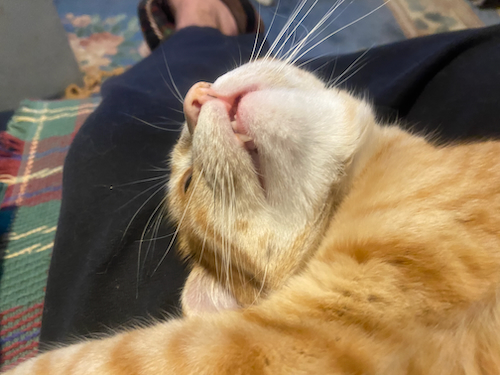
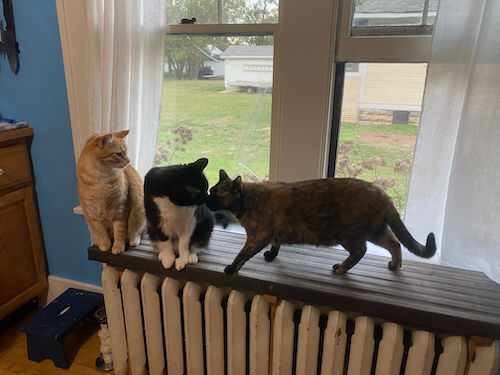

Recent comments